+255 763 058 584 +255 682 784 150 [email protected]


What Is Safari?
What Is Safari? Everything To Know About An African Safari : What does the word “safari“ means, and where did it originate? In what ways do safaris from the past differ from contemporary African adventures? For the finest experience, where should I go?
Safari is…
When we hear the word “safari“, we picture a group of travelers traveling over the savannah of Africa in pursuit of big wild animals like elephants, buffalo, rhinoceros, and lions. Images from the past typically depict guys wearing pointed helmets and brandishing firearms, while images from the present day show individuals driving SUVs and clutching long-lens cameras. It’s a literal quest for animals, or more accurately, a hunt for photos in the immensity of the hottest continent. Fashion experts might also recall straight-cut, beige-colored garments with a wide belt and a wide-brimmed hat, which were a holdover from the British military’s time spent in Britain’s colonies in Africa. These are all the first things that come to mind when we hear the lovely word “safari“, which has the sound of an Arabic given name.
Today’s safari is a sightseeing trip to a national park in Africa with the primary goal of seeing wildlife. Safaris used to be planned with the intention of hunting big game. The traditional Big Five of Africa—the elephant, lion, rhino, African buffalo, and leopard—are connected to the continent’s hunting customs. These five creatures were regarded by hunters as the most dangerous and challenging to hunt, and their body parts were the most sought-after trophy.
These days, the majority of people in modern society adore safari hunting. It is still allowed in a very small number of reserves, though. There are tight legal restrictions on this extremely costly hobby. Hence, the great majority of safaris offered nowadays take place in off-road vehicles traveling along paths marked by national parks, where visitors can see wild creatures, get up close or through binoculars, take pictures, and watch how they behave in their natural habitat.
The primary language of the people of East Africa is Swahili, from which the word “safari” is derived. This word translates to “journey, trip“and has its roots in the Arabic word “safar.“ In nations where Swahili is spoken, the phrase can apply to any kind of trip. The expression “safari njema!“ is even more widely used! It’s a desire for safe and enjoyable travel.
THE HISTORY OF AFRICAN SAFARIS
The early African colonial period, which lasted from the late 1800s to the early 1900s, is when the modern safari idea originated. The first European colonists and explorers brought with them the first safari-style trips. Many of them were specifically sent out to hunt animals, while others had the goal of exploring new areas.
A small army of local tribespeople hunted and laboriously dragged enormous animals overland on these early European-led excursions.
Subsequently, the idea gained popularity in the US when US President Teddy Roosevelt went on a large safari, purportedly to fill the Smithsonian Institute with African specimens. 11,400 animals, including 512 big game animals like elephants, lions, leopards, buffaloes, hippos, and rhinos, including six rare white rhinos at the time, were killed by the party’s rifles.
In the modern era, the majority of safaris in Africa no longer include hunting. Fortunately, hunting as a primitive activity is largely extinct. The great majority of Africa has long since evolved past this colonial-era practice, and it is no longer the standard.
WHAT KINDS OF SAFARIS ARE THERE?
In modern East Africa, a traditional safari is traveling across a national park’s vast breadth in an off-road vehicle with a driver-guide to see wild animals in their native environments. Herds of elephants, buffalo, zebras, and several species of antelope traverse the savannas and woods, accompanied by solitary or small-group giraffes. Monkeys and birds frequently live in the trees, and warthogs lurk in the bushes’ shadows. Lion prides and lone carnivores like cheetahs and leopards hunt large herbivores. Hyenas and jackals select smaller prey. To avoid the heat, crocodiles and hippos seek refuge in waterways. Safari travelers have a really special chance to witness all those breathtaking scenes that are alive with life.
What are the advantages of driving around a national park in a car? This enables you to witness a multitude of creatures of various kinds in a little over two to three hours. Additionally, rangers use radio-communication to alert safari car drivers to noteworthy sightings, such as a large pride of lions or a rhinoceros, allowing you to promptly make your way to the area to witness those creatures. The most common safari style is the off-road vehicle ride, although there are other options as well.
You can go on a safari on foot in some places when the safety situation allows. This is typically set up in places devoid of large herds grazing and where assaults by large animals are rare. An armed ranger goes with tourists for added security. Through safari walks, you can discover nature by coming into direct contact with it, study the local plant life, and get as close to the park’s natural environment as possible.
Roaring over the savannah in a hot-air balloon is one of the most breathtaking and unique safari experiences in Africa. This will ensure that everyone visiting a national park has an exciting time. As you soar into the sky in a hot air balloon, you’ll be able to take in the immensity of the landscapes below and experience the genuine sense of adventure that was immortalized in travelogues and books written before the industrial revolution. A contemporary aerial safari is an exclusive kind of entertainment that is more expensive than vintage vehicle trips but ensures incredible feelings and unique perspectives from the air. Adding a hot air balloon ride as a highlight to a standard game-drive safari is common.
Floating on the surface of lakes, rivers, or even the ocean is an amazing opportunity to experience Africa’s breathtaking natural surroundings from a different perspective. While cruising down a river in Tanzania, your guide will be regaling you with a variety of fascinating anecdotes about hippos and crocodiles. You will, of course, get to see those amazing creatures up close and personal! You can take a maritime safari to see several islands or take a boat excursion close to the mainland. Getting up close to dolphins and watching them play is one of the joys of a sea safari.
WHERE CAN YOU GO ON SAFARI?
East Africa’s Serengeti National Park is arguably the most well-known location for safari-tour enthusiasts. Many believe that the Safari-Craze originated in the spectacular Serengeti-Sceneries. It is situated in Tanzania’s north. This national park has a natural expansion known as Maasai Mara National Reserve in neighboring Kenya.
Nearby is the Ngorongoro Conservation Area , another renowned protected area. It has the largest ancient caldera in the world, which is an incredibly rare and beautiful sight. In his book “Serengeti Shall Not Die“, renowned naturalist Bernard Grzimek referred to it as a vast natural zoo. The “Big Five“ (elephant, lion, leopard, buffalo, and rhino) as well as massive migratory herds of herbivorous animals call it home. The animals appear to be enclosed by a kind of natural barrier due to the sheer walls of the caldera.
Amboseli and the Laikipia Plateau in Kenya, the Okavango Delta and Chobe National Park in Botswana, the Kruger National Park in South Africa, and Queen Elizabeth National Park in Uganda are a few additional noteworthy parks and protected areas in Africa. We should also bring up the well-known national parks of Victoria Falls National Park in Zimbabwe and Mosi-Oa-Tunya in Zambia. Despite their small size, the primary benefit of these two national parks is that they are both close to the breathtaking Victoria Falls. The iconic Mt. Kilimanjaro Volcano is another amazing location that can rival Victoria Falls in popularity. Its widespread recognition contributed to the rise in popularity of several lesser-known Tanzanian national parks , such as Arusha and Tarangire.

In other nations on the continent, there are numerous other noteworthy national parks. Beyond East Africa, safaris have long been popular. Furthermore, visits conducted in Asian national parks—mostly in India, Nepal, Bhutan, and Sri Lanka—are commonly referred to as safaris. For instance, the national parks of Kanha, Gir Forest, and Ranthambore are well-known in India. The latter is regarded as the source of inspiration for Rudyard Kipling’s “Jungle Book“, a tale about a youngster named Mowgli, who is raised by animals. In general, safari has gained international attention in recent years. It is a common term for any wilderness adventure, including a few that take place in Australia.
As early as the 1960s, “safari parks“ began to spring up across several nations. In essence, such are outdoor zoos, where animals reside in sizable, open spaces. These are areas that people might drive into or even walk into. These experimental “zoos“, where visitors could ride past wandering lions, appeared initially in the United States and later in Japan.
Longleat Safari and Adventure Park in England was the first complete safari park. Today, ostriches, giraffes, antelopes, zebras, and other animals—not just those indigenous to Africa—can be found in that well-known location. Today, there are a ton of these safari parks all over the world in the twenty-first century. Better locations, like Longleat, frequently make investments in conservation, rescue, and rehabilitation of animals, including some who live their entire lives in circuses, like the previously mentioned Anne the elephant. In fact, many parks are far worse than the natural world, and they will never be the same. Many people believe that contact zoos are unethical and bad for the animals, although the animals maintained there are kept in captivity and often kept in isolation.
Where safari first began, in Eastern Africa, is still home to authentic safari experiences devoid of animal abuse. Without humans trying to take them to other continents or interfere with their lives, animals can live and prosper in their natural habitat here. Tanzania has made significant strides in creating national parks and reserves with explicit guidelines for visitors, which helps to safeguard the breathtaking conservation areas of the nation. Tanzania is one of the greatest countries in Africa for safari tourism, if not the best, because of this and its exceptional biodiversity and natural beauty.
Tanzania, South Africa, and Kenya are the three African nations that rank in the top 10 if we search Instagram for hashtags and geotags containing the phrase “safari“ and then examine the statistics. First place goes to Victoria Falls National Park, where the magnificent waterfalls are the primary draw. However, with over 160.000 photos tagged, images from Serengeti National Park are the most Instagrammed among real safari locations. All things considered, Tanzania seems to be the undisputed leader in terms of wildlife safari experiences.
Tanzania offers a plethora of different tourist activities, along with active tourism development, good security, and plenty of other attractions to make your trip enjoyable, safe, and genuinely unforgettable. In addition to going on safari, you can explore or unwind on the beaches of Zanzibar and other islands, take tours to lakes, waterfalls, and other stunning natural locations, and learn about the customs and culture of the indigenous people in their villages. Additionally, you might visit the diving spots in the Indian Ocean off the shore to see underwater life for yourself. Of course, there are also trips to climb Mount Kilimanjaro. You can plan the ideal African vacation while still being in the same nation by mixing safaris with a range of other activities.
WELCOME TO THE BIRTHPLACE OF SAFARI—TANZANIA, EAST AFRICA.
Tanzania’s most well-known protected areas are found in the north, halfway between Mount Kilimanjaro and Lake Victoria. The Serengeti, Ngorongoro, Tarangire, Arusha, and Kilimanjaro National Park itself—whose primary draw is the park’s name, the highest point in Africa—have already been mentioned. In addition to the Kilimanjaro journey, the north of Tanzania can provide visitors with two additional worthwhile climbs: Ol Doinyo Lengai, a mountain revered by the indigenous tribes, and Meru volcano, the smaller brother of Kilimanjaro. Lake Manyara National Park and the three large lakes of Manyara, Eyasi, and Natron are among the other well-known locations in the area.
We have extensive experience planning nature trips in Tanzania and are well versed in the customs of the region’s safaris. Because of this, we can declare with confidence that this African nation offers far more amazing vacation choices than just the aforementioned, well-known national parks. Tanzania contains several national parks and reserves that are worth visiting, including those in the west, center, and south. Among the national parks and reserves, we should particularly mention Ruaha, Nyerere as part of the Selous, Katavi, Gombe Stream, and Mahale Mountains.
HOW MUCH TIME DOES GOING ON SAFARI TAKE?
A well-planned trip to Tanzania can guarantee you a fantastic safari experience in a few days, taking you to places like the Great Wildebeest Migration , the crater of Ngorongoro, the Tarangire wilderness, where elephant herds roam among baobab trees, the Great Ruaha River, which is home to numerous crocodiles and hippos, and the densely forested parks along Tanganyika’s coast, where chimpanzees have been studied for decades.
A nice safari excursion would require multiple days. It would be ideal if you could commit to your adventure for a few weeks or longer! Spending a few days in a major national park is highly recommended, and staying in lodges located directly on the park’s grounds is a wonderful experience. If so, you will be able to go on safari early in the morning and late in the evening, right before dusk. The animals are at their most animated and lively during these times. Since they aren’t compelled to idly seek cover from the intense light in the morning and evening, the most fascinating moments of animals interacting with one another occur during these times.
Tanzania’s amazing biodiversity of plants and animals makes for a wide range of experiences. Don’t pass up the possibility of spending more than two weeks on Safari if it presents itself. Theodore Roosevelt traveled to Africa for over a year, and Ernest Hemingway made two lengthy trips there. At this point, returning to Africa was my only goal. Even though we hadn’t left yet, I would lie awake at night and listen, longing to be back there. Ernest Hemingway, “Africa’s Green Hills“.
WHAT CAN YOU EXPECT FROM YOUR SAFARI TRIP IN TANZANIA?
A safari excursion consists of three components: transfers from the hotel to the national park, rest at one of the neighboring hotels, and safari vehicle drives. With careful planning, you may cut down on transfer time and free up more time for relaxation or enjoyment of the major events.
Generally speaking, it’s a good idea to spend three or even five days in the same park. In this manner, you can take advantage of all a park has to offer, including the noteworthy locations that hurried travelers frequently overlook.
We highly advise you to focus more on the exact features you’re looking for in your lodging when selecting a hotel than on the number of stars or interior design. The hotel’s location is a crucial component. Even when pitted against an opulent hotel in the closest town, a lodge situated within a national park typically prevails. Minimize the amount of time you spend traveling so that you can take in more of Tanzania’s breathtaking scenery. Being in the middle of a park early in the morning is an incredible opportunity! And these discrete incidents add up to the overall impression at the conclusion of the safari.
A perfect safari day would start with the visitors waking up early, getting a shower, and riding in a safari vehicle to the park while carrying their lunchboxes. In this manner, before dozens of other safari cars come, you can witness the morning predator hunt and numerous animals standing or lying down directly on the road or close. Soon after, guests are welcome to have breakfast al fresco at one of the park’s picnic areas. They return to the lodge for lunch after taking a few more rides around the park. It’s hot outside after lunch, so the visitors take a nap in the air-conditioned accommodations before returning for another safari in the afternoon. Once more, they witness a wide variety of animals, capture stunning images, and head back to the resort as night falls. They take pleasure in a delectable dinner, warm outdoor get-togethers, and a relaxing evening before turning in for the night.
WHEN IS THE BEST TIME TO GO ON SAFARI?
Tanzania is a remarkable country with multiple geographical areas and an equatorial location. This implies that you can visit this place any time of year, provided you don’t have any particular objectives, like witnessing the Great Migration, which occurs from June to August and involves antelopes forcing the Serengeti Rivers. However, you may see wildlife practically year-round in Tanzania, due to its environment and weather.
Let us reassure you if you are concerned about the rainy season: In Tanzania these days, the distinction between rainy and dry seasons is largely arbitrary. Rain, in any case, almost never keeps our guests from having a great safari experience. The so-called rainy season also offers a number of benefits, the most significant of which are reduced accommodation rates and the absence of visitor throngs on famous park routes.
Check out the safari programs offered by Focus East Africa Tours if you are eager to begin organizing your journey to the heart of Africa for a safari. Even though we provide a wide variety of tours, a personalized itinerary may be preferable. Simply get in touch with our management and request that they create a program that is best suited for you. A few quick articles with useful advice on what to pack for your vacation and how to be ready for a Tanzanian safari might also be beneficial. Tanzania has a lot to offer, so don’t be afraid to ask questions or request that your safari tour itinerary be expanded. Some of the best African safari destination to think about when planning your African safari tour includes:
Southern Africa Safari & Travel Highlights:
- Botswana Safari: Chobe Park, Okavango Delta, Moremi, Kalahari, and Makgadikgadi
- Namibia Safari: Etosha Park, Namib Desert, Swakopmund, Fish River Canyon, and Windhoek
- South Africa Safari: Kruger Park, Cape Town, Garden Route, Addo Elephant Park, and KwaZulu-Natal
- Zimbabwe Safari: Hwange Park, Victoria Falls, Matobo National Park, and Great Zimbabwe Ruins
- Zambia Safari: Victoria Falls, South Luangwa Park, Kafue National Park, and Livingstone
East African Safari & Travel Highlights:
- Tanzania Safari: Serengeti Park, Ngorongoro Crater, Kilimanjaro, Lake Manyara, Selous Reserve, and Zanzibar Islands
- Kenya Safari: Masai Mara, Amboseli Park, Lake Nakuru, Samburu Reserve, Tsavo National Park, and Lake Naivasha
- Uganda Safari: Bwindi National Park, Kibale Park, Murchison Falls, Jinja, and Queen Elizabeth National Park
- Madagascar Tours: Nosy Be Island, Andasibe Park, Montagne d’Ambre National Park, and Masoala Peninsula
- Malawi Safari: Lake Malawi, Dzalanyama Forest, Liwonde Park, and Nyika National Park
Too many African safari options? Get in touch with us for up-to-date advice from one of our African Safaris experts.


- South Africa
- The Ultimate Safari Planning Guide
- Safari Packing List
- Safari Luggage
- Safari Budget Guide
- Safari Reading List
- First-Timer’s Tips
- A Typical Day on Safari
Africa , Asia , Australia , Botswana , Canada , Europe , India , Kenya , North America , South Africa , Sri Lanka , UK
What is a safari.

When we think of safaris, we often picture vast open savannahs, majestic wild animals, and rugged four-wheel drive vehicles. But what exactly is a safari?
The word “safari” is derived from the Swahili word “safar,” which means journey or travel. Originally used by hunters, a safari now refers to a guided trip or expedition to observe and appreciate wildlife in their natural habitats. Safaris can take many forms, from walking safaris to hot air balloon safaris, and can be tailored to suit a variety of interests and budgets.
This blog post shares each of the different safaris available to wildlife lovers, in order to help you understand exactly what a safari is and the type that works best for you.
One of the most popular types of safari is the game drive safari. This involves travelling through a wildlife reserve or national park in a specially adapted vehicle, typically a four-wheel drive. These vehicles are designed to provide maximum visibility for passengers and can accommodate a range of group sizes. Game drives are led by experienced guides who are trained to spot wildlife and provide interesting facts and information about the animals and their behaviours.
Game drives are a quintessential part of a safari experience, offering an exciting and immersive way to explore the wilderness and witness wildlife up close. Riding in a specially designed safari vehicle with an experienced guide, participants can venture into national parks, game reserves, or other remote areas to search for a diverse array of wildlife. Game drives offer the opportunity to encounter iconic species like lions, elephants, giraffes, and more, in their natural habitats.
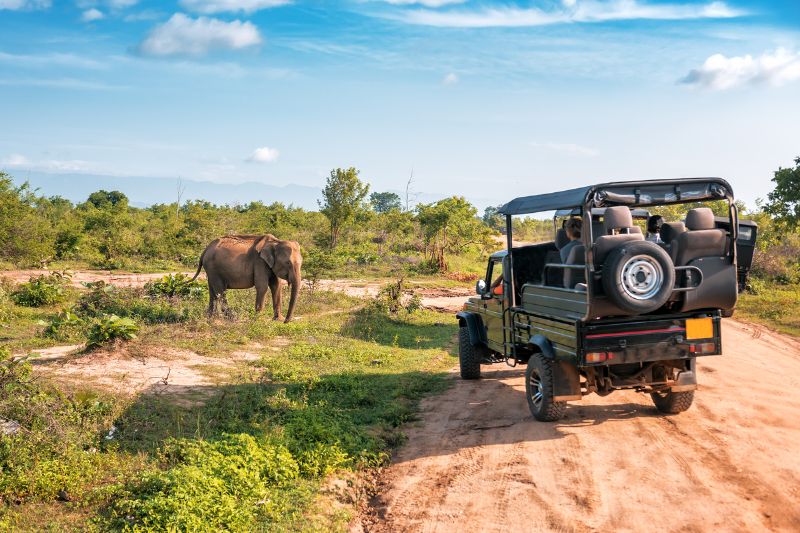
With keen eyes and deep knowledge of the area, guides can track and interpret animal behaviour, providing fascinating insights into the natural world. Game drives also offer the chance to witness the breathtaking beauty of the landscape, from sweeping savannahs to lush forests, and capture stunning photographs of the wild scenery. The thrill of the chase, the anticipation of a wildlife sighting, and the raw connection with nature make game drives an exhilarating and unforgettable safari experience.
Walking Safari
Walking safaris offer an unparalleled opportunity to intimately explore and connect with the natural world. Instead of observing wildlife from a vehicle, walking safaris allow travellers to step into the wild and experience the sights, sounds, and scents of the wilderness up close. Led by experienced and knowledgeable guides, walkers can learn about the intricacies of the ecosystem, from identifying animal tracks and signs to understanding the complex relationships between different species.
These safaris typically take place in smaller groups and are led by a guide who is well-versed in the local flora and fauna. Walking safaris can be tailored to suit different fitness levels, and participants can expect to encounter a variety of wildlife, from insects and birds to larger mammals such as elephants and lions.

Walking safaris also provide a deeper cultural immersion, as participants can interact with local communities and gain insights into their way of life. With every step, walkers can encounter unexpected moments of wonder, from spotting a hidden bird’s nest to encountering a herd of elephants at a waterhole. Walking safaris offer a truly authentic and immersive experience, allowing travellers to appreciate the beauty and diversity of nature in a more intimate and mindful way.
Hot Air Balloon Safari
For those looking for a truly unique experience, a hot air balloon safari may be just the thing. These safaris offer a bird’s-eye view of the landscape and wildlife below, providing a different perspective than a ground-based safari.
Hot air balloon safaris are typically conducted early in the morning when the air is calm and the wildlife is most active. As the balloon gently glides through the sky, adventurers can marvel at panoramic views of vast savannahs, rolling hills, or serene landscapes below. The elevated vantage point provides an unparalleled opportunity to capture breathtaking aerial photographs and witness the beauty of the wilderness from a completely different angle. The serene and peaceful experience of floating in a hot air balloon allows for a tranquil and immersive encounter with nature, devoid of the noise and disturbance of vehicles.

Wildlife sightings from the balloon are often unexpected and awe-inspiring, with the chance to spot animals from a distance without disturbing their natural behaviour. Hot air balloon safaris provide an unforgettable adventure that combines the thrill of soaring through the sky with the unparalleled beauty of the natural world, creating memories that will last a lifetime.
Photography Safari
Photography safaris offer a thrilling and immersive experience for nature and wildlife enthusiasts who want to capture the beauty of the natural world through their lenses. Embarking on a photography safari allows photographers to venture into stunning landscapes and remote wilderness areas, where they can capture unique and awe-inspiring shots of wildlife, landscapes, and cultural elements. With the guidance of expert wildlife guides and professional photographers, participants can learn valuable photography techniques, such as composition, lighting, and wildlife behaviour, to enhance their skills and capture stunning images.
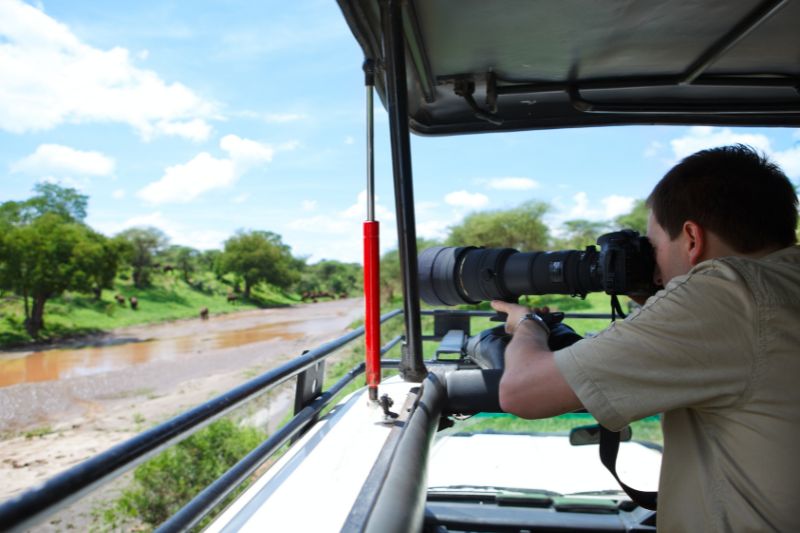
Photography safaris also provide opportunities to observe and photograph rare and elusive species in their natural habitats, creating unforgettable memories and remarkable photographs. Whether it’s tracking lions on the African savannah, photographing polar bears in the Arctic, or capturing the vibrant colours of a tropical rainforest, a photography safari is an extraordinary adventure that combines the thrill of wildlife encounters with the art of photography.
Boat Safari
Boat safaris offer a unique and immersive way to explore the diverse ecosystems and wildlife of rivers, lakes, and waterways. Cruising on a boat allows participants to access remote and untouched areas that may not be reachable by land, providing a different perspective and vantage point for wildlife viewing.
Boats make it possible to spot a wide range of wildlife, such as crocodiles, hippos, water birds, and even elephants and other animals that come to the water’s edge to drink. Guides with specialised knowledge about the local flora and fauna can provide insights and interesting facts about the ecosystem and its inhabitants. The tranquil rhythm of the boat and the serene surroundings create a calming and peaceful experience, perfect for enjoying the beauty of nature and capturing stunning photographs.
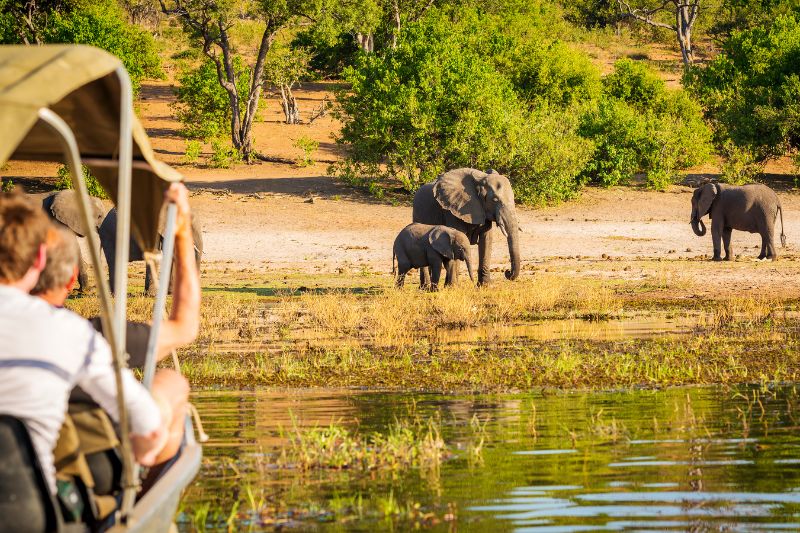
Whether it’s gliding through the winding channels of the Okavango Delta, exploring the mighty Amazon River, or cruising along the serene backwaters of Kerala, boat safaris offer a unique and unforgettable adventure for wildlife and nature enthusiasts alike.
No matter what type of safari you choose, it’s important to remember that these experiences are about more than just seeing animals. They are an opportunity to connect with nature, appreciate the beauty and diversity of our planet, and learn about the importance of conservation and sustainability.
Whether you’re a seasoned traveller or a first-time adventurer, a safari is an experience you won’t soon forget.
Anna is the founder of Really Wildlife. She's a 30-something lover of wildlife travel, vegetables and listening to the Lion King soundtrack on full blast.
National Geographic content straight to your inbox—sign up for our popular newsletters here

Everything you need to know before booking your first African safari
For many, a safari represents the optimal escape and lifelong travel dream. If you’re going to invest in turning this dream into reality, there are some things worth considering. Plus, we recommend five incredible wildlife itineraries for 2023.
From the first waft of dewy morning air to the gentle owl hoots that drift into camp after dark, there’s a satisfying natural rhythm to a day on safari in Africa. Even if you’re not normally an early riser, you’ll quickly fall into the routine of pre-dawn starts, lazy lunchtimes, active afternoons and mellow evenings, making the most of the best hours both for wildlife-watching and for chilling out. Deep at night, if you’re lucky, you may hear the distant whoop of a hyena, the rasping call of a leopard or the bassy roar of a lion.
But more often than not, you’ll sleep soundly, drunk on fresh air. Soon after you wake, you’ll head out into the wild, eager to discover what the day will deliver. Perhaps you’ll find yourself inching up on some rhinos, watching boisterous elephants bathe in a waterhole or spotting the youngest, cutest members of a mighty big cat dynasty.
If this sounds like the kind of escape you’ve been craving, but you’re puzzling over possible itineraries, what’s the best way to choose?
Green means go
While every luxury safari offers unforgettable wildlife encounters, there are plenty of options to consider. High-end African trips and settings vary hugely in their atmosphere and style.
Some itineraries, for example, are much greener than others. If you’re passionate about nature, you’ll want to make ethical choices, mindful of climate change and biodiversity, perhaps by minimising your time in the air. While every long-haul trip has a high carbon footprint, you can limit your safari’s impact by choosing a destination near an international airport and sharing a vehicle rather than continuing by taking domestic flights.
With superb wildlife-watching opportunities within driving distance, Nairobi makes an excellent starting point for a low-airmiles luxury safari. “You could head for the stunning mountains and waterfalls of the Aberdare range, where lions hunt giant forest hogs”, says Kenya specialist Richard Trillo of Expert Africa. “The tree-dotted plains of the Maasai Mara, which host East Africa’s annual Great Migration, are also within reach,” Richard adds.
There are other ways to dial down the net impact of your trip without compromising on quality, however. While carbon offset schemes can help compensate for your emissions, for a more targeted approach, you could book your trip through a specialist safari operator that has established working partnerships with African conservation charities.
“We’re proud to support South Africa’s all-female Black Mamba Anti-Poaching Unit, and Greenpop, a non-profit Sub-Saharan forest restoration and urban greening organisation,” says Marcelo Novais of luxury operator Ker and Downey Africa.
“We give all our clients the opportunity to donate to these worthy causes, since leaving a positive legacy is one of our core values,” he adds. Other deserving organisations include African Parks, the African Wildlife Foundation, Tusk and the World Land Trust.
Another effective way of maximising the benefits of your trip is to choose lodges that go the extra mile in their vicinity, doing more for environmental protection, community partnerships and rural development than merely covering park fees and basic wages. In Tanzania, the Elewana Arusha Coffee Lodge invites guests to visit the craft project they support, Shanga, where locals with disabilities upcycle glass, textiles and fishing wire into cute elephant cushions, jewellery and clothing.
When it comes to shortlisting properties, membership of Ecotourism Kenya, Responsible Tourism Tanzania, Fair Trade Tourism and the Global Sustainable Tourism Council are generally useful indicators.
Settling in
Once you’ve arrived in the bush, what will your surroundings feel like? Anyone who’s cautious about camping in the wilderness will be relieved to discover that most top-end operators put their guests at ease by focusing on creature comforts: cool drinks, gourmet dining, indulgently appointed private bathrooms and sumptuous beds, for example. As a rule, their staff — from the head guide to the housekeepers — are superb at their jobs.
That said, there are significant differences between, on the one hand, intimate, minimalist camps with just a handful of canvas tents and, at the other extreme, sizeable lodges featuring swimming pools, gyms and perhaps even a spa, photography hide, editing suite, research centre, library and observatory. It’s a matter of weighing up how close to nature you’d like to feel — hearing all those thrilling sounds in the night, for example — against the range of facilities and creature comforts you’d like to enjoy.
When deciding, honest opinions from people who know the properties well can be invaluable. “Our safari specialists always have detailed conversations with our clients to understand their preferences and offer advice”, says Liberty Gilmour of Audley Travel. “Conventional aircon, for example, is rarely essential: Zambia in May and high-altitude destinations such as Ngorongoro can be quite cool, particularly at night. If it’s hot, natural ventilation may be sufficient, but many camps also have solar-powered cooling systems.”
Whether opulent, nostalgic or quirky, surroundings that suit your aesthetic aspirations can elevate your experience. The family heirlooms that decorate Camp Jabulani in South Africa’s Kapama Reserve, for example, create a uniquely cosy atmosphere, while Xigera Safari Lodge in Botswana’s Okavango Delta is so proud of its collection of original pieces by contemporary African artists and artisans that staff offer art and design tours of the premises. To strike a contemporary note, Loisaba Lodo Springs in Kenya’s Loisaba Conservancy has rooms dotted with hand-stitched West African textiles and elegant upcycled Edwardian furniture.

Peaceful days
Almost every safari programme revolves around guided excursions called game drives, a name dating back to the days of Big Five hunting trips, but the style of the vehicles you ride in isn’t discussed as much as perhaps it should be. While some outfits settle for basic open-sided 4x4s, others invest in supremely comfortable, easy-access vehicles with charging points, dustproof storage space and a fridge. If you’re a keen photographer, top quality private vehicles are a must. Electric safari vehicles offer a particularly smooth ride; while still rare, they’re the future, and are starting to catch on.
Ila Safari Lodge in Zambia’s Kafue National Park offers the rare luxury of total peace and quiet. Founder Vincent Kouwenhoven, who has pioneered electric transport at Ila and its sister lodges in Zambia and Malawi, explains: “Our love for Africa led us to develop technologies that enable guests to experience the bush in near-silent, pollution-free vehicles, charged by our own solar panels. It’s an ecologically conscious way to watch wildlife and very calming, too. Instead of the engine, you hear birdsong.”
Some safaris also promise near-solitude in a vast natural landscape — an intoxicating feeling. One way to dodge the crowds is to travel during low season, the dates of which vary from location to location; alternatively, you could choose private reserves where the only vehicles you’ll see will be those of your fellow guests. As well as providing daytime activities, guides may offer night drives, using spotlights to search for nocturnal activity, such as birds roosting or lions stalking their prey.
For the ultimate in exclusivity, it’s possible to book an entire camp or lodge, with the staff handcrafting everything to your precise specifications, from wake-up times to the cocktails and canapes. According to Ash Jarvis of Best of South Africa Travel, exclusive-use properties work particularly well for mixed-generation families: “With their private game drives, multiple living areas, private pool and the undivided attention of the whole staff, including the chefs (fussy eaters welcome), they eliminate stress and ensure that nobody has to compromise. That’s what good family holidays are all about.”
The ultimate adventure
If serenity is your scene, you may be dreaming of floating over herds of zebras and wildebeest in a hot-air balloon, or wandering across the savannah on a bushwalk or cycle ride. The most interesting safaris offer a mixed programme of imaginative guided activities such as these, enlivening the days with little surprises: picnics in beauty spots, perhaps, or lantern-lit barbecues.
The possibilities depend, to a large extent, on your choice of location. In Kenya’s northern conservancies, for example, you could explore the semi-desert by camel, while in Rwanda or Uganda, the activity you probably won’t want to miss is venturing into the depths of the rainforest on foot for a precious one-hour audience with mountain gorillas.
On a gorilla trek, you’ll be guided by rangers at the top of their game — a hallmark of an excellent safari. A knowledgeable, communicative guide can transform any trip, keeping you safe, entertained and intrigued.
“The inside track is what you really want, whether that’s in guiding, photography or conservation”, says Will Bolsover of Natural World Safaris. “In-depth knowledge leads you beneath the surface, for true insights into how conservation works, how wildlife benefits and how you can contribute.”
Since quality time with experts is one of the ultimate luxuries you can enjoy on safari, some top-end safaris, particularly in Kenya and South Africa, include a philanthropic element, whereby in exchange for a substantial donation to a conservation fund, you gain access to specialists in the field, perhaps even helping collar predators or collecting DNA samples from juvenile rhinos. Conservation safari companies such as Great Plains and AWF Safaris can assist with this. There’s no better way to start unlocking the mysteries of the African wilderness.

Five luxury safari trips in Africa to try in 2023 and beyond
1. low-carbon luxury in kenya.
After a night at Nairobi’s fabled Giraffe Manor, travel overland to Solio Lodge in the Central Highlands to explore Kenya’s oldest rhino conservation sanctuary, then continue to Sala’s Camp, in one of the least-visited corners of the Maasai Mara. Eight days from £8,400 with Expert Africa. expertafrica.com
2. Take to the skies in Tanzania
Flip from park to park in style on a SkySafari, travelling by private plane and touching down at luxurious Elewana Collection properties. This classic circuit takes in Arusha, Tarangire, Ngorongoro and the Serengeti, for blockbuster wildlife-watching. Ten days from £8,300 with Sky Safari. skysafari.com
3. Family adventures in South Africa
South Africa has a host of prospects to suit muti-generational families. Delightful safari properties such as Morukuru River House team well with Cape Town, the Cape Winelands and the Garden Route. Fourteen days from £4,500 with Best of South Africa Travel. bestofsouthafricatravel.com
4. Clock the Big Five in the safari heartlands
To experience some of southern Africa’s most exclusive wilderness retreats, string together Bushmans Kloof in South Africa’s Cederberg region, Sossusvlei Desert Lodge in Namibia, DumaTau in Linyanti and Xigera in the Okavango Delta. Twelve days from £24,797 with Beyond Green. staybeyondgreen.com
5. Meet mountain gorillas in Rwanda
Nothing can prepare you for the surge of emotions you’ll feel when, after an exhilarating trek, you first encounter a family of gorillas in the rainforest. Combine your hike with game drives in Rwanda’s Big Five national park, Akagera. Eight days from £7,493 with Jacada Travel. jacadatravel.com
Published in the 2022 edition of National Geographic Traveller (UK) The Luxury Collection
Follow us on social media
Facebook | Twitter | Instagram
Related Topics
- ADVENTURE TRAVEL
You May Also Like

Affordable gorilla encounters in Uganda's Bwindi Impenetrable Forest

How I got the shot: Ben Pipe on coming face to face with a lion
Free bonus issue.

Free roam safari: a self-guided campervanning trip through South Africa & Eswatini

5 game drive alternatives, from cycling to horse-riding

Are South Africa’s captive lions inbred?

Who buys lion bones? Inside South Africa’s skeleton trade

4 incredible places in urgent need of conservation
- Environment
- Perpetual Planet
History & Culture
- History & Culture
- History Magazine
- Mind, Body, Wonder
- Paid Content
- Terms of Use
- Privacy Policy
- Your US State Privacy Rights
- Children's Online Privacy Policy
- Interest-Based Ads
- About Nielsen Measurement
- Do Not Sell or Share My Personal Information
- Nat Geo Home
- Attend a Live Event
- Book a Trip
- Inspire Your Kids
- Shop Nat Geo
- Visit the D.C. Museum
- Learn About Our Impact
- Support Our Mission
- Advertise With Us
- Customer Service
- Renew Subscription
- Manage Your Subscription
- Work at Nat Geo
- Sign Up for Our Newsletters
- Contribute to Protect the Planet
Copyright © 1996-2015 National Geographic Society Copyright © 2015-2024 National Geographic Partners, LLC. All rights reserved
- More from M-W
- To save this word, you'll need to log in. Log In
Definition of safari
Examples of safari in a sentence.
These examples are programmatically compiled from various online sources to illustrate current usage of the word 'safari.' Any opinions expressed in the examples do not represent those of Merriam-Webster or its editors. Send us feedback about these examples.
Word History
Swahili, journey, from Arabic safarī of a journey
1859, in the meaning defined at sense 1
Phrases Containing safari
- safari jacket
- safari park
- safari suit
Dictionary Entries Near safari
Cite this entry.
“Safari.” Merriam-Webster.com Dictionary , Merriam-Webster, https://www.merriam-webster.com/dictionary/safari. Accessed 26 Apr. 2024.
Kids Definition
Kids definition of safari, more from merriam-webster on safari.
Thesaurus: All synonyms and antonyms for safari
Nglish: Translation of safari for Spanish Speakers
Britannica.com: Encyclopedia article about safari
Subscribe to America's largest dictionary and get thousands more definitions and advanced search—ad free!

Can you solve 4 words at once?
Word of the day.
See Definitions and Examples »
Get Word of the Day daily email!
Popular in Grammar & Usage
More commonly misspelled words, commonly misspelled words, how to use em dashes (—), en dashes (–) , and hyphens (-), absent letters that are heard anyway, how to use accents and diacritical marks, popular in wordplay, the words of the week - apr. 26, 9 superb owl words, 'gaslighting,' 'woke,' 'democracy,' and other top lookups, 10 words for lesser-known games and sports, your favorite band is in the dictionary, games & quizzes.

Home / What is a Safari? Everything you need to know
What is a Safari? Everything you need to know
Many tourists who are not familiar with africa ask the question – what is a safari .
A SAFARI is an exciting and adventurous way of seeing the ‘real Africa’ because it enables you to view a variety of wildlife in their natural habitat. As a result, going on a safari gives you an authentic experience of Africa.
Safaris can involve walking through the wilderness, driving in 4×4 vehicles or by flying in light air craft. The purpose of a safari tour is to allow you to get intimate with the landscape and scenery.
While overland tours are mostly challenging, you need to be young at heart and open-minded to get the best out of an overland safari trip. All safari vehicles are custom-built to travel to remote parts of Africa often on long, bumpy roads, while allowing you to view wildlife from a safe distance in comfort.
Why go on a Safari?
- Slow down and get in touch with the earth
- Experience wildlife in their natural environment
- Engage with local cultures and learn about their traditions
- Take part in adventurous outdoor activities
The accommodation on safaris vary depending on your trip. Anything from basic two man tents through to tented camps and luxury lodges with en suite bathrooms. Certainly there is something to suit everyone!

What types of Safari Trips can you go on?
The term SAFARI is a type of experience where you have the opportunity to observe and photograph wildlife. An African safari in an overland truck is an adventure with lots of sightseeing and activities. Specialist forms of safaris cater for a variety of needs and budgets.
Some examples include migratory safaris, birding, medical safaris, hiking, culinary, family, horse back and photographic safaris. A safari tour can range is length from a couple of days to longer overland trips . While the longer safari tours traverse over numerous countries and include 1-2 months of travel.
Let travellers Konrad and Brooke tell you all about an Overland Tour in Africa:
What is a Camping Overland Safari Trip?
A camping overland safari is for travelers who want a hands-on experience of Mother Nature. Either setting up your campsite or helping build a campfire whilst surrounded by breathtaking landscapes and scenery. During an African camping safari you will stay in large dome canvas tents which are spacious enough for two adults and your luggage.
Most camping safaris include a sleeping mat and you only need to bring your own sleeping bag, pillow and towel. The African campsites are basic and comfortable. Most have warm showers and flushing ablutions, while others may have natural ablutions.
What are Accommodated or Comfort Overland Safari Trip?
Accommodated safaris are designed for travelers who prefer extra comforts. Most importantly, it is comfort without the price tag! Our accommodated safaris make use of a combination of lodges, hostels, bungalows, chalets, permanent safari camps, hotels and traditional huts.
Our properties are ideally located at each destination for an authentic experience with incredible views. The standard of the properties varies along the trip. While Southern Africa properties are much more established than the East Africa accommodation. They vary from basic comfortable accommodation to breathtaking properties.
What is a Lodge Safari Tour?
Lodge safaris allow travelers to access wildlife over a shorter period of time. Therefore the lodges are located close to the wildlife and allow you more comfort. Most lodges can be accessed by air or by land transfers thus allowing you to maximize your time and experience. Also the quality of lodges vary for budgets and level of comfort.
What is a Mobile Tented Safari Tour?
Mobile tented Safaris are designed to allow for less impact on the environment. Tents are set up for your accommodation and then dismantled when you leave to ensure only footprints are left behind. Guides will drive the support vehicles ahead of the travelers and set up the camp. As a result the entire camp is all set up before your arrival.
By the time you arrive all you have to do is unpack, sit back relax and wait for dinner to be served. You will sleep on stretcher beds with a sleeping bag and a pillow provided. Bucket showers are provided with heated water for you to freshen up.
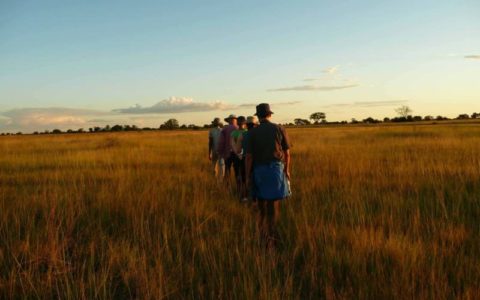
R 163,450
Cape Town to Nairobi Tour (Comfort) (42 Days)
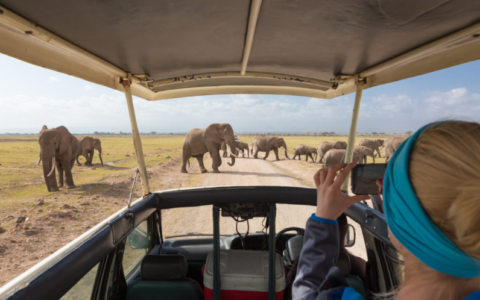
R 102,355
+ Local Payment USD 1185 (Jan - June) - USD 1365 (Jul - Dec)
East Africa Migration Safari – 15 Days
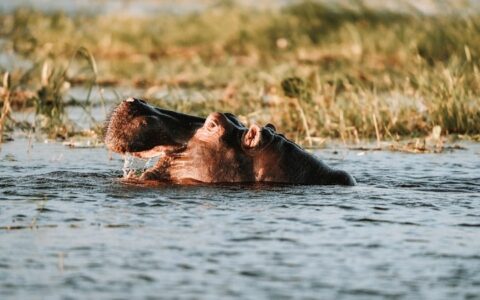
R 42,285
11 Day Botswana Adventure Semi Camping Tour
Luxury tented camps.
Some of the camps are luxury camps which are spacious tents with beds and crisp good quality linen. Resident chefs will prepare all your meals and there is a designated guide to organise and maintain the campsite.
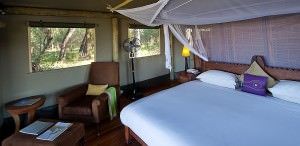
There are a few permanent tented camps which are erected seasonally in wildlife-dense areas for the best game viewing experience. Once the season is over these tents are dismantled and moved to another area for optimum game viewing.
What is a typical day on a Safari Trip?
Early mornings are frequent so that you can enjoy a hot beverage and a light breakfast before heading out on a game drive. The mornings can be crisp and cold while refreshing, with the reward of watching nature awaken.
The morning game drives can be between 2 to 3 hours long. Allowing you plenty of time to explore the area before returning to the campsite for lunch or enjoying a picnic in the bush. You might go on another game drive in the afternoon or take part in an activity such as canoeing, birdwatching or white water rafting.
Dinner will be prepared for you to sit back, relax and chat to your fellow companions over sundowners while a crackling fire is ready to keep the chill off. Early nights are usually encouraged so that you wake up refreshed and ready for a another adventurous safari.
When is the best time to go on a Safari Tour?
The Winter months of June to October offer the best game viewing throughout East and Southern Africa. The best wildlife viewing is when the herds of game graze on the dry Savannah during the day. Whilst watering holes and riverbeds are the main attraction at sunset.
Winter is also the best time to see and experience the wildebeest migration in the Masai Mara Game Reserve. The migration is definitely one of Africa’s greatest phenomena and well worth the trip.
It is ideal for a beach vacation on the East coast of Africa with moderate daily temperatures. Naturally these conditions are perfect to soak up the sun.
In the Summer months of November to March the bush transforms with lush green vegetation. The African sky offers up a dramatic backdrop of dark thunderstorm clouds. It is therefore the ideal playing field for energetic young grazers, with intensified predator action. Also the most popular season for birding enthusiasts with big flocks of migratory birds returning south.
Get a feel for what a Overland Safari in Africa is like from Cape Town to Victoria Falls:
Nonsense – Africa from Little Bear Films on Vimeo . Filmed while travelling on Cape to Vic Falls Tour
Is East Africa Safari or Southern Africa Safari better?
The big question when people consider a safari holiday in Africa is where is a safari tour possible and how to choose between East Africa and Southern Africa .
Southern Africa includes the countries of South Africa , Botswana , Zambia, Zimbabwe , Namibia , Malawi and Mozambique. While East Africa includes the countries of Kenya , Tanzania , Uganda and Rwanda. These are the two main regions for safari holidays in Africa. Each region offers different landscapes, wildlife experiences and attractions.
Therefore lets dive into the pros and cons of a safari in each region to help you decide on your African safari tour .
East Africa Safari

The East African Landscape
When people think of images of an African safari, they usually have scenes from an East African safari in mind. Countless nature documentaries are set on the vast savanna of Kenya and Tanzania. These two countries boast postcard-perfect landscapes of rolling savanna dotted with acacia trees and are home to the wildebeest migration . The annual migration of millions of animals that takes place between the Masai Mara and the Serengeti . This is truly one of the greatest wildlife spectacles on Earth.
Both East Africa tours and Southern Africa tours have the Big Five wildlife and an amazing diversity of other animals. However East Africa has a higher concentration of game than in Southern Africa. Wildlife are also easier to spot on the open savanna plains. Due to East African national parks not being fenced the wildlife move freely in their migratory patterns.
Here’s a taste of an African Safari in the Ngorongoro Crater of Tanzania:
The East African Wildlife Safari
While Kenya and Tanzania are the top countries in East Africa Wildlife Safari tours, Uganda and Rwanda have their own attractions as they are known for wild mountain gorillas. Along with the Democratic Republic of Congo, Uganda and Rwanda are the only places where you can see mountain gorillas in their natural habitat.
Tracking mountain gorillas is thrilling and hugely rewarding. Undoubtedly a bucket-list wildlife experience to try and tick off your ever growing list. The experience of coming face to face with a huge silver-back gorilla is truly unforgettable! You can also go chimpanzee tracking in Uganda and Rwanda, which doesn’t get you as close as you do to the gorillas, but it’s still an amazing wildlife encounter.
Another main attraction of a safari tour in East Africa is a hike up Africa’s highest mountain in Tanzania, Mount Kilimanjaro . Tanzania and Kenya have beautiful coastlines and idyllic islands for some relaxing beach time, snorkelling and diving.
A few downsides of east African safaris are the number of vehicles at sightings in the popular parks, such as the Masai Mara and the Serengeti . With no limit to the number of cars, you will likely be sharing the view with 10 other vehicles.
Ready to plan an East Africa tour?
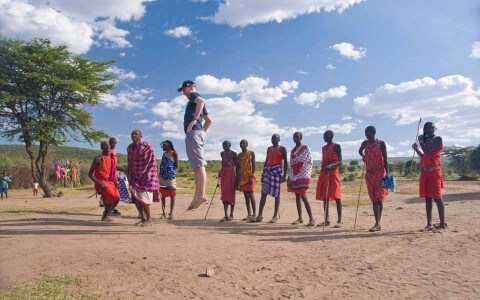
R 75,100
13 Day East Africa Game Parks and Zanzibar Safari
Southern africa safari.
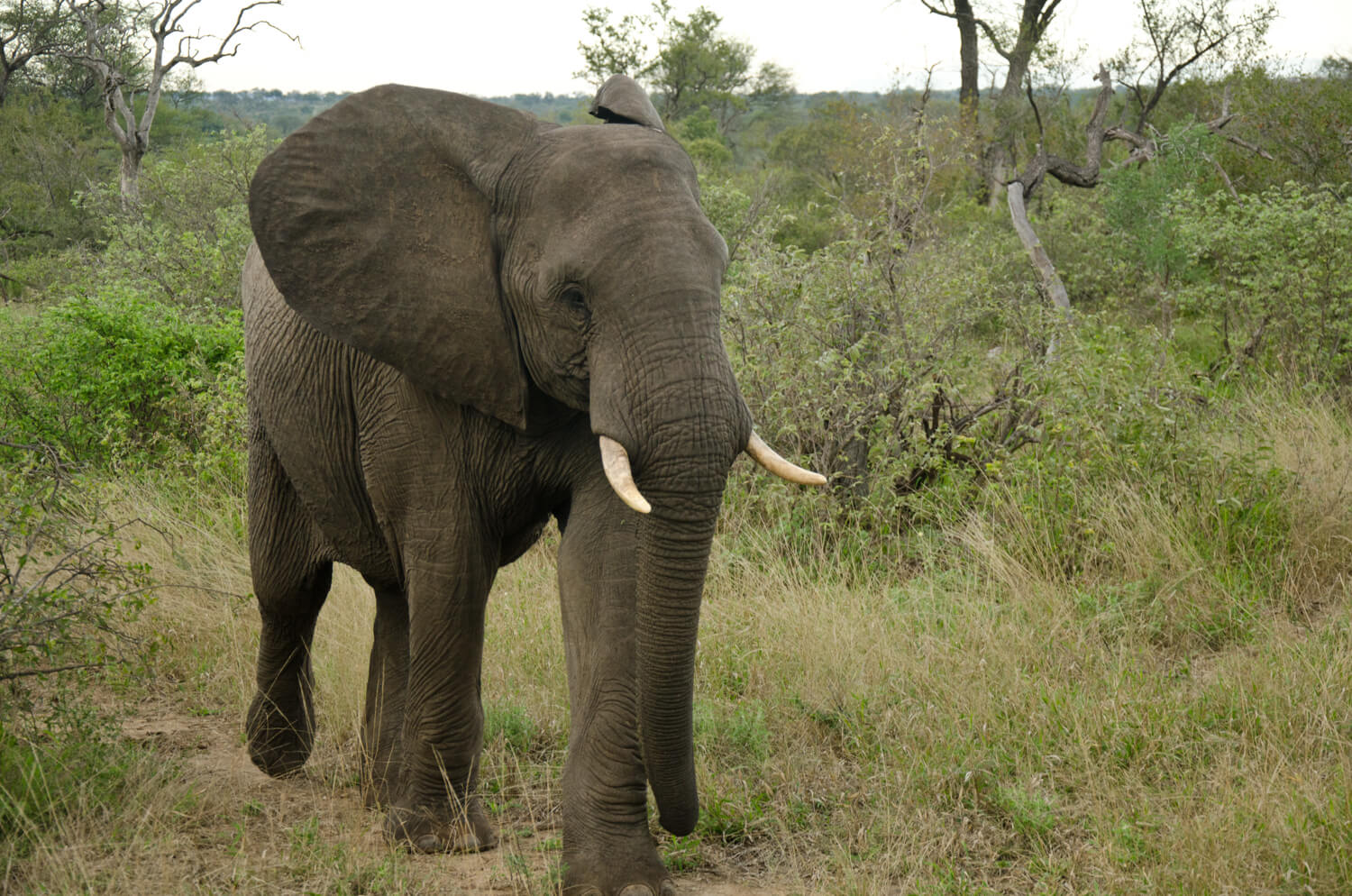
The Southern African Landscape
While Southern Africa doesn’t have the same concentration of wildlife as East Africa, it offers greater diversity of landscapes. Southern Africa highlights include the vast wetland of the Okavango Delta in Botswana as well as the beautiful Kalahari Desert in Botswana and South Africa. In addition, the tallest sand dunes in the world in the Namib Desert in Namibia and Africa’s largest waterfall, Victoria Falls , which straddles Zambia and Zimbabwe.
No forgetting Mozambique ’s long and beautiful coastline with its beautiful palm lined archipelagos. Mozambique safaris are popular for their picturesque scenery and rich cultural experiences.
With incredibly varied landscapes and climates, South Africa is the most popular safari destination in southern Africa for good reason. Not forgetting an amazing Big Five safari holiday visiting the country’s flagship park, Kruger National Park allows you to experience a wide diversity in a short time. Certainly South Africa offers so much from city sightseeing in beautiful Cape Town to a beach holiday on the Garden Route. Mountaineering in the Drakensberg or wine tasting in the Cape Winelands are also popular attractions.
The Southern African Wildlife
Apart from Etosha National Park in Namibia , many of the national parks and reserves in Southern Africa have dense bushveld unlike in East Africa, making game viewing a little bit more challenging. An advantage is you can often get much closer to the wildlife in Southern Africa. Therefore you’ll get to see those elephants or lions up close.
Private reserves or concessions in Southern Africa have strict rules about how many vehicles can be at a viewing. This means that you get more of an intimate experience at a sighting than you might do in East Africa.
If you’re looking for a malaria-free safari destination then east Africa is unfortunately not an option. Africa’s only malaria-free safaris are in South Africa and Namibia (here is our list of the best malaria-free safaris in southern Africa ).
Inspired to go on a Safari Tour in Southern Africa?
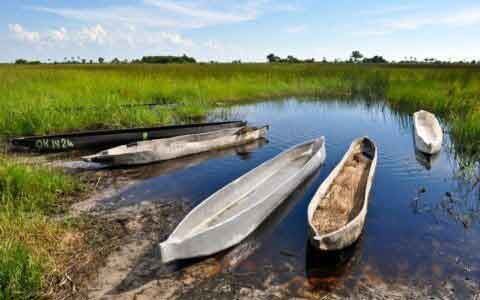
R 105,200
Cape To Cape Southern Explorer Overland (41 Days)
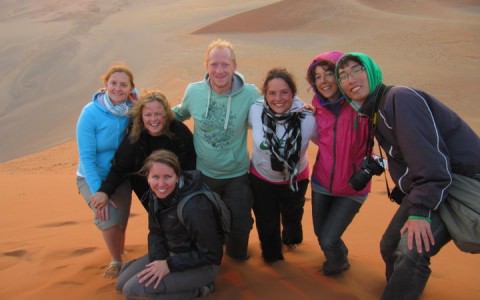
R 78,900
Southern Africa Adventure (25 Days)
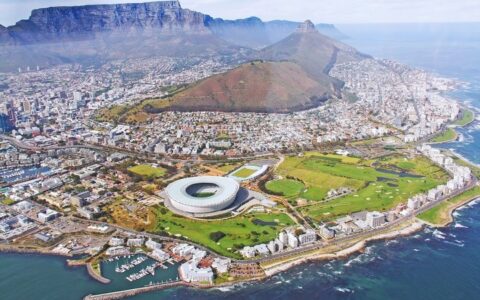
R 80,700 R 68,595
Cape Town to Victoria Falls Tour (Comfort) *Most Booked Trip*
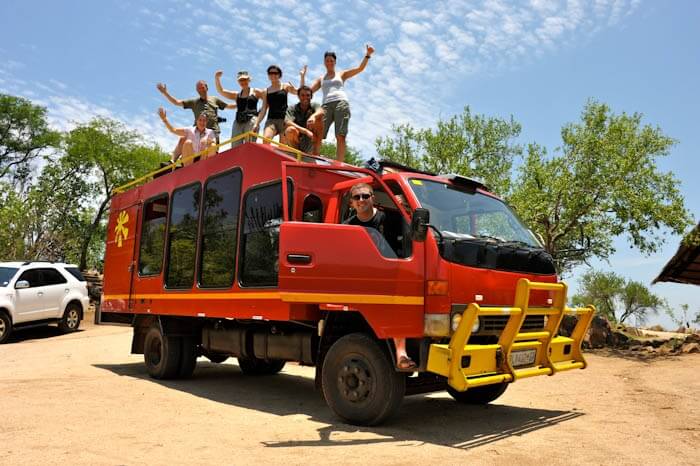
If you can’t possibly choose between East Africa and Southern Africa for a safari tour then explore both regions on one of our long overlanding tours ?
Our 55 day Nairobi to Cape Town overlanding tour starts in Kenya and takes you through Uganda, Tanzania, Malawi, Zambia, Zimbabwe, Botswana and Namibia before coming to an end in Cape Town, South Africa. Along the way you will visit most of the best national parks and reserves in both East and Southern Africa.

Some of the best Safari tours travelling to Africa:
- Cape Town Tours
- Johannesburg Tours
- Nairobi Tours
- Victoria Falls Tours
- Zanzibar Tours
- Swakopmund Tours
- Garden Route Tours
- Southern Africa Tours
Our Top Safari Game Reserves:
- Kruger Park Safaris
- Etosha Safaris
- Chobe Safaris
- Okavango Delta Safaris
- Serengeti Safaris
- Masai Mara Safaris
- Ngorongoro Crater Safaris
- Moremi Safaris
Choose Safari tours by Country:
- Namibia Safaris
- Uganda Safaris
- Mozambique Safaris
- Zimbabwe Safaris
- Kenya Safaris
- Tanzania Safaris
- Malawi Safaris
- Lesotho Safaris
Search by length of Safari Tours:
- 1 – 7 Days Tours
- 8 – 14 Days Tours
- 15 – 25 Days Tours
- 26 – 40 Days Tours
- 41 + Days Tours
Enquire Now
- Hidden Tour Title Hidden
- Hidden Tour Length Hidden
- Hidden Tour URL Hidden
- Hidden Tour Price Hidden
- Hidden Tour Style Hidden
- Hidden Compared Tours Hidden URLs
- Your name * First Last
- Your email address *
- Hidden Alternative Email (deprecated)
- The tour you're intested in
- The tours you're interested in Please do not edit these tour names so we can assist you with your choices.
Please enter your number below.
- When would you like to travel? Apr 2024 May 2024 Jun 2024 July 2024 Aug 2024 Sep 2024 Oct 2024 Nov 2024 Dec 2024 Jan 2025 Feb 2025 Mar 2025 Apr 2025 May 2025 May 2025 Jun 2025 Jul 2025 Aug 2025 Sep 2025 Oct 2025 Nov 2025 Dec 2025
- 26 - 40 Days
- 15 - 25 Days
- 8 - 14 Days
- How many travelers? * Select... 1 2 3 4 5 6 7 8 9 10
- 12 - 17 years
- 18 - 39 years
- 0 - 11 years
- 0 - 7 years
- 8 - 9 years
- 10 - 11 years
- South Africa
- What travel style in Africa would you prefer? * Not Sure Accommodated Tour Camping Adventure Small Group Safari
- Your question or query Feel free to ask us anything! We can advise on breathtaking scenery, colourful cultures, local cuisine and of course, amazing wildlife!
- By submitting your enquiry you agree to our terms of service .
- Phone This field is for validation purposes and should be left unchanged.

- First-hand experience
- Advice and guidance
- We're passionate travelers
Popular Routes
- Cape Town to Victoria Falls
- Cape Town to Kenya
- Southern Africa
- East Africa Tours
- South Africa Tours
Tours Departing / Finishing
- Tours from Cape Town
- Tours from Johannesburg
- Tours from Nairobi
- Tours from Victoria Falls
- Tours from Zanzibar
Popular Countries
- Botswana Tours
- Namibia Tours
- Mozambique Tours
- Kenya Tours
- Tanzania Tours
- Uganda Tours
- Zimbabwe Tours
- Zambia Tours
- Lesotho Tours
Popular Game Reserves
- Kruger National Park Tours
- Chobe National Park Tours
- Okavango Delta Tours
- Etosha National Park Tours
- Serengeti National Park Tours
- Masai Mara Tours
- Moremi Game Reserve Tours
- Tarangire National Park Tours
- Ngorongoro Crater Tours
- Hwange National Park Tours
Blog Categories
- Accommodation (17)
- Adventure Activities (35)
- Africa Blog (560)
- Ask Gerry (12)
- Botswana (34)
- Destinations (125)
- Feedback (39)
- Malawi (16)
- Mozambique (20)
- Namibia (41)
- Only in Africa (65)
- South Africa (112)
- Tanzania (54)
- Travel Articles (120)
- Uganda (22)
- Victoria Falls (4)
- Videos showing life on the road (3)
- What to do (68)
- Wildlife (19)
- Zambia (18)
- Zimbabwe (22)
- 1 Understand
- 2.1 Basic supplies
- 2.2 Binoculars
- 2.3 Cameras
- 3 Get around
- 5 Destinations
- 7 Stay safe
Safaris are perhaps the greatest tourism draw in Africa and the highlight for many visitors. The term safari in popular use refers to overland travel to view the stunning African wildlife , particularly on savanna. There are also "primate safaris" and safaris in forests/jungle. Most countries have at least one national park offering visitors the opportunity to go "on safari", except in North Africa and the limited opportunities in the Sahel .
In colonial times, the main attraction of a safari was usually big game hunting ; for most travellers today, it is about viewing and photographing wildlife .
Understand [ edit ]
Safari is the Swahili word for a long journey (by any means). The safari as known to Westerners originates in an 1836-37 British expedition that set out purely to observe and document wildlife and landscapes of southern Africa. This expedition set a style to be followed by many other colonial-era expeditions and hunting parties in the savannas of Southern and East Africa, beginning with a minimally-strenuous rising at first light, an energetic day walking, an afternoon rest then concluding with a formal dinner and telling stories in the evening over drinks and tobacco. It is from these Victorian-era explorers that khaki clothes, pith helmets, multi-pocketed safari jackets, and leopard-print clothes and accessories have become associated with safari style.
Today, a safari can take on a range of forms, from week-long stays at a private lodge with daytrips on the savanna in search of the "Big Five" of wildlife, to a minibus and guide hired for the day to drive backpackers through a national park to view the animals. Not only do the general travel styles (accommodations, transport, difficulty, etc.) cover a wide range of options, but the terrain and types of wildlife also vary greatly by region. The most common image of a safari is one in which travelers are taken by 4x4 across the savanna in search of the "Big Five" that generally attract the most interest—elephants, lions, leopards, rhinos, and buffalo. Such safaris are offered primarily in Southern and East Africa , particularly Kenya , Tanzania , Zambia , Zimbabwe , Botswana , Namibia , and South Africa . Safaris in this region are big business and nearly all local governments are keen on conservation and aware that the visitors are a boost to their economy. As a result, many parks have strict regulations both on visitor activities and behavior in the park and on the safari guides who operate in them, along with modest-to-expensive entry and camping fees. Among the most well-known parks to experience such safaris are South Africa's Kruger National Park , Tanzania's Ngorongoro Crater , the Okavango Delta region of Botswana, and the Tsavo East / West National Parks. Nairobi National Park on the edge of Kenya's sprawling capital is popular for its accessible location and the ever-elusive picture of cheetahs with skyscrapers in the distance.
Prepare [ edit ]
Basic supplies [ edit ].
It is very important to have enough water on hand, because the national parks can be very hot, with 30°C in the shade being common. Slap on liberal amounts of sunscreen and wear a wide-brimmed hat that will not be blown off in the wind. On the other hand, early morning and night drives can be distinctly chilly during the African winter, so a sweater or coat will come in handy.
Game drives are best enjoyed when you have good optical equipment such as binoculars, still cameras and video cameras. All optical equipment has to cope with very difficult light conditions, such as intense sunlight during daytime and very little light at the crack of dawn when many predators are active.
Binoculars [ edit ]
Some animals, such as elephants and giraffes, tend to approach closely to cars and standard equipment will allow good viewing. Lions, cheetahs and leopards are sometimes shy and you will see them better with binoculars. Binoculars should have 10× magnification, ideally with night vision glass quality.
Cameras [ edit ]
Good safari photography doesn't come easily or cheaply. The most obvious requirement is a telephoto lens : 200mm is a practical minimum, 300mm is better, and the pros (especially birdwatchers) carry 500mm lenses that could be mistaken for a telescope. However, it's not enough for the lens to be merely long -- you'll also need a fast lens that works well in low-light conditions in the morning and evening. Unfortunately, a lens that's both long and fast can be ludicrously expensive. You can compensate to some extent with a tripod or its more portable cousin the monopod - with any lens past 300mm this becomes a practical necessity to eliminate blurriness.
If you have an SLR or similar prosumer camera, spend some time studying your camera's settings. A large aperture (small number) will help the subject stand out by blurring the background. Continuous focusing mode is useful for tracking moving animals.
Remember that you may shoot more pictures than ever before in your life because there are so many interesting things to see. If you shoot on film, you should consider having as much as five times as much as you would usually take, while if you do so on digital you may want many more memory cards or other storage media than usual.The same thing applies for your camera battery, which is likely to be flat after just one day of game viewing. Big lenses and continuous focusing will suck on the battery more than usual.
And when you get back to your lodge, take a few minutes to wipe clean your gear , or fine dust will wreak havoc in anything with moving parts -- most notably those expensive zoom lenses.
Get around [ edit ]

The three basic safari styles are driving safaris, walking safaris, and mobile safaris. In some regions, options may include safaris on boats or canoes (similar to driving safaris) or riding on horses or elephants (similar to walking safaris). Some operators offer aerial trips over parks on hot air balloons or light aircraft that are marketed as "safaris" – these offer breath-taking views of the environment, but they aren't as good as traditional safaris for wildlife viewing, except for the rare glimpse of large herds of animals. A "fly-in safari" is any of these types of safari where the visitor is flown directly to (or very close to) a lodge in a light aircraft, rather than driving hours overland from an international airport.
The driving safari is by far the most popular form of safari and is best for most first-timers as it is easier, often cheaper, and generally allows you to see more wildlife. A driving safari can be a one-day affair, but it often includes a couple of nights spent camping (for those on small budgets) or in lodges within the park. Low-price driving safaris are often made in minibuses without a guaranteed window seat. Luxury safaris on a large budget will likely include drives in a 4x4 Land Cruiser or Land Rover with only a handful of other people, and stays at fine lodges with swimming pools, spas, private balconies, and numerous other quality amenities. A walking safari (also called a "bush walk", "hiking safari", or going "footing") consists of hiking, either for a few hours or several days. These safaris don't permit viewing as many animals as when driving, but allow a much more intimate experience. Hiking safari goers will be able to get closer to some animals (not too close, as most are dangerous) and have experiences like stumbling upon the bones of a recent lion kill. Mobile safaris are the ultimate in luxury. Harkening back to the colonial era, a mobile safari is where an entire camp or lodge is set up each night of your safari. In the morning, you will leave by 4x4 or foot to explore the park, a small camp with meals already prepared is set up for lunch, and after more sightseeing, you arrive at a luxurious camp of spacious living, dining, and sleeping tents outfitted with comfortable chairs, beds, and accessories. These camps are moved during the day by an team of staff you likely won't encounter and are ready for your arrival at the next location each night.
Cost [ edit ]
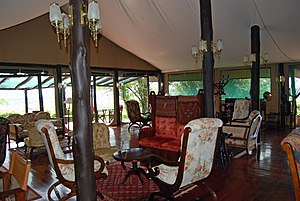
For the most basic trip, consisting of a group packed in a minivan and camping overnight, you should have a minimum budget of US$70/day, while some of the most visited parks may cost US$100–150/day. A luxury trip flying into a lodge for a week with guided, personal 4x4 trips onto the savanna with an assurance of seeing every animal desired can easily run over US$1000/day. If a tour operator offers you a package at a price that seems too good to be true, it likely is, and there is probably a good reason why (unless it's an outright lie) someone might be offering a significantly lower price than a dozen other operators for the same park. This can be the result of hidden fees (arriving at the park, when the operator tells you to pay your US$50 entrance fee or camping permit...it wasn't covered), large errors/omissions/lies when calculating a price, an unlicensed operator, abusive labor practices (paying inexperienced porters exceptionally low wages compared with other operators), poor equipment (a 30-year-old minibus in disrepair), length of the trip (a "daytrip" may be a quick 4-hr drive, rather than a slow journey from dawn to dusk), and extras that you may not have thought of or for which this operator plans to charge a steep fee (not providing food, water, sunscreen, and insect repellant...but offering snacks for a fee). Make sure to thoroughly check what each tour operator provides in their cost and make sure it's put in writing before payment and the start of the safari! You may also want to ask fellow travelers in hotels, hostels, or restaurants for their experiences with local safari operators.
Self-drive safaris are possible in some parks, but highly discouraged for first-time safari goers. For some parks, part of licensing tour guides is education on the local wildlife and environment, which independent safari goers will miss out on, and a good guide will know the best times and places to glimpse wildlife, which is largely lost on independent safaris. Most parks have placed restrictions on the behavior of visitors for both conservation purposes and your safety, especially, which may be difficult for novices to follow when unaccompanied. Roads are often rough and sometimes difficult to navigate without offroad driving experience. Not only that, but most rental car agencies will not rent vehicles without a driver or for off-road use. Independent drivers will also want an HF radio to communicate with park rangers and others for safety reasons and should not exit their vehicle without a firearm—obviously those lions and leopards bringing down massive wildebeest and zebras will have easy pickings preying on you! The relatively high entrance fees for most parks (and, if applicable, vehicle rental) often narrows the difference in cost between an independent driving safari and going with a licensed operator to the point that the latter is a good value.
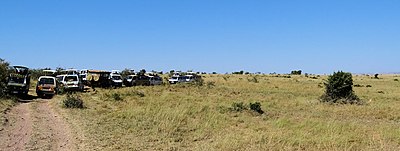
Bear in mind that most wildlife parks and reserves are large, with some animals elusive and/or nocturnal. For this reason, booking a longer safari allows you to see more of what you want to see. One-day safaris are often touted in small towns near major parks. However, a part of your trip will be spent between orientation and simply driving to/from the park – 8 hours and US$100 later, you may be disappointed in only seeing a couple of the big five, from a long distance. Most people will want to spend at least 3 days (2 nights) on safari, allowing time to slowly drive through areas rich in animal life, wait patiently in spots for animals to pass by, drive close to groups of animals, and maybe even venture out at night to view lions on the hunt or the nocturnal and elusive leopard.
Some people believe it is more ethical to support only locals (ie. African owned/operated tour operators) as part of a sustainable or ethical/responsible travel ideology. There are pros and cons to practicing this when booking a safari and the ultimate choice is left to the individual. There are many quality safari operators owned, run, and staffed by locals who provide a good product liked by their clients. However, for every quality local safari operator, there are 1-2 operators who are dishonest (with fees and promises), offer poor service (broken promises, lack of good equipment like tents, use very old/unsafe vehicles), operate unlicensed, don't offer proper equipment (no firearms when leaving vehicle, use poorly maintained vehicles), or circumvent laws (not acquire proper permits or respect conservation laws), while some con artists will approach travelers as safari operators and seem convincing, only to disappear after receiving payment or after a small part of the promised safari has been provided. On the other hand, there are many non-native safari operators who have lived in Africa for a considerable portion of their lives and are keen on conservation, pay local staff better than African-owned safari operators, work with locals in nearby communities to supply fresh fruits or veggies, and are more knowledgeable both with the local environment and Western culture (more relatable in conversation, more fluent in English). Ecotourism and establishments practicing responsible tourism are increasingly common in sub-Saharan Africa and with higher cost of running such establishments (lodges, tour operators), many are not owned/operated by locals, yet nonetheless operate to ethical standards. In short, the merits of responsible travel are noble, but when discerning which safari operator to choose, the answer is not black-and-white (pardon the pun), with a wide number of factors to consider and the ultimate choice being left to the traveler.
Destinations [ edit ]
- Serengeti National Park , Tanzania
- Kruger Park , South Africa
- Okavango Delta , Botswana
- Maasai Mara National Reserve , Kenya
See [ edit ]
Stay safe [ edit ].
See Dangerous animals and pests .
Respect [ edit ]
- Animal ethics
- Has custom banner
- Outline topics
- Outline articles
- Outdoor life
- Topics in Africa
- Topic articles
Navigation menu
The Practical A-Z Guide to Going on Safari
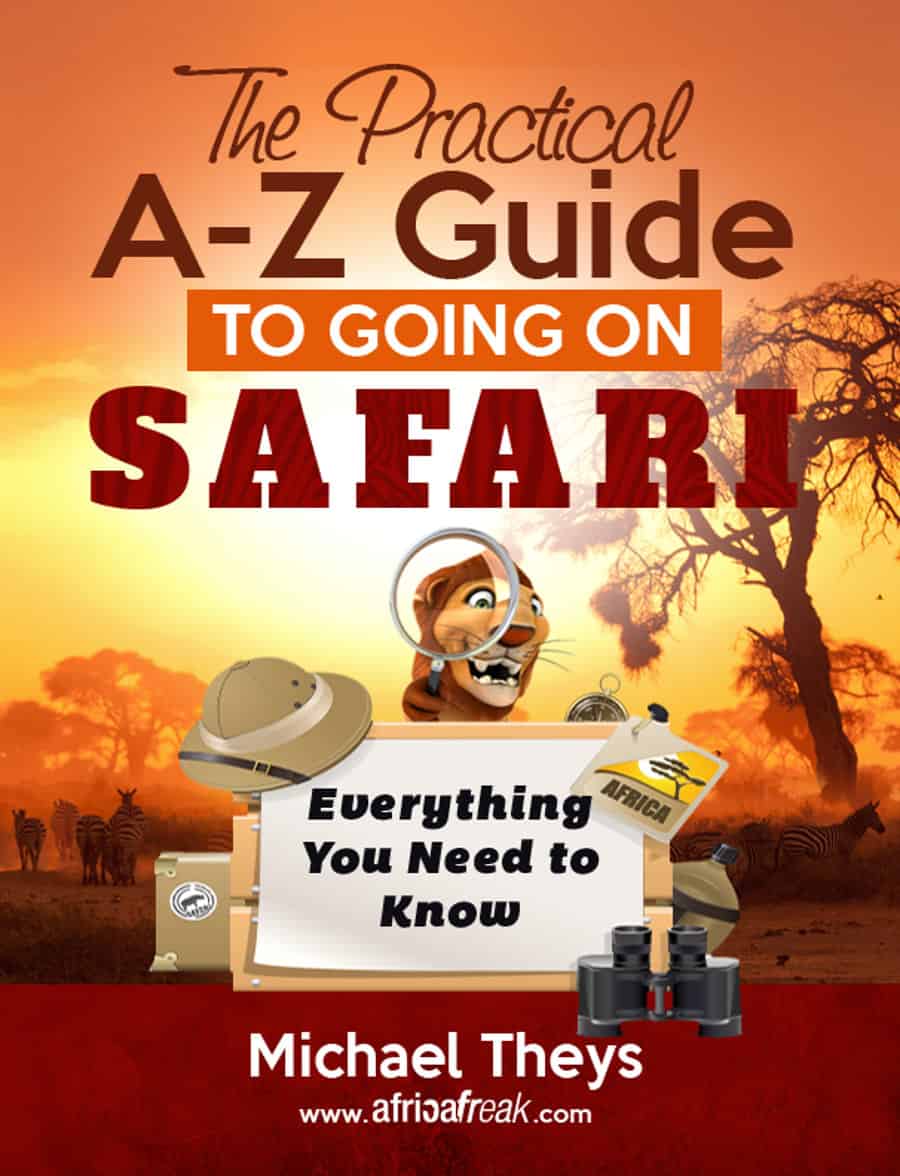
“ You Are About to Fall in Love… with Africa and the Call of the Wild… Here’s the Last Safari Guide You’ll Ever Need!”
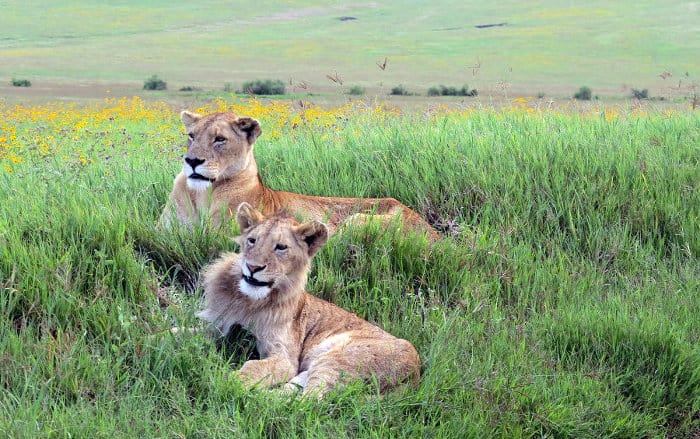
“The only man I envy is the man who has not yet been to Africa — for he has so much to look forward to.” (Richard Mullin)
Table of Contents
What is Safari?
The practical guide to going on safari, a = accessories, b = binoculars, b = baboon protection, b = big five, c = clothing, d = debit and credit cards, e = electricity plug converters, e = emergency toilet paper, g = great wildebeest migration, h = handwash, i = insect repellent, i = insurance certificate, k = kilimanjaro, l = leave the fashion at home, l = luggage, m = malaria medication, n = neutral colours, o = ornithology, p = patience, p = packing light, p = passport, p = photography, q = quenching your thirst, r = random safari activities, r = respect the environment, s = sun protection, t = tipping, u = u.s. dollars in cash, v = vaccinations, v = visas for travel, w = walking safaris, w = wifi (or lack of), x = x-rated wildlife situations, y = yellow fever certificate, z = zzzz….
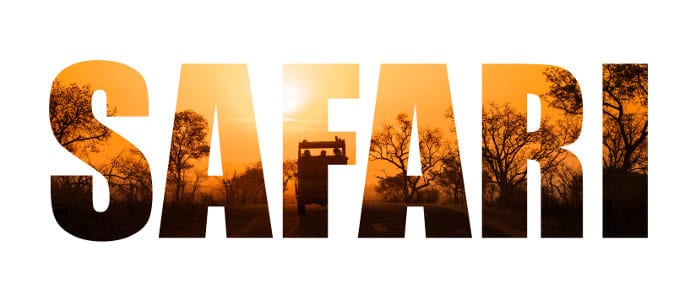
From the wildebeest covered plains of Tanzania to the elephant filled forests of Botswana, safari is the world’s great escape into untouched wilderness. It’s an immersion in the wild, one that takes you away from urbanscapes and into a realm where people are merely visitors.
Africa offers one of the world’s final remaining untouched natural landscapes, offering huge areas that have forever been the haven of wild mammals.
Going on a safari offers an immersion into this world.
It’s far more than sightseeing.
On an African safari you feel as if you are part of the landscape .
You open your senses to nature in all its drama and charm.
It’s something that I first experienced when I was just a child.
And it’s something that’s never left me.
Because once you’ve been on safari, you’ll want to go again and again .
Understanding safari further can be done through exploring the origins of the term. In Swahili, safari means “long journey” , a reflection of how the experience isn’t just about seeing a few animals.
Safari is nothing like a zoo. The animals aren’t in cages. These are wild fenceless landscapes where anything can happen. It’s unpredictable and it’s always intimate . Wild scenes play out just meters from your eyes, like lions taking down zebra or rhinos roaming around waterholes.
A safari isn’t about arriving with a tick-list or saying that you saw a few wild animals. It’s about going on a journey through Africa and discovering nature’s unmistakable rhythm.
But with safari there are always so many questions. From the basic concerns about safety – what happens if a hyena comes into the camp? – to practical details like what to pack , what accessories are needed , how to stay healthy , and even how to say hello .
This practical A-Z guide is designed to answer all these questions, covering everything you need to know for a safari journey. It’s based on the years of experience I have of going on safari and over 23 years of living in Africa.
With this guide I hope you will be fully prepared for landing in Africa and going off on your own safari adventure .
“If there were one more thing I could do, it would be to go on safari once again.” (Karen Blixen)
Easy Peasy from A-Z
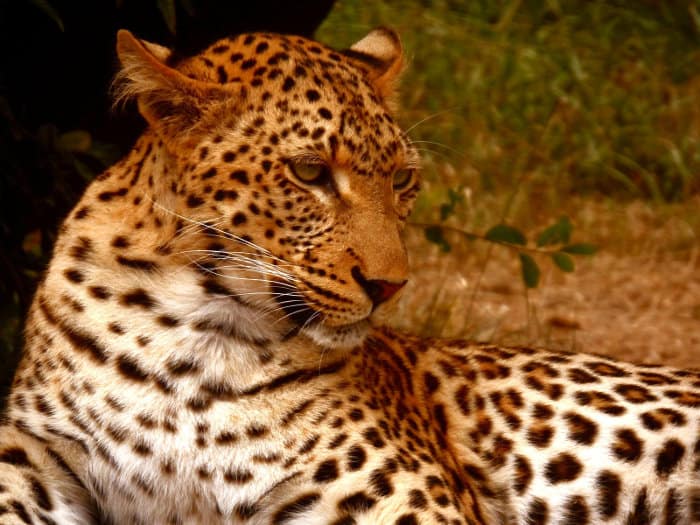
As the title suggests, this practical guide is an easy A – Z run through of everything you’re going to need on an African safari.
With this you should be fully prepared for anything the landscape or wildlife can throw at you, including the thieving baboons.
And who better to introduce it all than a majestic leopard photographed in Namibia’s Etosha National Park .
Small things that make a big difference
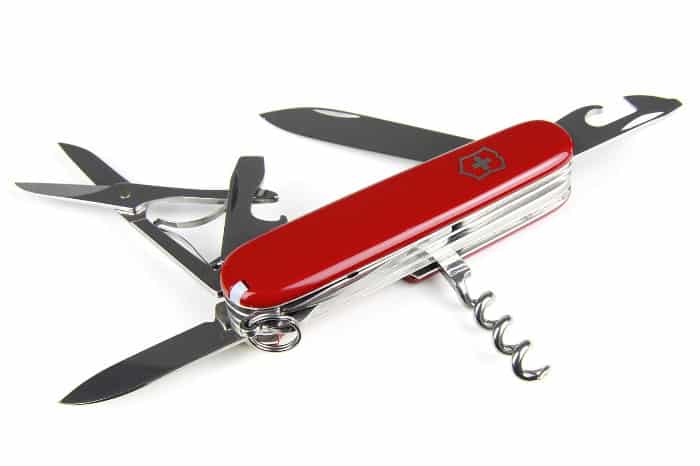
Pack for any trip and it’s easy to get preoccupied with the big things, like bags, shoes and sleeping bags.
But for a successful African safari, it’s usually the little things that really make a difference .
Here’s a few items that you shouldn’t leave home without:
- Swiss army knife or other penknife. This really comes in handy when you’re in the bush, from uncorking a bottle of wine to cutting up rope to tie down your tent. Or perhaps there’s a roadside stall selling huge ripe mangoes.
Maybe a sundowner bottle of beer needs opening when you’re gazing over the waterhole. In rural African landscapes, where there’s little around, a penknife is an essential item.
- Money belt . There’s various popular sayings in Africa that run along the lines of “once the fruit is ripe, you need to eat it.” In another language it means “if there’s an opportunity, you have to take it.” These metaphors can be applied to your travels in Africa.
It’s very unlikely you’ll get robbed, as long as you don’t present an opportunity. A hidden money belt keeps your cash and travel documents safely stowed away , so nobody is eyeing up the wallet that bulges out of your back pocket, or a handbag filled with all your valuables.
There are many models of money belt, like Travelwey, Landing Gear, Eagle Creek, or my personal favourite, the Pacsafe RFIDsafe 100 . It’s compact enough to hide under your clothing and has two zippered compartments.
- Combination lock or padlock. Suitcases usually have their own locks but you may need a combination lock for a duffel bag or backpack. A three-dial combination lock should be fine; it’s more of a deterrent than anything else.
Increasingly common is Pacsafe wire meshing that can be fitted around backpacks and duffel bags so nobody can get inside. This is very useful when you’re taking buses or local transport, especially overnight.
“Reminds me of my safari in Africa. Somebody forgot the corkscrew and for several days we had to live on nothing but food and water.” (W.C. Fields)
A major priority on a safari packing list

On an African safari you’ll be looking out for the big things and the small things , from herds of 50 elephants to tiny exotic birds that flutter around Acacia trees.
In most national parks, your safari vehicle isn’t allowed to travel off the trail, which can lead to frustration when the action is taking place far away.
Binoculars always come in handy, whether it’s scanning the trees for a leopard, getting a close-up of a kill, scanning the savannah for your next move, or admiring the intricate feathers of a tropical bird.
Here are ten things to consider when buying your safari binoculars :
1. Brand . There’s a huge amount of choice out there. I trust and recommend Zeiss , Canon , Bushnell , Pentax , Swarovski , Steiner , Leiva , Tento and Fujinon .
2. Cost . A reasonable pair of binoculars can be found for US$100. Anything else isn’t really worth it. Expect $200-300 for a good pair that’s guaranteed to last. The Pentax Papilio and Nikon Monarch are good entry binoculars. You can also find cheap second-hand pairs online.
3. Eye Relief . Eye relief refers to the optimal distance between your eyes and the binocular’s eyepiece. If you wear glasses, look for an eye relief of at least 15mm .
4. Field of View (FOV) . This is the width of the view at a particular distance. In general, the greater the magnification, the narrower the field of view. For an African safari, choose a pair with a field of view of at least 330ft at 1000 yards .
5. Magnification Power . Binoculars are fitted with a series of numbers, like 8 x 42 or 10 x 50. The first number represents the magnification . A figure of 10 means the image is ten times bigger than seen with the naked eye. For tracking fast moving objects like birds or running mammals, don’t consider magnification greater than 8x . 10x or greater is better for general animal spotting and when you need to scan the horizon .
6. Lens Size/Aperture . The second number represents the diameter of the lens ; the larger the number, the bigger the lens and the more light the binoculars can take in. This is important in fading light and for making the scenes more colourful. For optimal results, consider fully multi-coated lenses .
7. Shock Resistance . It can be bumpy in a safari truck so you’ll want protective rubber or synthetic housing that prevents scratches on your binoculars.
8. Waterproofing . Waterproofing isn’t just about protection from dropping the binoculars in a hippo-filled lake. It protects them against moisture , humidity , and the swirling dust that inhabits many safari landscapes.
9. Weight and Size . There’s a trade off here. Compact binoculars are lighter and easily transported, so great for birdwatching . But larger binoculars offer greater magnification , precision and image detail .
10. My Personal Recommendation . I’ve had my Russian Tento army-type binoculars for over 15 years and they’ve probably been the best ever safari buy (thanks dad).
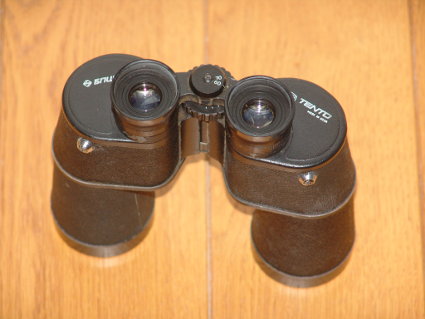
Some personal favourites to get you excited
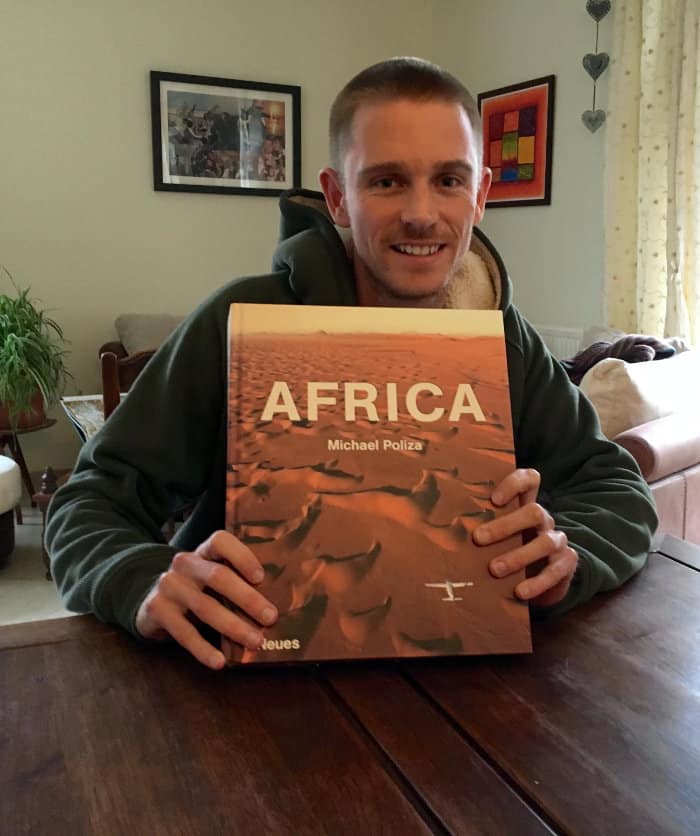
I’m not suggesting filling your bag with a lot of hardback illustrated books, but there’s some amazing literature that will really inspire you to visit Africa . Plus, a couple of field guides are an excellent accompaniment to a safari.
With those in your backpack, it’s easy to recognise animal behaviour and exactly what you’ve just seen. The following are some of my personal favourites :
Illustrated Books
- Africa , by Michael Poliza – A photography masterpiece with sublime illustrations and jaw-dropping images. One glance and you’ll fall in love with Africa.
- Serengeti: Natural Order on the African Plain , by Mitsuaki Iwago – I got this book from my parents when I was only a child. It made me immediately fall in love with Africa’s extraordinary wildlife. Mitsuaki is a real artist with his camera.
Field Guides
- Birds of East Africa , by J.G. Williams and Norman Arlott – An indispensable guide with 1283 species and 650 colour illustrations.
- Larger Illustrated Guide to Birds of Southern Africa , by Norman Arlott , Phil Hockey , Ian Sinclair , and Peter Hayman – Recently updated, this is the most comprehensive guide on its subject.
- The Safari Companion: A Guide to Watching African Animals , by Richard D. Estes – This book is like having a personal guide with you on safari, as it’s full of information about behaviour displays, vegetation zones, and what to look out for when you spot all the big mammals.
- Signs of the Wild , by Clive Walker – This is my bible for Southern Africa safari. It contains detailed information on the spoor and signs of all Southern African mammals, plus stunning illustrations, distribution maps, and an environmental glossary.
- Larger Animals of East Africa , by David Hosking and Martin B. Withers – It was one of the first safari guides I ever bought. It’s got great illustrations and is very easy to use. Perfect for a first-time safari.
Travel Guides
- Lonely Planet – There’s both an East Africa and Southern Africa multi-country guide by the LP. If you like the Lonely Planet style then these are good travel companions. I wouldn’t recommend their Africa guidebook as it squeezes over 50 countries into 1000 pages, so there’s very little detail.
- Bradt – Bradt’s various country guides are more in-depth and authoritative than the LP and it was Bradt that published the first ever guidebooks to various African countries. The major downside is that there’s no up-to-date regional guide, so you’ll need to buy a separate guidebook for every country.
Safari Tales
- Don’t Look Behind You! A Safari Guide’s Encounters with Ravenous Lions, Stampeding Elephants, and Lovesick Rhinos , by Peter Allison – The title says it all and you really feel like you’re on an Africa adventure with the narrator.
- Whatever You Do, Don’t Run: True Tales of a Botswana Safari Guide , by Peter Allison – Read this and you’re certain to put African safari at number one on your travel wish-list.
- Out of Africa , by Karen Blixen – A biography of living in Kenya and developing conservation.
- Born Free: A Lioness of Two Worlds , by Joy Adamson – The original and still the best book on the complexities of wild versus tame.
General African Literature
- Things Fall Apart , by Chinua Achebe – A harrowing tale of what happened when white colonization entered West Africa.
- The Whale Caller , by Zakes Mda – A surreal novel about a South African whale caller who falls in love with a migrating whale.
- The Shadow of the Sun , by Ryszard Kapuscinski – 40 years of stories from a Polish journalist who lived all across the continent. Beautifully written and focuses more on the positives than many other journalist biographies.
- Half of a Yellow Sun , by Chimamanda Ngozi Adichie – A stunning story of love, tradition, modernity, and civil war.
“I never knew of a morning in Africa when I woke up that I was not happy.” (Ernest Hemingway)
Protection for when animal meets man
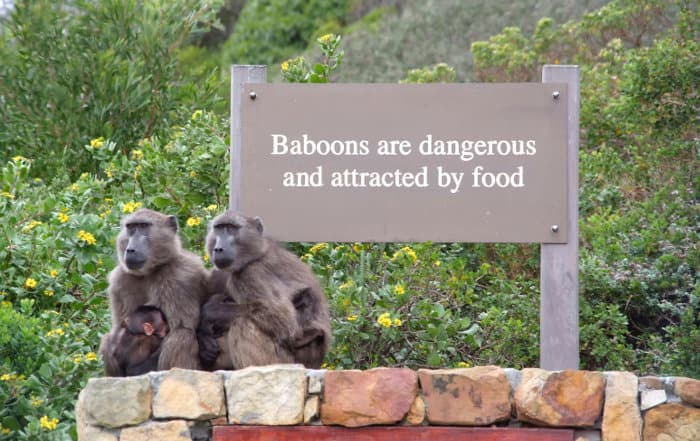
Baboons are amusing. They run around in troops, jump through trees, ball and shout, and generally make an entertaining safari highlight. But they’re cheeky and impudent thieves , always ready to jump at an opportunity to run off with your food.
So you always need to be vigilant and bring your mental baboon protection. Baboons have a habit of hanging around any place where there’s people and food, notably the entrance gates to national parks and public campsites.
Their tactics involve jumping through any open windows , shouting , and running away with your packed lunch box. And they don’t just steal bananas and stale bread.
Baboons are experts at rummaging through your belongings and stealing the items of culinary luxury you brought for the safari.
So how do you protect yourself from baboons?
Firstly, always keep the windows to the safari truck closed when you’re parked, even if you’re inside (it’s pretty scary when a baboon jumps through the open window and you’re still inside the vehicle).
Secondly, don’t walk and visibly carry any food whenever baboons are around.
And finally, but most important, stand your ground if a baboon snarls at you – they just want to scare you away so they can thieve your goodies!
* Tales From an African Safari Guide
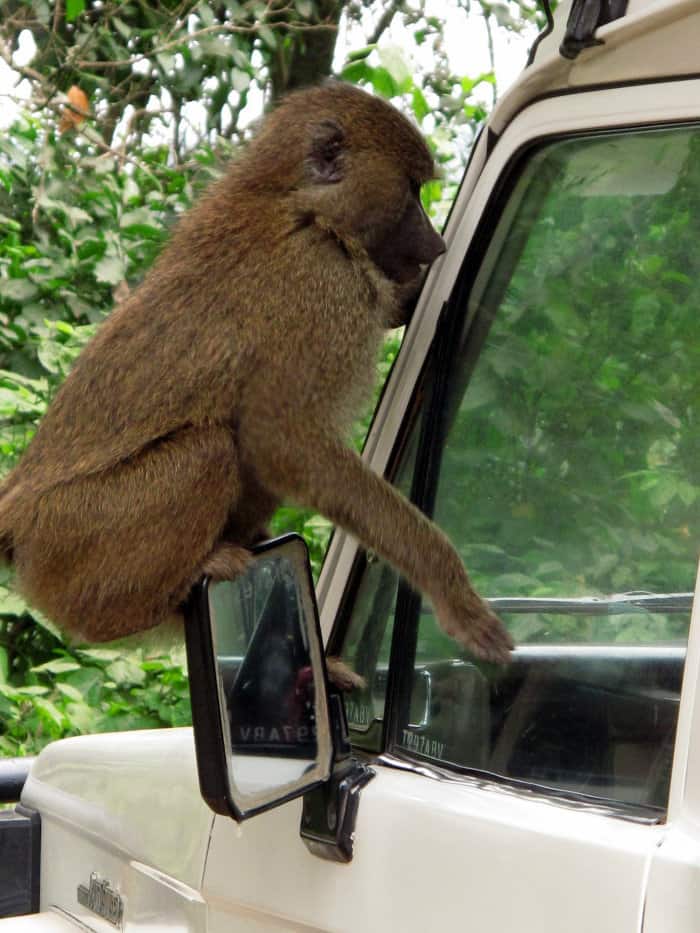
On one of my first ever jobs I was waiting at the entrance gate to Ngorongoro Conservation Area in Tanzania. There were baboons everywhere and I told everyone explicitly to keep the windows closed and not walk around with food.
One of them opened the window to take some close-ups of the baboons as they climbed over the vehicles. I was buying the entrance tickets when suddenly, a piercing scream came from the car park.
A young baboon had jumped through the open window and the commotion alerted three much larger members of the troop. There were now four baboons in the vehicle! I had to run out with a stick, open the door and scare them away. All on my third ever safari as a guide!
I went to inspect the damage. The baboons had ignored the sandwiches and fruit. Instead they’d stolen my two tubes of Pringles , the only vegetarian packed lunch, and half a kilo of gourmet Dutch cheese – essentially the only items I couldn’t replace.
Going beyond the safari favourites
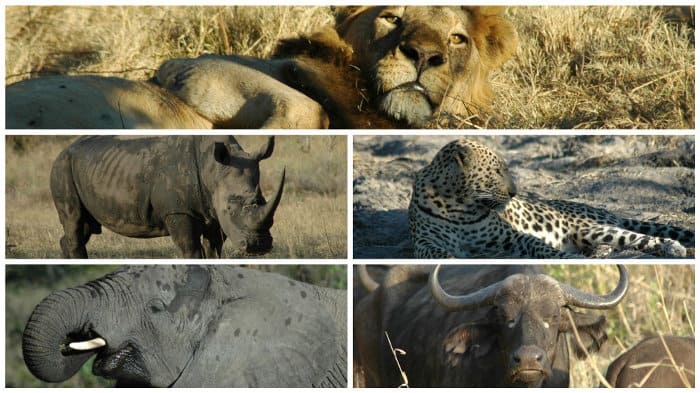
Okay, so you can’t pack them, but knowing the big five is the starting point for your exploration of the wildlife in Africa . The big five is a big buzzword in the safari industry, yet it’s got a menacing history. It’s actually a hunting term .
These five animals were famous because they were the hardest to hunt , as it was only these five that would attack back when they were getting hunted. Fast-forward 100 years and it’s these big five animals that are revered as the premier sights on an African safari.
The big five are lion , leopard , elephant , rhino , and buffalo . And I’d like to see anyone who could squeeze any of these into a backpack.
Of course, seeking out these majestic animals is going to be at the heart of your safari experience. But don’t get too preoccupied. There’s far more to safari than just five animals . Some national parks have over 100 different mammals while others have herds of zebra or wildebeest that number over 100 000.
A safari offers a complete immersion in the wild and you’ll be surrounded by nature’s weird and wonderful, so don’t think it wasn’t a success because one of the famous big five didn’t get a tick on the list.
* Tales From My African Safaris
The first animal I ever encountered in the wild was a black rhino in Nairobi National Park. Everyone had said not to expect too much, so I hadn’t even thought about any of the big five. It crossed the road right beneath our eyes – not a bad safari start don’t you think? Perhaps you can see why I was hooked from the first moment!
Get dressed for safari success
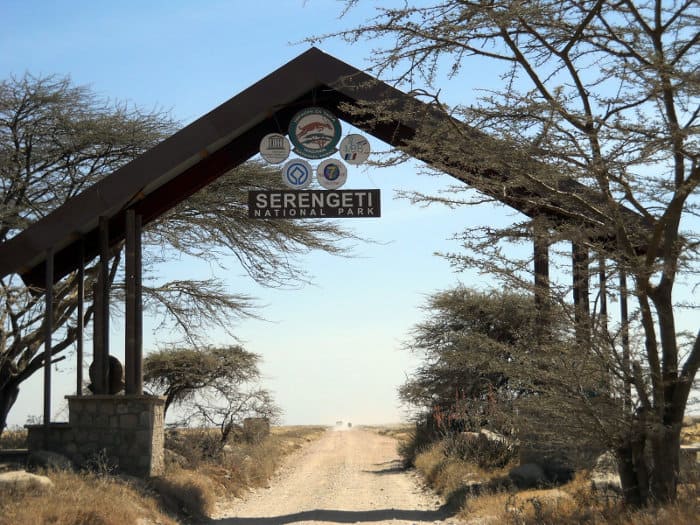
The African savannah can be dusty , windy , scorching hot , surprisingly cold , and when it rains it “really” rains . Two adjacent national parks can have very different climates and conditions.
So what do you pack?
Before considering the packing list, let’s first consider the basics of safari. The climate can be harsh and unpredictable, the landscape is rough and rugged, while the adventure takes you to remote wilderness that’s hundreds of miles from any paved road.
So to get dressed for safari success, think first about practicality and comfort . You’re not going to be impressing giraffe on a nightclub dance floor or showing off a designer swimsuit to a wading hippo. So never bring your best clothes .
Instead, whatever you bring needs to reflect the challenging conditions of a safari. Here’s a rundown of a comprehensive safari wardrobe , all of which is recommended in neutral colours (see N for why!):
- A couple of lightweight jerseys and a warm lightweight fleece – Early mornings and late evenings can be chilly, especially when you’re in an open safari vehicle.
- Short and long-sleeved button shirts – I normally pack two of each. The long sleeves are important against the sun and insects.
- T-shirts – Pack a few so you always have clean options in the evening.
- Shorts – Two or three pairs are enough as long as they are durable.
- Durable long trousers – These are especially important if you’re going to be walking through the bush.
- Zip-off safari trousers – Yes, I know they’re not fashionable but they save luggage space and are highly practical.
- Jeans – Although they are bulky and heavy, I like to bring a pair which I can change into during the evenings.
- Underwear – I’m not going to make any suggestions here!
- Poncho – They’re lighter and more practical than a raincoat and can serve both as a rain cover for you and your belongings. It’s also an effective windbreaker.
- Swimsuit – If a camp or lodge has a pool then it’s usually got an incredible view. Just don’t go swimming when local wildlife is taking a drink!
- Sarong / kikoy / Maasai shuka – An excellent accessory that can be used as a blanket, sun protection, or to keep you warm against the wind.
- Thermal long johns , gloves , scarf , beanie – Required in winter when you’re on safari in Southern Africa.
- A multi-pocket gilet – This is especially useful for photographers.
- Shoes – See S for what you’ll need.
- Socks – Thick comfortable ones to wear underneath your shoes.
Now, you might be thinking – especially if you are female – that all this makes for a drab and conservative wardrobe. So let’s accessorise. Two or three lightweight coloured scarves or wraps are a great way to add some glamour to a safari outfit. Combining this with some vibrant local jewellery or bead necklaces works really well.
For guys , a colourful evening shirt helps inject some vibrancy into the outfit. When packing your wardrobe consider that you will need different clothes for the actual safari activities and for the evenings . After a long day in the bush you’ll want to shower and change into clean fresh clothes for the evenings.
Yes, they do work

Many people think that Africa is a backwards completely undeveloped continent where the locals are still trading with kola nuts or seashells. The world’s media doesn’t tend to document the progress that Africa has made.
Banks and ATMs can be found across the continent , especially at major airports and in big cities. Not all of these will take foreign cards, but there’s at least one bank in every country that will accept plastic.
Visa is the most readily accepted. Mastercard also works in a smaller percentage of banks. It’s difficult to find ATMs that will take American Express or Maestro , especially when you’re in East Africa .
Whenever I withdraw the equivalent of $200 I feel like a rich man. I’m not being bigheaded here. The highest denomination note is often worth less than $5 . So the ATM has to dispense a lot of notes and my wallet is almost bulging out of my pocket.
It’s also hard to completely rely on ATMs, because the traveller’s nightmare dictates that the bank machines will only stop working when you’ve completely run out of money. So remember to also see U = US dollars .
Because you’ll need to recharge the camera
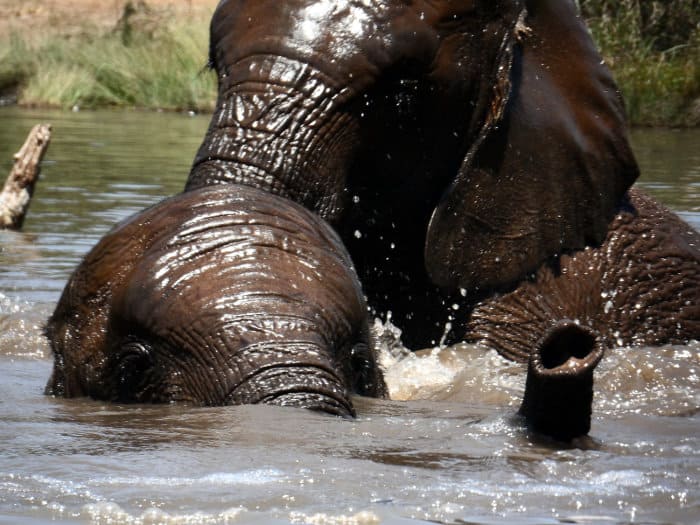
The first time I visited South Africa I almost threw my plug adapter away. It was one of those international adapters that supposedly work in every country. Except, they don’t work in South Africa. Or Namibia. Or Botswana. Or Swaziland. Or Lesotho. Wow, the list goes on.
In Southern Africa they have these strange bulky three-pin sockets that aren’t found anywhere else in the world. So the typical international plug adapter is completely redundant. Fortunately, you can buy an adapter at the airport when you arrive.
It’s good to buy one as soon as you arrive , because plug adapters aren’t the easiest things to find when you’re camping in the bush and elephants are calling from the forest.
In Southern Africa, many places already have European two-pin adapters that are fitted into the wall. You can never guarantee this. Although you can probably guarantee the camera battery going dead at the only place without a two-pin adapter.
Many safari vehicles are fitted with USB chargers and some also have standard plug sockets. These are great for recharging on the go, especially if you have two camera batteries or need to charge up a GoPro or video camera.
The majority of East Africa uses British-style square three-pin electricity sockets . So an adapter that works in the UK will work fine in Kenya, Tanzania, or Uganda.
You never know when…
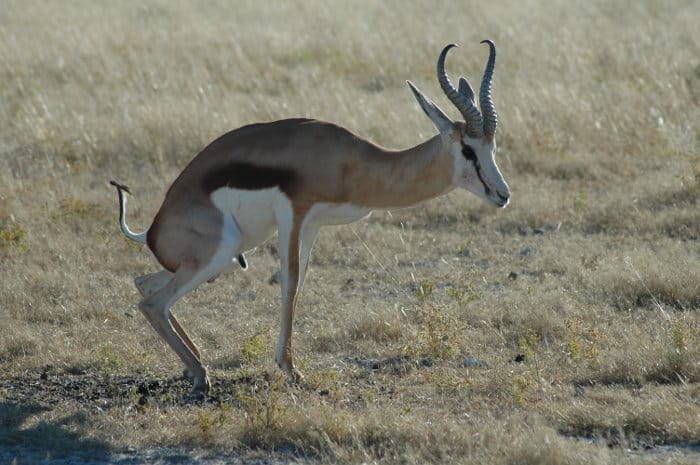
Some people picture an African safari and imagine going to the toilet in the forest and wiping with their hand. Well, going to the toilet in the trees is going to be dangerous when there’s elephant herds roaming around. There are toilets, a mix of the seated and squat varieties.
But there isn’t always toilet paper , especially at remote toilets in national parks. Now, the important thing about emergency toilet paper is keeping it in an accessible place . When you need to go you don’t want to rummage to the bottom of your backpack. Or start cursing because your toilet paper hiding place was too effective.
I like to keep a couple of sheets in my back pocket, just in case. Or sometimes I put half a roll in the side pocket of my daypack. And here’s the most important rule of emergency toilet paper: replace what you’ve used . Nobody wants to turn to discarded plane tickets or insurance certificates when they’re on the toilet. 😉

I always like to tell my guests about the different styles of toilet they can encounter, like composting toilets, squat toilets, the hole in the ground, and the at-one-with-nature. One morning I was watching out for animals when a guest wanted to find a discreet place to do what he needed to do – being male makes these things much easier.
It was the heart of the dry season and the urine created a little puddle on the savannah. Within two minutes there was a Beisa oryx slurping it all up. Everyone was baffled. But I was unsurprised because nothing is wasted in the bush and a tourist’s urine is an excellent source of salt.
Bring a few luxury items for your safari
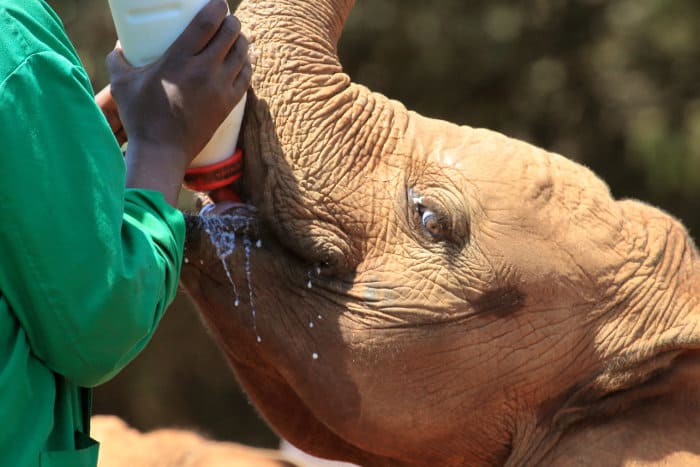
Safaris range from the cheap and cheerful to the ultra luxurious. Unfortunately, there’s not many of us who can afford the high-end safaris and staying in $1000-a-night camps . These luxury safaris come with gourmet meals and snacks, so there’s no need to pack any extra food for your safari.
However, taking a cheaper safari often means sacrificing good food for getting a better price. The menu might be five days of pasta and sauce, or a week of the same basic staples that can be cooked on the fire. There’s nothing wrong with this food, but I find that it can get a little monotonous.
So it’s good to pack a few luxury items for a sweet or savoury snack in the bush. There’s a few things you’ll struggle to find in local African supermarkets, especially nice chocolate or cheese . You might also want to stock up on some chips or nuts .
Bringing a few luxury items means poor quality food isn’t a problem – just don’t leave it within reach of any monkeys …
“Africa is mystic; it is wild; it is a sweltering inferno; it is a photographer’s paradise, a hunter’s Valhalla, an escapist’s Utopia. It is what you will, and it withstands all interpretations. It is the last vestige of a dead world or the cradle of a shiny new one.” (Beryl Markham)
Where and when to catch nature’s greatest show

An African safari always delivers immersive highlights of wild drama and staggering impressions of scale. Nowhere is this better illustrated than the great wildebeest migration , the largest gathering of wild mammals anywhere on the planet .
It’s an annual phenomenon that’s appeared on many wildlife documentaries, concerning 2 million animals migrating around the grass plains of the Serengeti ecosystem. There’s wildebeest, zebra, and Thomson’s gazelle, all of them chaperoned by a hungry collection of predators.
The scale is mind-boggling. In one panorama there’s hundreds of thousands of animals, all slowly grazing and moving across the landscape. Get closer and you can take in all the little details, like zebra resting on each other’s backs, wildebeest mock charging to demonstrate their virility, or cheetah stalking a baby gazelle.
Nature’s greatest show roams between two adjacent and fenceless parks: Tanzania’s Serengeti and Kenya’s Maasai Mara . Witnessing it is about being in the right place at the right time.
From late-December to March , the wildebeest calve on the nutrient-rich grass of southeastern Serengeti. With so many young calves around, this is the prime time to spot the big cats hunting. There’s cheetah , leopard, lions, hyenas , vultures, and a few diminutive hunters you might not have heard of before.
From March to June the herds start migrating north across the Serengeti. They move off in five to seven waves, each big group taking a slightly different route across the flourishing grass. These months are best for seeing the herds on the move, although note that April and May is also the rainy season in the Serengeti.
Sometime in July , the herds start to congregate besides the Mara River. They can wait for days before one wildebeest builds the courage to cross the river and 100 000 follow. It’s a precarious crossing as crocodiles wait in the water and the currents are too strong for the older weaker wildebeest.
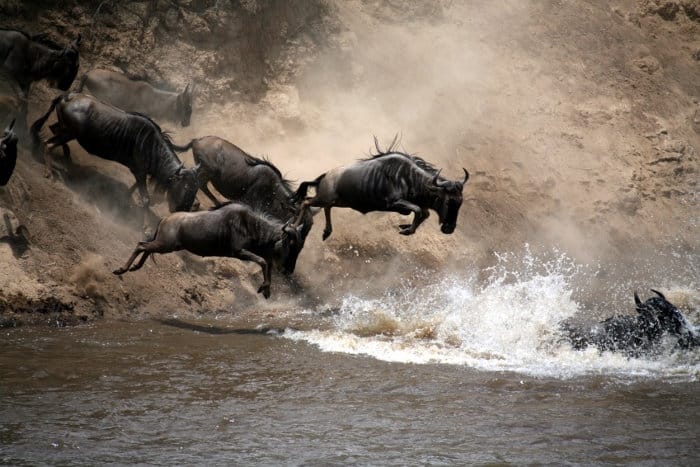
And when they arrive on the other side? Lion prides and other cats are licking their lips in anticipation. July and early-August is best to see this dramatic river crossing from the Serengeti to the Maasai Mara. Then from August onwards , you’ll need to be in Kenya’s Maasai Mara to see the big herds.
By now, they’re all grazing and getting fat on the fresh grass, before the females lead the charge back south to the calving grounds, where the cycle repeats itself for another year.
The sun doesn’t take prisoners

While it might look pretty when it dips behind the horizon and paints the sky all shades of orange, the African sun is intense and pretty dangerous. Rather than malaria, it’s the African sun that’s most likely to have you feeling ill on an African safari.
Safari isn’t a place for four hours of sun bathing next to the pool. Spend two hours with your head in the sun and it will be spinning. So a good wide-brimmed hat is one of the most important things on the packing list.
It needs to be wide enough to keep the sun off your face and the back of your neck , especially if you intend to go on a walking safari. While they might not look particularly fashionable, there’s a reason that so many people wear identical looking safari hats.
But don’t worry too much if you can’t find one at home. Almost all African airports sell typical wide-brimmed safari hats so you can pick one up when you arrive.
While the typical safari hat isn’t particularly fashionable or alluring, there’s plenty of alternative options that can add some jazz to your safari outfit.
For girls , floppy straw sun-hats are lightweight and provide excellent shade cover.
For guys , Panama hats or sturdy real leather cowboy hats are a little more chic than the standard fare sold at the airports.

The anti-bacterial kind
Just imagine: you’re driving through the savannah and the wind is sending dust everywhere, covering everything in a thin veil of brown. There’s no waterhole for miles and there’s a brown layer of sweat on everyone’s face. And now it’s lunchtime, and your dusty fingers are about to wrap themselves around a sandwich.
A small tube of anti-bacterial handwash is an essential little addition to a safari daypack. A quick squirt from the tube and you’re ready to enjoy your lunch, rather than worrying about how many strange germs and dust particles are accompanying the meal.
An absolutely essential item on the packing list

Insects are tricky. They can turn any safari into an itchy nightmare as they ravish your ankles and feast on the skin around your legs. So insect repellent is perhaps the most important item on your packing list . You’ll need to apply it every late-afternoon , in preparation for when the mosquitoes hover around at dusk.
You’ll also need it on in the early-morning , especially for an early game drive. And it’s not just mosquitoes . Protection against things like tsetse flies also makes insect repellent absolutely essential.
So what is a good mosquito repellent? Ideally, look for a product that contains at least 20% DEET , the active ingredient in the repellent. Some brands have insect repellents with 50% or even 80% DEET. However, some people don’t like DEET as it’s a chemically manufactured substance.
There are various natural alternatives. Citriodol is produced from eucalyptus oil. Citronella is excellent although it’s hard to find repellents that use it. Picaridin is very pleasant, relatively odourless, and has a gentle clean feel.
DEET is still the most effective in keeping the insects away, but these natural remedies just feel nicer on the skin.
A recent addition to the market are insect repelling wristbands , available with both DEET and natural repellents. Wear them on your ankles and wrists and they can be extremely effective. Just remember to remove them when you’re in the shower, otherwise you’ll wash away all of the repellent.
Insect repellents come in various sizes and styles, like gels, sprays, creams, or roll-ons. Personally I feel that too much is lost with the sprays, as half the bottle misses your skin when you spray it on.
I like to carry a small pocket-sized bottle of repellent cream with me, because there’s always one day when you forget to put on your repellent and the insects start biting.
“If you think you are too small to be effective, you have never been in bed with a mosquito.” (Betty Reece)
Ensure immediate attention in an emergency
Hospitals in developing countries work a little differently from those at home. The first question they ask when you arrive is not “what happened,” but “who is going to pay?” Medical treatment isn’t free and the hospital will want some proof that the costs can be covered.
You will probably be able to cover the costs. But what if you don’t have cash, they don’t accept Visa, and the nearest ATM is 150 km away? In an emergency it’s important to get immediate treatment.
Carrying a copy of your insurance certificate helps ensure that the doctors will treat you straight away. It helps to have the insurance company’s emergency phone number on the document so that they can make immediate contact if anything needs to be clarified.
Some elementary Swahili for visiting East Africa

Africa has over 1000 languages and 3000 tribes , so it’s not always easy to communicate in a local dialect. Swahili is the main language of East Africa and while it won’t be everyone’s first language, it’s a language that almost everyone can speak in the region.
Learning a few simple words is an easy way to endear yourself to the locals. It’s a real show of respect if you attempt to use a few words. The great thing about learning Swahili is that you speak it pretty much as it is written, so there’s no funny phonetics like many other languages.
Thank you = Asante
Hello, how are you = Jambo
Reply to Jambo = Sijambo
Hello, how are you (informal) = Mambo
Reply to Mambo = Poa
How are you (general) = Habari
Reply to Habari = Nzuri
Welcome = Karibu / Karibuni (to welcome more than one person)
Have a good journey = Safari njema
Where’s the toilet? = Choo kiko wapi?
Go away! = Nenda zako!
No worries = Hakuna shida (although Hakuna matata is also correct!)
Lion = Simba
Buffalo = Nyati
Elephant = Ndovu / Tembo
Leopard = Chui
Rhino = Kifaru
Cheetah = Duma
Hyena = Fisi
Crocodile = Mamba
Hippo = Kiboko
Snake = Nyoka
Giraffe = Twiga
Warthog = Ngiri
Zebra = Punda milia
Baboon = Nyani
Wildebeest = Nyumbu
I was staying at a lodge by the river in Ruaha National Park and it wasn’t fenced off. So wild animals were roaming around. It was almost dark and my mother and sisters walked from the chalet to the restaurant. Maasai warriors usually accompany guests but for some reason they weren’t there.
On the way they bumped into a lone buffalo bull , and solitary buffalos are known for their aggressive behaviour. I’m not sure if my mother had time to shout “nenda zako” (go away), but luckily one of the staff members arrived and scared the buffalo away with some stones. They certainly got a huge fright!
Scaling Africa’s highest mountain!

Kilimanjaro is a majestic symbol of Africa, an old volcano that towers some 5895 meters above the plains of Northern Tanzania. Mounting to the snow-dappled summit is one of the continent’s great travel challenges and experiences. But it’s not easy.
Climbing to the peak takes at least five days , although realistically you should count on six or seven days. Summiting Mount Kilimanjaro is only possible on an organised tour and the majority of these leave from the Northern Tanzanian town of Moshi . Porters carry your bags and all your food, so you only need to carry a daypack.
There’s now six different routes to the top but 90% of climbers take either the Marangu (Coca-Cola) or Machame (whisky).
Marangu takes six days and is the only route that offers accommodation in mountain huts. It’s not the most scenic as it ascends and descends on the same trail. You can also do it in five days, but this seriously increases the risk of altitude sickness.
Machame takes six or seven days and is far more scenic , with a different loop up and down the mountain always bringing sublime panoramas. It’s widely considered a more difficult climb but is extremely scenic, with accommodation at public campsites.
For something a little different, consider the Lemosho route , a seven-day camping trail that starts from the West then descends to the South.
Expect to pay a minimum of $250 per day for a climb, with something around $350 per day being more realistic .
On the Africa Freak website you can find articles on what to pack for a climb, an unbiased guide to all the different routes , and an interview with someone who has climbed Kilimanjaro .
Wildlife doesn’t care about trends or labels
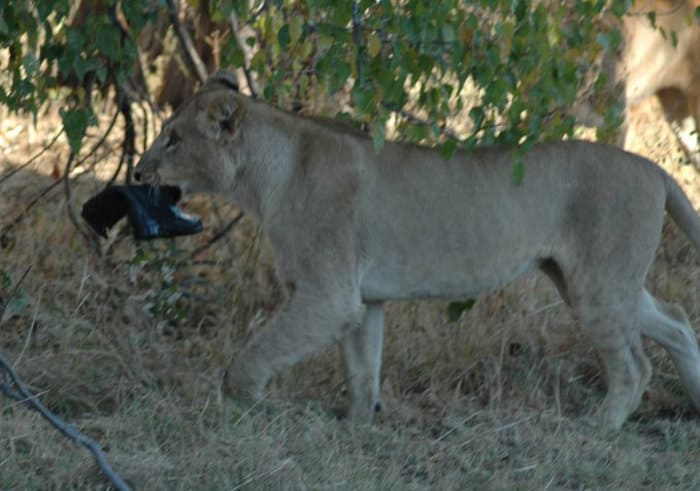
I’ve seen some crazily dressed safari-goers over the years and many people who seem to be competing for wearing the most impractical safari gear in history. There’s been haute couture animal prints hot off the Milan catwalk, Prada stilettos getting stuck between the slats of wooden decks, and $300 silk scarves getting ripped to shreds by thorn bushes.
I’ve even witnessed a set of Victoria’s Secret lingerie draping from the branches of an Acacia tree – it must have been stolen by vervet monkeys! And guess what, elephants and zebras don’t have a clue about high fashion or trends. They can’t tell if you’re wearing Lacoste from H & M.
When it comes to safari, there’s a good chance that what you wear is going to get ruined. So it’s not the place to be sporting your finest labels and most expensive clothes. Things will get dusty, sweaty, dirty, and covered in flying thorns from the vegetation – so practicality should always come above fashion when it comes to packing your bags.
Night sounds on safari can be extraordinary. Especially when an entire herd of buffalo comes storming through campsite, chased by a pride of lions! That’s what happened to me at Keer Keer Camp in the Timbavati.
What a symphony it was! We could hear one of the beast’s struggle as it went down in a fight for survival. To our astonishment we found the carcass the next day, less than 300 meters behind the camp and surrounded by six lions feasting.
“You know you are truly alive when you’re living among lions.” (Karen Blixen)
What to choose for an African safari
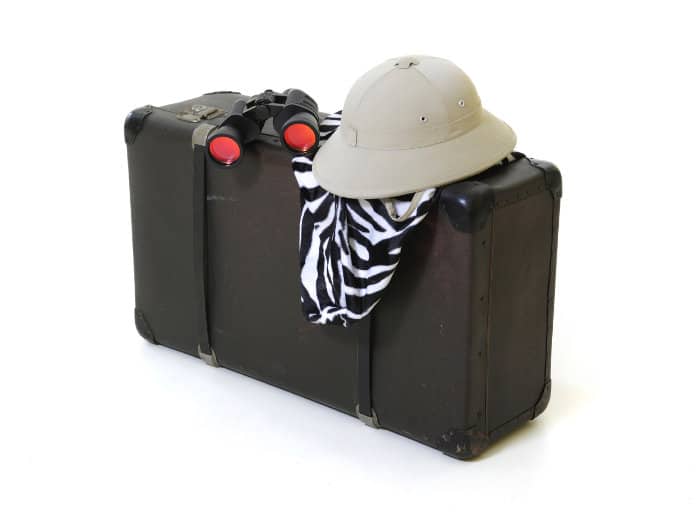
When all your safari gear is ready there’s another question that crops up. What to pack it in? If it was any other holiday then the type of luggage wouldn’t really matter; all the bag needs to do is survive the plane journey. But on an African safari things can get a little more complicated.
Your luggage is going to be coming with you on the journey, so it will be bumping around the bush and getting squashed into the back of Land Cruisers. Ideally, you’ll want to bring something that is both strong and can be easily squashed .
I find that duffel bags are perfect for this. I also prefer to only take bags with YKK zips as these are very strong and more secure.
Perhaps you already have something strong, secure, and squashable. If you don’t, what’s wrong with your existing luggage? Many suitcases are simply too inflexible . They take up too much room for how much they fit in, which is a nightmare when guides are trying to squeeze things into a safari vehicle or stash a bag beneath a seat.
Many cheap suitcases also aren’t strong enough . They need to survive getting thrown around and absolutely covered in dust. And those handy little wheels? They’re not that useful when the ground is as rugged and rough as the African savannah.
That’s why I like a sturdy duffel bag that can be squashed down but also expanded to fit in any last minute souvenirs at the end of a safari.
Your health depends on this

Somewhat bizarrely, malaria has actually helped Africa’s safari destinations stay wild and untouched . When the colonial invaders arrived they were fearful of areas where malaria was rife, so they didn’t turn places like the Serengeti into an area for farmland.
Fast forward and there is still some threat from malaria in Africa. Insect repellent is the most important factor in reducing the risk. If you don’t get bitten by a mosquito then you can’t contract malaria. So being cautious and applying the repellent is essential.
Camps and lodges should already come with mosquito nets so make sure you spend the night underneath it and not on top of it – sometimes that’s more problematic if you’ve had a few too many drinks!
I actually prefer not to take antimalarial medication . I’m not a fan of these medications and try to avoid them as it’s difficult to keep taking it for prolonged periods.
But I’m definitely not going to advise that you do the same. Contracting malaria has deadly consequences and you should get recommendations from your doctor .
Antimalarial tablets are especially recommended for anyone on their first trip to Africa. Not everywhere in Africa carries a malaria risk. Unfortunately, almost all the main safari destinations do. You can find country specific malaria maps here .
No antimalarial medication is 100% effective and there is no vaccination. There’s generally three types of antimalarial medication and they must be taken throughout the trip, plus a week or so before and after the trip. Again, your doctor will advise.
Malarone (atovaquone/proguanil) is a daily medication widely regarded as having the least side effects; it’s also the most expensive.
Doxycycline is a daily medication that is widely taken but some suffer side effects such as sun sensitivity and migraines.
Mefloquine / Lariam is only taken weekly but a higher proportion of people suffer from its side effects ( not recommended ).
“Everything in Africa bites, but the safari bug is worst of all.” (Brian Jackman)
The importance of blending in with nature
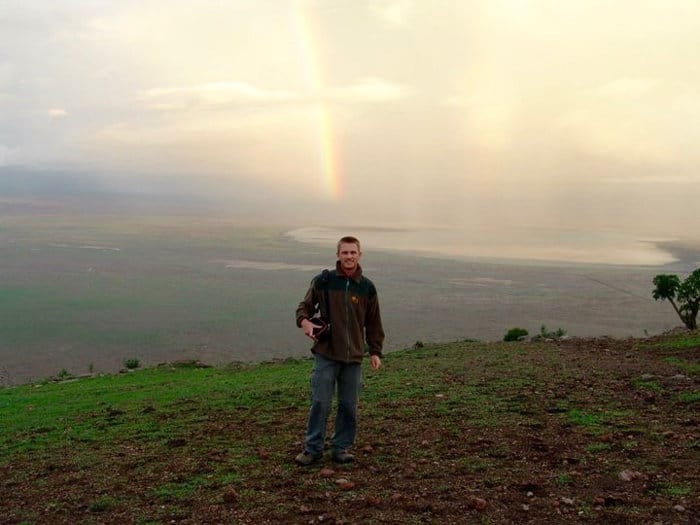
Ever wondered why everyone is wearing such drab colours on their safari photos? Or why wildlife presenters are always in khaki safari outfits? It’s not about fashion or everyone shopping at the same safari outfitter. Neutral colours are essential as they allow you to effectively blend into nature .
That’s not that important on a game drive as the animals see a vehicle, not the people in it. But on a walking safari , neutral colours enable you to become part of the landscape and not disturb the wildlife.
That means you can get closer to the ungulates .
And it also means you don’t annoy any of the dangerous mammals like rhino or buffalo.
Bright, flashy colours stand out against natural landscapes, so animals will run off when they see you. Furthermore, neutral colours can absorb dust far better than bright colours; a khaki shirt still looks khaki after driving through the savannah, while a bright red shirt will probably have turned khaki anyway!
So what are the ideal neutral colours for safari travel? There’s khaki , olive , mushroom , stone , and acacia . All these are extremely effective at enabling you to fully blend into the landscape.
Now here’s another essential packing tip. Avoid dark blue or black clothing at all costs . Yes, they might be relatively neutral, but these colours attract insects like mosquitoes and tsetse flies. The latter can be vicious and bite through your clothes.
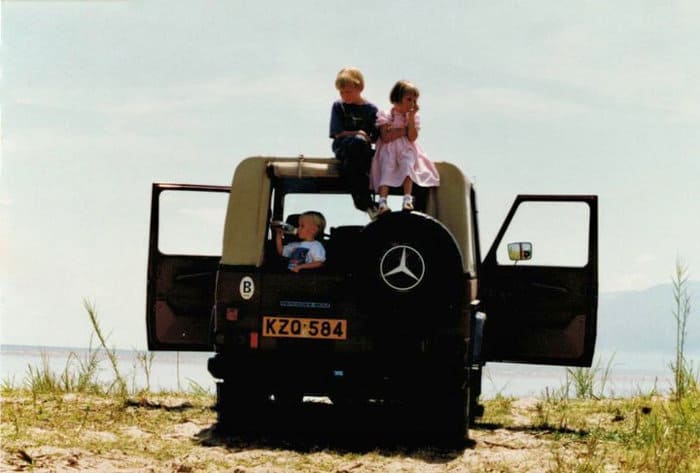
When I was a child, tsetse flies would sometimes get trapped in our jeep. And I remember that my two sisters and I were literally on a mission to exterminate them. We’d use some tissues (we called them “chimiques” – French word for “chemicals”) to squash them against the car windows.
I can still recall the agonising sound of the poor little creatures as we squeezed them in style: a real carnage! Not the most enjoyable thing to picture I must admit, but we were just kids at the time and to be honest it was rather painful when they managed to strike; so we simply couldn’t sit around doing nothing.
Remember to also look up on an African safari
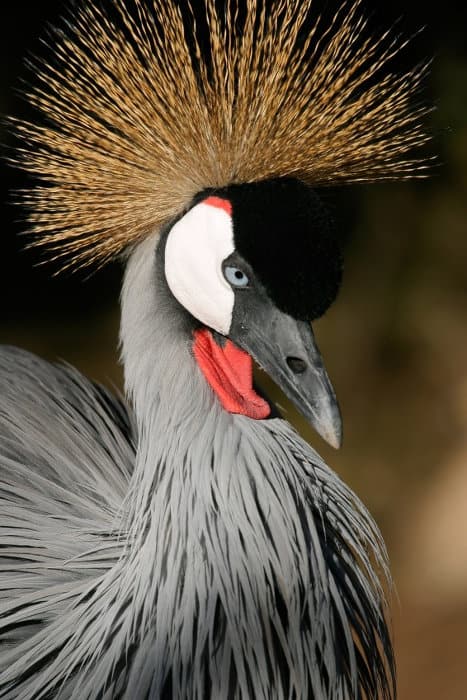
With the impala skipping and the hyenas roaming it’s easy to spend the whole African safari with your eyes to the ground. It’s the famous mammals that attract most people to safari and these normally live on the ground.
I’ve often fell into the rhythm of eagerly scanning the grass and only checking out the animals that live at ground level. But what about the trees and the sky? Africa is a birdwatching paradise and some national parks have over 500 different species .
They range from the exotically colourful to the boisterous and noisy, or the cute and curious to those with bizarre mating displays. Eagles soar overhead, vultures rest on high branches, while tiny tropical birds flutter above the savannah. And if you don’t look up you’ll miss it all.
While finding the big mammals is usually at the core of the experience, ornithology offers an added treat on any safari journey.
Some of my personal favourites are the African fish eagle , the majestic emblem of Zambia; the intriguing helmeted guineafowl ; the stunning bristly crown of the great crowned crane (pictured); then the rainbow colours of the lilac-breasted roller . There’s some inspiring photos and other examples of iconic African birds on the Africa Freak site.
“There is something about safari life that makes you forget all your sorrows and feel as if you had drunk half a bottle of champagne — bubbling over with heartfelt gratitude for being alive.” (Karen Blixen)
Good things come to those who wait…
Everyone goes on safari dreaming of the famous images from the wildlife documentaries, like buffalo herds clashing with lions, trunk-swinging elephant babies, or leopards pouncing on black and white zebra stripes. There is a good chance that you’ll see these beautiful safari scenes, but you can’t expect to see everything in the first hour of your first ever game drive.
At lodges and camps, I’ve heard many people complaining and saying that they “didn’t see anything . ” When I ask them to clarify, they say something like “well, we only saw two rhino, lots of elephants, and loads of buffalo.” Then I ask them to clarify further and they say “oh yes, there were zebra and gazelle and warthogs and hippos and crocodiles…”
When people say they “didn’t see anything” it usually means they didn’t see one of the big cats . Safari is unpredictable and you can’t expect to find every animal on every game drive. It’s not an unsuccessful safari just because you didn’t see a leopard.
So rather than get preoccupied with finding all the animals, pack plenty of patience and prepare to be amazed by the unexpected . Safari isn’t just about saying “I saw a rhino.” By being patient you can fully enjoy the natural show created by these incredible mammals.
So rather than zoom off, stop and enjoy your intimate access to the behaviour of Africa’s wild animals.

I remember being 12 years old and visiting the Serengeti in Tanzania. I was playing around with my cousins and standing on a small kopje, a rock that looks a little like Simba’s in the Lion King. Suddenly I got attacked from behind by an unhappy hyrax .
I must have been disturbing his nap or challenging his kingdom because he clearly wasn’t happy to see me! It just shows that wildlife can turn up when and where you least expect it.
Always keep it under 15kg!
Safari involves traveling between different destinations and staying in a variety of different lodges and camps. You’re constantly on the move, either in the safari vehicle or sometimes flying between national parks. So everything you pack is going to be accompanying you .
International airlines have big luggage allowances but the small planes that connect safari destinations have fairly strict 15 kg limits – there’s simply not enough space on the plane to accommodate bigger bags.
Similarly, while safari vehicles can be spacious, you don’t want all that space getting filled with multiple suitcases.
You want to be relaxed and comfortable. Not cramped and having to step over a backpack to get in the car. Don’t worry, you will be able to get your laundry done in Africa so there’s no need for packing 15 of everything .
Three important tips regarding your passport
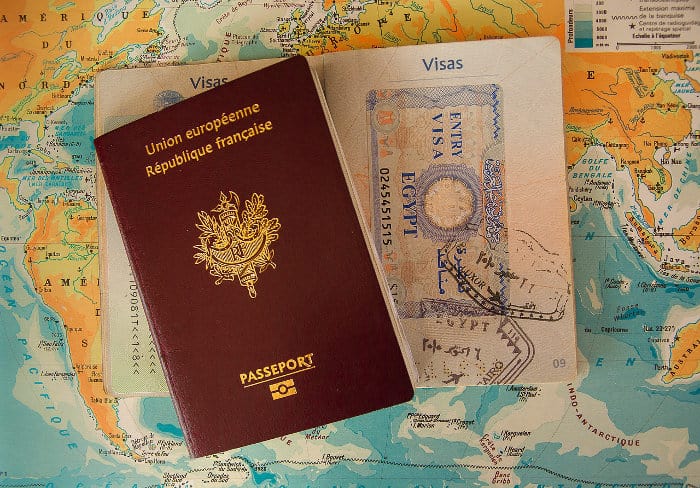
Everyone needs a passport to visit Africa. So I’m not presuming that you might forget it. But there’s three important things to consider :
1) Make sure your passport is valid for at least six months after your planned departure from Africa date.
2) Most countries require you to have two blank pages in your passport , although the immigration official may only use one.
3) Always carry a colour photocopy of your passport and keep a backup file online using a site like dropbox . You can also email yourself a copy of your passport for easy reference.
“…few can sojourn long within the unspoilt wilderness of a game sanctuary, surrounded on all sides by its confiding animals, without absorbing its atmosphere; the Spirit of the Wild is quick to assert supremacy, and no man of any sensibility can resist her.” (James Stevenson-Hamilton)
Document the wonders of Africa
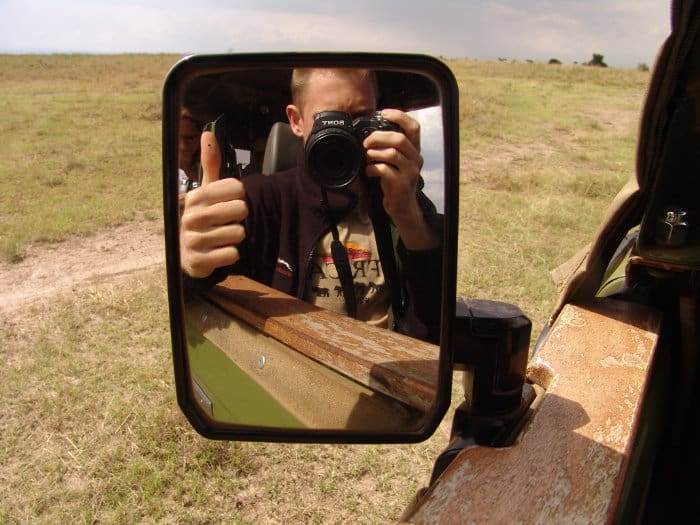
I’ll be honest. Photography is not my specialist subject . I’m the guy who usually prefers taking pictures with eyes wide open rather than the camera shutter. And while I’ve taken a few great snaps of safari, they won’t come close to wonderful photographers like Kerry , Gerry , Morkel, Greg , Andrew and Uwe .
In general, I’m a person who is enjoying the safari and taking a few photos of what comes along. But I have taken thousands of photos. So here’s five easy tips to help you decide the kind of equipment to bring on your safari.
1) Objective of the safari? Are you a serious photographer looking for incredible shots? Or just coming to enjoy the experience and capture some memories from the safari?
If it’s the former, you’ll need to have a good DSLR with at least two lenses . Great wildlife photography is challenging so you’ll need quality equipment that’s up to the task.
2) Lenses and zoom . While safari offers intimate encounters with wildlife, you won’t be able to get three meters away from all the animals. Most wildlife keeps a respective distance . So a good zoom lens is essential, whether you have a compact camera or a DSLR.
Use wide angles (18-35 mm) for picturesque photographs and super zoom lenses (18-200 mm usually does the trick; 28-300 mm for best results) for animal portraits and close-ups.
3) Stability . Zoom into the wildlife and it will be difficult to get a sharp image without some form of tripod. Standard tripods can be bulky and impractical when in a safari vehicle. So consider lighter ones that can be attached to a vehicle roof.
A great option is a pillow pod camera support ; these are portable and provide a soft cushion for resting your lens.
4) Extra memory cards . On some safaris I’ve taken well over 1000 photos. And I’ve seen lions and elephants before so I don’t need to photograph every single one.
On a first-time safari, some people can take tens of thousands of photos. So you’ll definitely need a spare memory card .
NB : Find out what might happen when you’re not fully prepared for the “unexpected” (watch Kai’s incredible video footage below).
5) Portable charging . Many safari vehicles have electricity outlets so you can charge on the go . It’s very handy for ensuring you don’t miss any of the action.
At the Serengeti National Park entry gate my father was in urgent need of going to the bathroom. He decided to choose a bush not very far from the car. About five minutes after he had come back I looked around. There was a huge male lion standing in the exact spot where my father had done his business. It was very close and a pressing need that could have been costly.
Hydrate, hydrate, hydrate
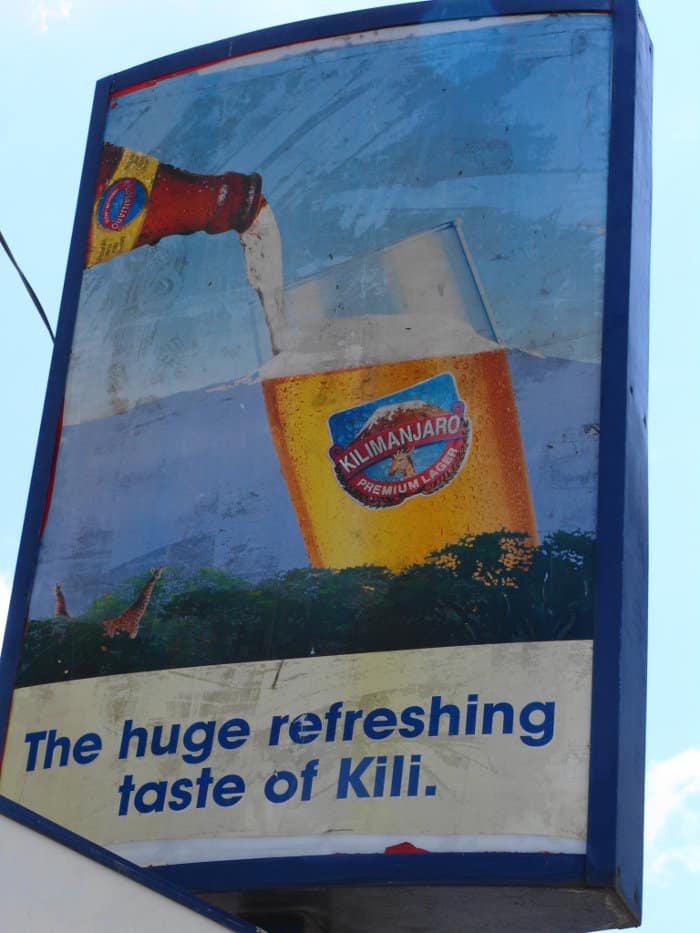
Perhaps the greatest health concern on an African safari is dehydration . Africa is hot and you’ll need to be drinking at least two litres of water a day , every day. Dehydration is a slow torture and once you’re dehydrated there’s no going back.
I like to take my own durable water bottle with me at all times. But on a walking safari, I would also recommend a bladder hydration pack .
If you have to remove the bottle from a backpack, then you reduce the willingness to drink. Yet with a pipe hanging over the shoulder , drinking water is always accessible and it helps you stay hydrated.
Mix up the itinerary and see Africa from different angles

For many people, safari is about driving around and checking out all the weird and wonderful wildlife in its natural habitat. Game drives are the core of most safari itineraries and they’re a wonderful opportunity to explore a landscape and all its residents.
Elephant herds, hippo pods, lion prides, monkey troops, giraffe towers; game drives allow you to cover large distances and discover a variety of habitats.
But game drives aren’t always the only means of exploration. Many safari destinations permit a variety of safari activities , each offering a fresh perspective on the landscape and the wildlife.
Where possible, consider an itinerary that incorporates these different activities. While you’ll be seeing the same wildlife, there’s a very different feeling to these experiences.
Nighttime game drives are always thrilling, encouraging you to follow audio clues and listen to the sounds of the savannah . While your field of vision is diminished, remember that a lot of wildlife won’t see you coming. So you can get much closer than normal.
For example, it’s completely black and you can hear rustling. Yet only when the guide switches on the spotlight do you discover that the two rhino are just five meters from the vehicle. Walking safaris (see W ) are another intimate and exhilarating experience.
How about a safari from the air in a hot air balloon or small plane ? It’s a great option for appreciating the scale of Africa’s large national parks and wilderness areas. From the air it’s easy to take in the raw splendour of the environment and pick out all the different herds that roam freely across the landscape.
To get further inspired about safari from air, how about seeing what a scenic flight over the Okavango Delta looks like? Or rising above the African plains on a balloon safari?
Horse riding and bicycle safaris are also possible in some reserves, usually those where there isn’t any threat from predatory cats. They’re a chance to blend into the landscape and get impossibly close to many animals.
Being in the saddle means you become part of the environment , rather than a noisy vehicle that’s interrupting it. So the herds don’t run away and you might be surrounded by hundreds of zebra or wildebeest.
“Africa – You can see a sunset and believe you have witnessed the Hand of God. You watch the slope lope of a lioness and forget to breathe. You marvel at the tripod of a giraffe bent to water. In Africa, there are iridescent blues on the wings of birds that you do not see anywhere else in nature. In Africa, in the midday heart, you can see blisters in the atmosphere. When you are in Africa, you feel primordial, rocked in the cradle of the world.” (Jodi Picoult)
Listen to the guide and never break the rules

Safari is very safe. Except that is, if you don’t respect the environment and ignore the rules . There are sporadic stories of tourists getting dragged through a car window and eaten by lions. Or of elephants flipping a vehicle filled with tourists.
Almost exclusively, these dangerous incidents happened because the tourists didn’t respect the wildness of the environment . Lions, elephants, and many other African mammals can be extremely dangerous.
They will accommodate and accept your presence. But leaving the car window open when approaching a lion pride is like leaving the fridge door open when you’ve got a pet cat. It’s an opportunity to eat and cats don’t usually ask permission.
Likewise, camera flashes are a great way to wind up nature’s largest land mammal. But an elephant will give two clear warnings before it charges , flapping its ears and stamping its feet to show irritation and annoyance.
So when an elephant flips a vehicle, it means that a) the tourists didn’t respect the rules about using the flash and b) they didn’t respect the behaviour of the elephant.
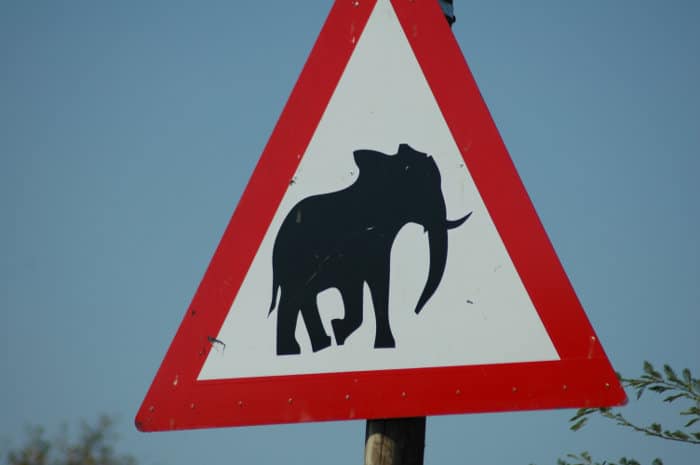
Respecting the environment is about respecting that you are just a visitor to this wild mystical realm . It’s about respecting that safari isn’t about interaction but observation and exploration .
That means not stroking lions, inciting elephants, feeding baboons, riding zebras, or challenging hyenas to a laughing contest.
It also means respecting the wildlife and staying quiet whenever you encounter any animal. Here are some more practical do’s and don’ts when you’re on safari:
- Pack out all your rubbish .
- Stick to the designated trails and definitely don’t wander off on your own .
- Do not feed any of the wildlife .
- Only drive on allowed roads and stick to the strict speed limits .
- Don’t hang out of any vehicle .
- Never take anything out of a national park.

Some recommended places to buy the best safari products
After a few years of trial and error I’ve narrowed down the list of good online safari shops to four. These shops stock almost everything you’ll need for a safari wardrobe along with the accessories that are essential for your adventure.
- Africa Adventure Safari Products – Buy books, clothing and travel gear to take on your trip.
- Kendrick Imports – Kendrick imports unique merchandise from Africa and claims to have personally road-tested everything they stock. It’s especially useful if you’re looking for Rogue outdoor gear or safari clothing.
- SafariQuip – The travel equipment and adventure gear shop. Their motto is “if it doesn’t work we don’t stock it”.
- The Safari Store – The specialist supplier of safari clothing, safari luggage, binoculars, safari books and safari accessories.
Other outdoor adventure stores to consider (for last-minute shopping in South Africa ): Cape Union Mart , Outdoor Warehouse , and Drifters .
Think about practicality and comfort
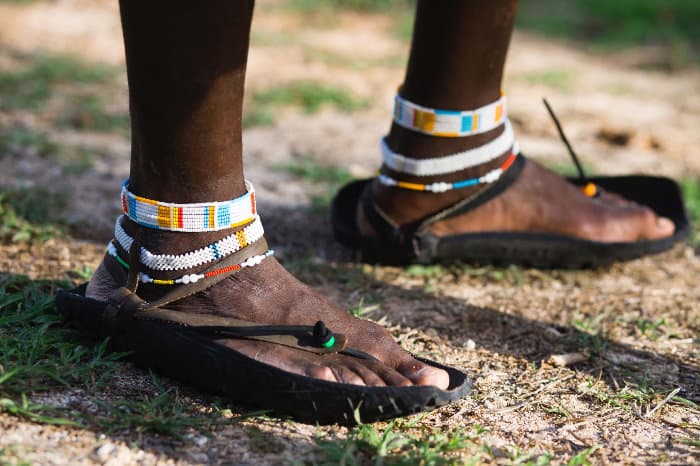
Most people come on African safari with their big thick walking boots, despite the fact that the most walking they’ll do is from the lodge to the car. There’s a presumption that the African savannah demands the biggest and most durable footwear around.
But did you know that San bushmen hunt animals barefoot? Or that Maasai warriors wear shoes that are made from disused car tyres? Of course, the savannah can be full of thorns, so I’m not recommending wearing slippers on safari.
Yet there’s no need to bring heavy uncomfortable footwear unless you’re actually going to be doing some walking on the safari.
For vehicle-based safaris it’s best to think about practicality and comfort . Safari vehicles in East Africa have pop-up roofs , so you’ll be standing on your chair to get a great view over the landscape. And you don’t want big dirty footprints all over the seat.
So shoes that are easy to slip on and off are good. If you’re just doing small walks around the camp then sneakers are more than adequate. Walking boots are very restrictive and sweaty in the heat, so your friends won’t be too happy when you take them off and smell out the vehicle or tent.
Plus, the funky scents can attract wild animals when you leave shoes outside the tent! I like to pack a pair of heavy-duty waterproof “bush slops” or sandals , which are good enough to handle walking in light bush and practical for staying cool on game drives.
It’s a different story if a walking safari is part of the itinerary. Then you will need something a little more durable . The landscape is rugged and uneven, so sturdy walking boots that cover your ankles and help protect against strains are a good idea.
Don’t worry about fashion or looks . Practicality and comfort are always the most important factors when choosing shoes for an African safari – just check out the tale of high heels below.
In the evenings it’s always nice to slip into a fresh pair of non-safari shoes – i.e. footwear that isn’t covered in thorns or all sweaty from the day. Basic flip-flops are good for walking around the camp and a pair of slip-on tennis shoes are even better as they protect your feet from the evening mosquitos.
During the great wildebeest migration I took clients to a luxury tented camp in Kenya’s Maasai Mara. It was a place for luxury clientèle and many of the female guests came to the restaurant tent in evening dresses and high heels . I felt a bit out of place in my dust-stained shirt, even if a wild lion could be heard shouting in the distance.
After sunset it was incredibly dark, with just the crackle of the fire and the piercing wheeze-honk of hippos keeping everyone company. Out of nowhere there was a loud scream . When the rangers shone their torch they found a female guest collapsed on the grass.
Walking back to the tent in the dark isn’t easy in high heels, especially on a landscape as uneven as the Mara. The lady had tripped and somehow managed to face-plant a pile of buffalo poo .
Turning red just isn’t cool

It’s almost impossible to go on a safari and not see a handful of tourists who are horribly sunburnt . The logic is simple and so many people fall for it. Many think that the sun in Africa is the same as the sun at home. Which technically it is, but the effect is very different.
The savannah isn’t a place for tanning oils or waltzing around thinking that the red burn “will turn brown later.” Not respecting the sun can lead to days of painful misery , and that goes for locals as well as tourists.
Namibia’s Himba tribe concoct sunscreen out of ochre and butterfat, while the Zulu people smear their faces in an orange-brown natural suncream made from the earth. So why do so many tourists come to Africa without sunscreen?
Factor 30 is the absolute minimum you should consider packing. Anything less can’t compete with the sun’s UV intensity. The African sun burns quicker than it does in Europe or America. Bring one main bottle of sunscreen and then one pocket-sized bottle that easily fits into your daypack.
Everyone has their favourite brands and there’s plenty of choice at shops in the West. Unfortunately, there’s only limited choice once you arrive in Africa. Bottled sunscreens for the local market often contain whitening, and while nobody wants to go red, few people want to turn whiter than they already are.
Good sunscreen is imported so it’s rare to find shops or pharmacies with more than just a couple of rudimentary options. Sunscreen is always the number one item on my packing list, because, well, I definitely don’t want to turn the same colour as a baboon’s behind (trust me, it’s not pretty).
“I’ve taken many guests to Botswana’s Central Kalahari in search of the zebra migration. 50 000 zebra are on the move but locating them in the desert isn’t easy, especially given the scorching desert mirages that always hang on the horizon.
I always remind my guests about sunset and wearing sunscreen. Not everyone listens. After a week on safari I take guests back to the city and some can’t believe their eyes. They almost turn into a zebra , with their whole body being white, except for a very dark brown stripe on their arm.
When you sit in the same place in the safari vehicle the whole time, one arm is always in the sun! So when I remind people of sunscreen I now make sure to tell them about also applying it to their arms.
Crucial for the nighttime trips to the toilet

When you’re camping in the bush, there’s a procedure to follow if you need the toilet at night. First , listen . Spend a minute checking if there’s anything rustling or moving around outside. Open the tent . Now shine a torch around the area , making sure there are no wild animals between you and the toilet.
Only now is it safe to leave the tent . Going to the toilet in the night isn’t the only reason a torch is an essential item on the packing list. Many camps don’t have electricity, so a torch is the only way to see where you are going , or even work out where the zip for the tent is.
I prefer a small lightweight torch that’s easy to carry. I also pack a head torch , which is handy in the evenings around the camp. Make sure it has a solid on-off switch that’s hard to accidentally push when the torch is in your bag – nobody wants to find that the torch is out of battery when the camp is surrounded by buffalo.
Rewarding those that create exceptional experiences
While working in the safari industry is considered a very good job in Africa, guides and staff get paid relatively low salaries . Tipping is an expected part of going on safari and many tour companies will offer guidelines on how much you should tip.
The problem is that tipping should always be reflective of the experience , rather than something that’s demanded. So I always like to tip dependent on how a guide or driver has made my experience. If they are good I tip well. If they’re not good then it seems odd to provide a large financial reward.
Realistically, it’s good to budget around 10% of the safari cost for tips . You might not end up giving all this out. But it always feels nice to reward great service.
“Nothing but breathing the air of Africa, and actually walking through it, can communicate the indescribable sensations.” (William Burchell)
Emergency money…just in case
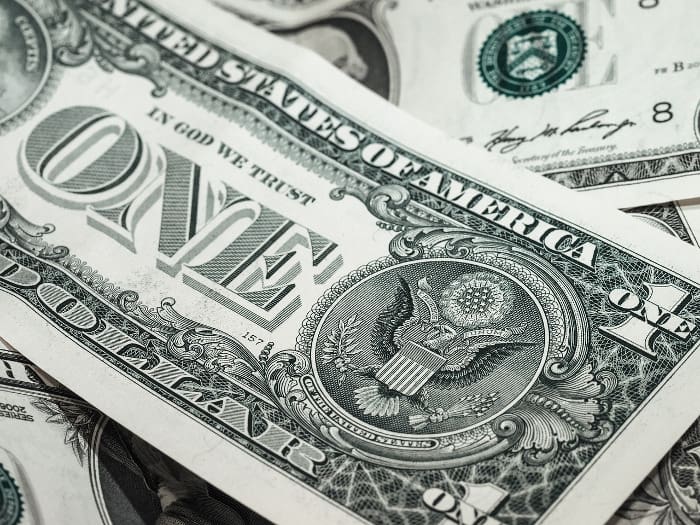
The traveller’s invisible law says that something will happen to your bank card only when you’ve run out of cash. And then you’re stuck in Africa, with no debit card, no cash, and not much that can be done about it.
I always like to keep a small stash of U.S. dollars hidden away in my bag. U.S. dollars are the most usable foreign currency anywhere in Africa ; they can be easily changed and even used to directly pay for goods and services.
Having $100-200 provides peace of mind and ensures there’s a back up for the time when your debit card gets chewed by an ATM.
Getting covered before you arrive
I’m not a doctor or a health physician, so I’m not going to recommend the vaccinations you will need for your trip. That’s something that can only be advised by your own doctor . However, after years of living in Africa I’ve had many different jabs and inoculations so I’m going to pass on my experience.
For most countries in Africa, doctors recommend vaccinations for hepatitis A, hepatitis B, tetanus, typhoid, and diphtheria. For Kenya , Uganda and a variety of other countries you’ll also need a yellow fever vaccination and certificate (see Y ).
This website is excellent at providing more detailed information for each individual country.
Some countries require advance planning

Entry and immigration requirements vary across Africa and whether you need a visa in advance will depend on your destination .
None of the main safari countries should pose any challenges if you have an E.U. , U.S. , Canadian , or Australian / New Zealand passport . But they might require advance planning.
Here’s a quick list with information that’s correct as of January 2022 .
Botswana – No visa required for a 30 day stay.
Ethiopia – Visa required. Can get it on arrival at international airports. Must get it in advance when arriving by land.
Kenya – An e-visa is required which must be obtained in advance from immigration.ecitizen.go.ke .
Lesotho – No visa required.
Malawi – Visa upon arrival.
Mozambique – Visa required. Realistically, this should be obtained in advance.
Namibia – No visa required for stays of up to 30 days.
Rwanda – Visa upon arrival.
South Africa – No visa required, but check the special requirements if you’re travelling with children.
Swaziland – No visa required.
Tanzania – Visa upon arrival.
Uganda – Visa upon arrival.
Zambia – Visa upon arrival.
Zimbabwe – Visa upon arrival.
==> Get Your Africa Visa Online Here!
“One cannot resist the lure of Africa.” (Rudyard Kipling)
Intimately experiencing it all from ground level
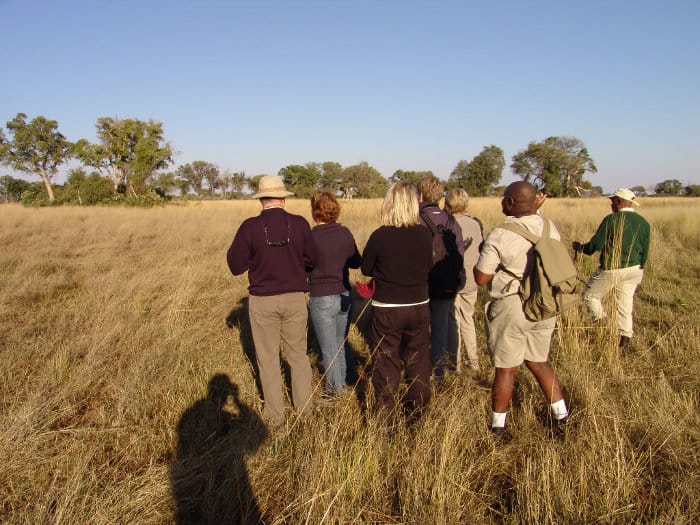
Walking safaris offer an exhilarating experience . Step, step, step, slowly you wander through the bush, usually with a local tracking guide who picks up on all the subtle clues.
Everyone can recognise a paw print in the sand.
But local trackers can feel the print and immediately tell you the size and sex of the hyena and exactly how long ago it passed along the trail. By following these local trackers you can seek out many herds and animals. And everything looks a lot bigger when you’re also at ground level.
Walking safaris are always intimate . You’re less of a threat on foot, so wildlife doesn’t necessarily run away. They also offer a true appreciation of size.
Hartebeest and gemsbok are impressive animals weighing almost half a ton. Only from the ground can you acknowledge just how big they are.
In some countries it’s also possible to take walking safaris that track rhinos or even elephants, rare treats on any trip to Africa.
On a walking safari near Kruger National Park we came across the remains of a buffalo. I had forgotten all about it, but when we returned later in the afternoon a huge male lion was finishing his supper.
It still gives me goose bumps thinking we had been there a few hours before and hadn’t seen any sign of his presence. And then this huge lion was literally licking the blood from around his lips.
Leave your devices at home and forget about Facebook
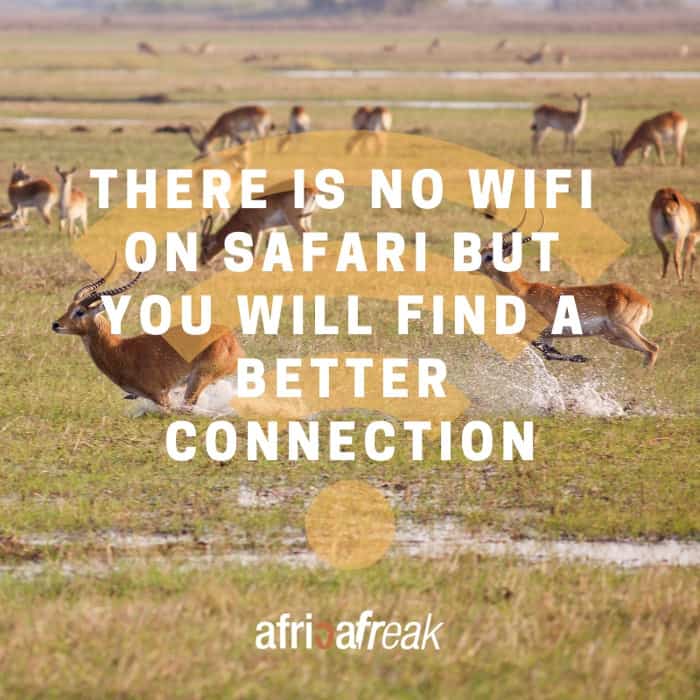
It often amazes me the number of tourists I hear complaining that a camp or lodge doesn’t have wifi . They’re on an African safari, 200 km from the nearest town, overlooking a waterhole filled with hippos and buffalo herds, and they are worrying about their Facebook status?
Sometimes you just have to let go.
First , there’s the practicalities of getting wifi in the middle of the wilderness. On a safari you enter vast untamed plains where the rhythm of life is dictated by the rains and the battle between predator and prey. So it’s hardly a place for interrupting everything with technology.
Secondly , one of the great charms of a safari is the absolute escapism . You’ll hear lions roaring at night, antelopes grazing beside the tent, and hippos grunting from the river. And that’s much easier on the ears than the ping that accompanies a Whatsapp message.
Trying to use wifi on a safari is always frustrating. Even when it is available, it’s torturously slow, especially if you want to upload photos or check a data-heavy Facebook news feed. And while you’re trying to connect the iPad you’re missing out on the procession of wildlife that’s roaming around.
It’s better to forget about the screen and fully settle into the wilderness. There’s a whole world going on before your eyes and it’s far more alive than the virtual world!
Encountering nature’s wildest animals
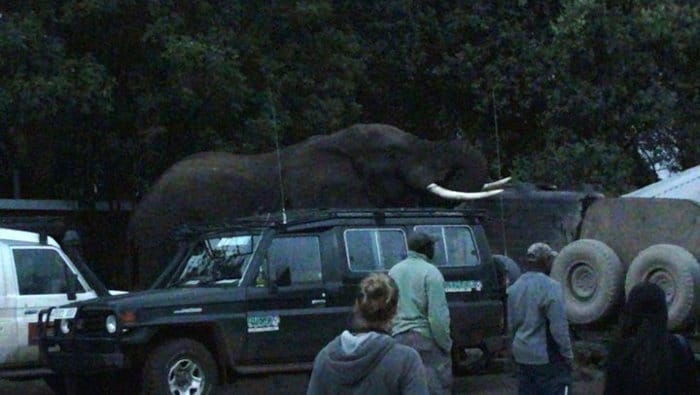
Africa can be a wild continent where dangerous cats run free and hippos live in the rivers. But it’s not completely wild. There are no lions on the airport runway and no rhinos wandering through villages. So the X-rated wildlife situations don’t start the moment you land.
However, in these wild landscapes there are always moments when you hold your breath and hope that one of Africa’s great mammals doesn’t take an interest. Such incidents provide a reminder that you’re just a visitor and this is their realm. And they always provide memories that will linger on for years.
On one safari I experienced an elephant that roamed into the camp and started rummaging through our bags . He stole a tube of Pringles and went through a bag with my friend’s iPhone! You can watch a video of this surreal experience here .
One year I crossed the border between Botswana and Zimbabwe. Although you’re not supposed to, I always liked to take photos at the border posts, next to the sign that says “welcome to …” It’s always a great memory. After crossing into Zimbabwe I walked up the road to snap the iconic green sign that declared I was now in Zimbabwe.
From my left came a loud trumpet sound . People weren’t the only ones crossing this border. The border post was on the migration route of hundreds of elephants. And this big pachyderm wasn’t happy that I’d got in the way.
I quickly ran back to the safety of the border guards, who were rolling around the floor in laughter after witnessing what happened. From then on, I’ve always respected the signs that say no photography at the border.
Fundamental if you’re visiting Kenya or Uganda
Yellow fever is a deadly disease that’s slowly disappearing from Africa. Fortunately, there’s an easy vaccine for yellow fever. However, this vaccination isn’t optional . In countries where yellow fever is prevalent, you’ll need to present a certificate of yellow fever vaccination at immigration.
Without one, they won’t let you in. Or you’ll have to get the vaccine from a nurse at the border post. The yellow fever certificate is required for anyone visiting Kenya or Uganda . It’s also usually asked for when visiting Zambia .
The most enchanting night’s sleep you’ll ever have
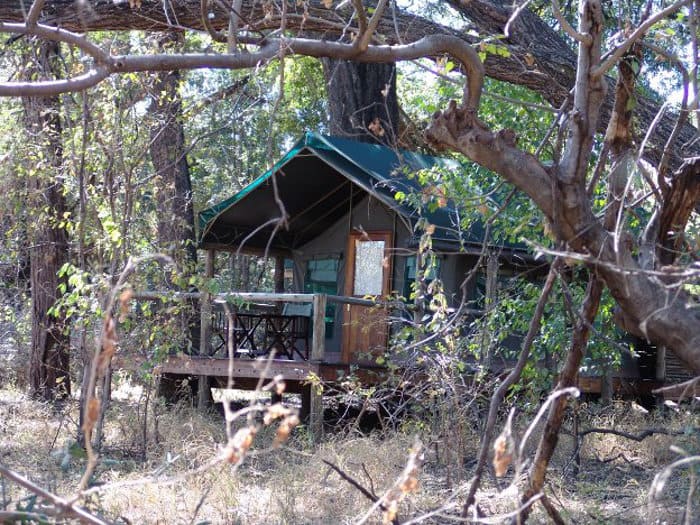
When the thrill of the game drive has slowly evaporated away and the nighttime fire is down to its last embers, you’re led in bed waiting to sleep.
Suddenly a noise .
A soft rustling sound.
Something is next to the tent.
You listen intently in the darkness, waiting for the sound to gently drift away.
Now another noise.
Some elephant trumpets are echoing from the distance.
Now a hippo’s wheeze-honk and the strange cry of a monkey .
More sounds are added to nature’s nighttime lullaby as you lie transfixed in the tent.
Don’t pack the sleeping tablets.
Don’t bring earplugs.
Falling asleep on a safari is one of life’s most enchanting experiences .
The safari hasn’t ended just because you’re in bed.
Nature’s chorus will keep you company and provide a reminder of exactly where you lay your head.
“To witness that calm rhythm of life revives our worn souls and recaptures a feeling of belonging to the natural world. No one can return from the Serengeti unchanged, for tawny lions will forever prowl our memory and great herds throng our imagination.” (George Schaller)
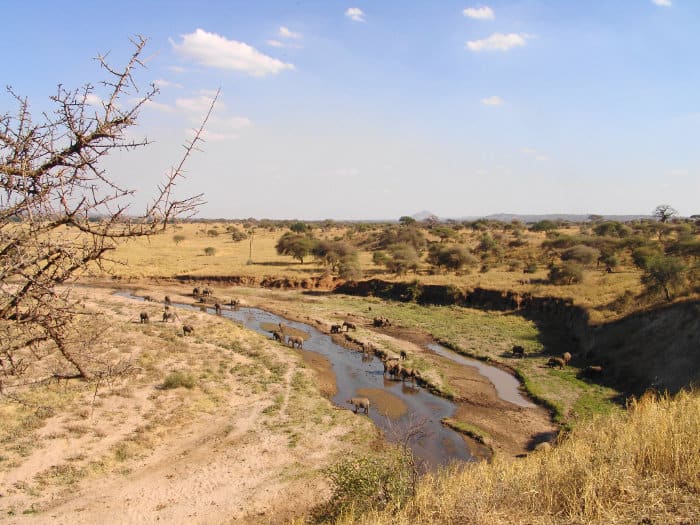
“When you leave Africa, as the plane lifts, you feel that more than leaving a continent you’re leaving a state of mind. Whatever awaits you at the other end of your journey will be of a different order of existence.” (Francesca Marciano)
Safari Njema (have a safe journey)!
Still around?
Congratulations for making it this far! 🙂
You deserve a little gift.
*** Download Your FREE eBook Copy of the Practical A to Z Safari Guide Here! ***
(right click and “Save Link As…” to save it to your computer)
Ready to Plan Your Dream Safari?
Get Your Free Quote Here!
Browser Security Check…

- Client Reviews
- Safari Blog
- Send an Inquiry
- Map of Africa
- Contact Details
- African Safari Cost
- Travel Insurance
- You are here
- The Budget Safari Blog
- What’s a safari and…

What’s a safari and what is a wildlife safari in Africa like nowadays?
Posted by Landia Davies on May 06 2022 in OLD African Safaris & Tours Enquire Now!
Of course, you've heard about African safaris and seen photos of celebs looking glamorous on safari in Africa. But, what is a safari really? And what is a wildlife safari in Africa like for the regular 21st-century traveller?
Here, we'll tell you all about African safaris and explain what a wildlife safari in Africa is like for most travellers nowadays. By the end of this post, you'll know what to expect on a wildlife safari in Africa today.
What is a safari?
A safari is a journey.
In the broadest sense, to go on safari is simply to travel . More specifically, a safari is a journey that involves going into nature to watch wild animals.

The roots of the word safari are Arabic (and later Swahili), but the modern concept of a safari originated in Africa. Today safari is synonymous with Africa.
Can you only safari in Africa or can you go on safari outside of Africa?
Yes, safari is an African thing. Although you can go on a safari-style trip in places outside of Africa, safaris are essentially African.
Africa is the home of the safari. This is where the classical idea of the wildlife safari was born and evolved. The safari is firmly rooted in Africa.

That said, you can go on 'safari' in Australia, India, Canada, the United States, and other countries. Of course, there are wilderness areas where you can see wild animals, all over the world. But, none of the wild places outside of Africa are quintessential safari territory. Elsewhere you find wildlife expeditions or wildlife tours (safari-style trips).
You can take trips into the wilderness anywhere, but you can only truly go on safari in Africa.
What is a safari in Africa, then?
A safari is the most famous and sought-after type of holiday in Africa. Going on safari is widely considered the ultimate 'thing to do' in Africa. Usually, a safari in Africa implies a wildlife safari.
In essence, an African safari is any journey into the wilderness to observe free-roaming wildlife.
This traditional definition of a safari in Africa has expanded over time, however. Nowadays any trip in Africa where you spend some time in nature looking at free-roaming animals can be called a safari.

In summary, a safari is a journey (or expedition) to look at wild animals, especially in East Africa and southern Africa.
A safari in Africa is not...
A wildlife safari in Africa is not a trip reserved for khaki-clad bushwhackers and experienced game rangers or scientists. You don't have to be an outdoorsman like Bear Grylls to love your time on safari. Just about anyone can thoroughly enjoy an African safari in the travel style that suits them best.

A safari is not the same as a tour of a wildlife sanctuary or animal rescue centre. Even in Africa, visits to wildlife havens or shelters are not safaris.
A trip to an African zoo is not a safari. A wine tasting tour in the Cape Winelands is not a safari. A township tour? No. A trip to meet the Omo Valley tribes in Ethiopia? Technically, not a safari. A road trip in Namibia? Also, strictly speaking not a safari - unless you visit a game park with wildlife, like Etosha.
An African safari is still different from a city holiday, beach vacation, historical tour, or cultural trip in Africa.
In Africa, a holiday only becomes a safari when you add an element of wildlife watching in nature. Be it game viewing by 4x4 safari vehicle, boat, canoe, small plane, or on foot, to name a few. Based on this broader definition of safari, boat trips and marine tours are often classed as 'ocean safaris'.

First, let's take a look at the traditional African safari and how it has evolved...
What does the word safari mean? (the origins of safari)
The word 'safari' originates from the Arabic word 'safara' which means 'a journey'. The Arabic word was later adopted by the Swahili of East Africa and adapted to become the Swahili word 'safariya' which means 'journey' or 'kusafiri' which means 'to travel'.
The English word 'safari' originates from the late 19th century. The word 'safari' was introduced into the English language as a foreign language word in 1858 and later adopted as an English word. It is said that the word 'safari' was introduced into the English language in 1860 by the legendary British explorer, Sir Richard Francis Burton. Then, in 1890 the English word 'safari' was added to dictionaries according to the Online Etymology Dictionary .
Today, traditional dictionary definitions of 'safari' still often include a component of hunting:
"...an expedition to observe or hunt animals in their natural habitat, especially in East Africa." and "A trip into any undeveloped area to see, photograph or hunt wild animals in their own environment."
Forget the old concept of a wildlife safari as a hunting trip - that outdated usage is history!
Safari now refers to an adventure or expedition into the wilds of Africa - with no hunting involved. African safari travel typically provides revenue for local conservation projects and game parks, helping to protect habitats and wildlife, rather than taking them out. African safaris also play an important role in creating awareness about wildlife conservation, as well as benefiting local communities.
A more modern definition of safari is, simply:
A safari (/səˈfɑːri/; from Swahili safari 'journey') is an overland journey to observe wild animals, especially in eastern or southern Africa. (Wikipedia)
The history of African safaris
The modern concept of the safari can be traced back to the early colonial era in Africa, from the late 1800s to the early 1900s. With the arrival of the first European explorers and colonizers came the first safari-style expeditions. Some of them aimed at exploring new territories, many for the express purpose of hunting animals.
On these early European-led expeditions, big game (large animals) were hunted and arduously lugged overland by a small army of local tribespeople.
Later, US President Teddy Roosevelt popularized the concept in the United States, when he embarked on a safari of enormous proportions , ostensibly with the aim of filling the Smithsonian Institute with African specimens. Some 11,400 Animals fell to the party's rifles, of which 512 were 'big game' - elephants, lions, leopards, buffaloes, hippos, and rhinos, including six white rhinos - rare even at that time.
Fast-forward to today and you will find that hunting is no longer part of most safaris in Africa. Thankfully the primitive pastime of hunting is largely something of the past. It is not the norm anymore and the vast majority of Africa has long moved on from this colonial-era practice.

Note: African Budget Safaris absolutely does not promote or sell hunting safaris, nor do we endorse hunting for sport. If you are contemplating a hunting safari, please consider opting for a wildlife-viewing safari instead.
The modern wildlife safari, making a difference in Africa
These days, most people have left the negative hunting connotations of safari travel behind. The outdated ideas of African safaris as hunting trips have largely been replaced by more modern concepts of wildlife safaris. The norm for a safari in Africa is now a socially and environmentally responsible form of travel.
Nowadays going on safari in Africa means taking an adventurous holiday and having a positive impact at the same time. Wildlife safaris now play a key role in sustaining African economies and protecting wildlife populations. So taking a safari holiday helps make a meaningful difference.

African safaris have become holiday trips that actually benefit the wildlife of Africa. As opposed to hunting wild animals, visitors get to encounter them and help protect them. Most safari tour companies and lodges either actively support (or run) conservation projects, or help generate tourism revenue which contributes to managing wildlife projects and game reserves in Africa.

Eco-safaris & eco-friendly safari travel in Africa
As environmental awareness has grown worldwide, African safaris have become more eco-friendly. Many safari lodges and tour companies have become more environmentally friendly in response to the sustainability challenges we face today.

Finding an eco-safari lodge or a low-impact safari in Africa is easier than ever before. Even the camps and safaris that aren't marketed as being 'green' or eco-friendly often are, in at least some important respects. The camps and lodges located in wilderness areas or national parks, for instance, are typically designed to have minimal impact on the environment and be as self-sufficient as possible due to their remote locations, national laws, and park regulations.
For eco-friendly safaris that reduce your carbon footprint and contribute to environmental sustainability, talk to us.
- More about eco-safaris in Going Green on Safari and Spectacular Eco-Conscious Safari Spots
Socially responsible safari travel in Africa
The modern African safari is a socially responsible journey. Not as an exception but as the norm. Not only does safari travel contribute massively to African economies and provide jobs, but it also helps improve social conditions.
Local communities across Africa benefit from sustainable tourism through social initiatives created and/or supported by safari organizations - from tour companies and lodges to activity providers, and game reserves. Safari travel also helps sustain small businesses and entrepreneurs selling goods (like local food, crafts, and curios) or providing services (such as guiding and entertainment).

Some safari companies directly support social upliftment projects and provide opportunities to interact with the local people. Others support local communities through the lodges, game reserves, and other companies they use.
- More about socially sustainable safaris in Responsible Safari: how to travel ethically
Safari travel's critical role in social and economic development
Africa's travel and tourism sector (of which the safari industry is an integral part) "employed more than 24 million people in 2019" based on World Travel and Tourism Council (WTTC) reports.
In particular, Africa's wildlife tourism industry, " usually generates $29 billion a year and employs 3.6 million people" according to Bloomberg (2020).
The safari industry generates some $12.4 billion in annual revenues for South Africa, Botswana, Kenya, Rwanda, Tanzania Uganda and Zambia - Africa’s top wildlife tourist destinations. (Reuters, 2020)
South Africa (which has the second-largest tourism industry in Africa) "relies on the tourism industry to indirectly contribute up to 9.1% of the country’s total employment – 1.5 million people – and 7% of its GDP" (Investment Monitor, 2021).
It is clear that safari travel plays a critical role in social and economic development in Africa. Not only through social upliftment and outreach programs but by producing substantial revenue and employment.
"During the past two decades, the hospitality industry has become vital to many African economies. In 2019 it accounted for approximately 7% of Africa’s overall GDP and contributed $169bn to its economy... according to the International Finance Corporation (IFC), part of the World Bank". (Investment Monitor, 2021)
In short, safari tourism "helps governments justify protecting wildlife habitat,” and “creates revenue for state wildlife authorities, generates foreign-exchange earnings, diversifies and strengthens local economies.” (Bloomberg 2020).
What African Safaris are all about these days
Today African safaris are holiday trips primarily aimed at watching and photographing wildlife in the bush, for fun.
Safari travel in contemporary Africa still implies game viewing and time in wilderness areas (game reserves, wildlife conservancies, and national parks). A traditional African safari is still focused on seeing African wildlife, but safaris are definitely not limited to game viewing.
In addition to game viewing and wildlife tracking, African safaris nowadays are about:
- the experience of being out in the bush (wilderness)
- exploring scenic places and natural wonders
- encountering the local cultures of Africa (old and new)
- visiting historical attractions and sightseeing
- volunteering and supporting good causes
- participating in adventure and outdoor activities ( adventure travel )
Once you're in the wilderness the safari truly begins. You'll spend most of your time enjoying untamed nature at the camps and watching animals in the wild.
Different kinds of safari trips offer a variety of ways to explore the wilderness and look for wildlife and birds. You can choose to explore by riverboat or canoe, on foot or by mountain bike, on horseback (even camelback) or quad-bike. The possibilities are endless with so many specialist safaris to choose from in Africa.

Big 5 Safaris in Africa, explained
The term 'Big Five' was originally coined by big-game hunters to refer to the most dangerous animals to hunt in Africa in the late 1800s.
Today, however, the Big 5 of Africa are the top animals that tourists want to see on wildlife safaris. The iconic African animals of the Big 5 are lions, leopards, rhinos, elephants, and buffalos.
Out of the Big 5 safari animals, only the buffalo is not threatened or endangered. Encountering the Big 5 African animals is now (usually) about the joy of observing them in their natural environment, learning about them, and taking photographs of them. A Big 5 safari is merely a wildlife safari that is focused on seeing and photographing the Big 5 animals of Africa in the wild.

What is a safari now? (in a nutshell)
The African safari has earned a new reputation. By large, the safari has evolved into a socially and environmentally responsible (often beneficial) style of travel in Africa.
Contemporary safaris encompass much more than the unforgettable experience of game viewing and staying in the bush. The 21st-century African safari combines wildlife encounters with a variety of fascinating and exciting travel adventures - from city stays and cultural interactions to beach getaways.
To plan your African safari adventures now, talk to one of our friendly travel experts .

Budget African Safaris to the best travel destinations
Southern africa safari & travel highlights:.
- Botswana Safari - Chobe Park, Okavango Delta, Moremi, Kalahari & Makgadikgadi
- Namibia Safari - Etosha Park, Namib Desert, Swakopmund, Fish River Canyon & Windhoek
- South Africa Safari - Kruger Park, Cape Town, Garden Route, Addo Elephant Park & KwaZulu-Natal
- Zimbabwe Safari - Hwange Park, Victoria Falls, Matobo National Park & Great Zimbabwe Ruins
- Zambia Safari - Victoria Falls, South Luangwa Park, Kafue National Park & Livingstone
East African Safari & Travel Highlights:
- Tanzania Safari - Serengeti Park, Ngorongoro Crater, Kilimanjaro, Lake Manyara, Selous Reserve & Zanzibar Islands
- Kenya Safari - Masai Mara, Amboseli Park, Lake Nakuru, Samburu Reserve, Tsavo National Park & Lake Naivasha
- Uganda Safari - Bwindi National Park, Kibale Park, Murchison Falls, Jinja & Queen Elizabeth National Park
- Madagascar Tours - Nosy Be Island, Andasibe Park, Montagne d'Ambre National Park & Masoala Peninsula
- Malawi Safari - Lake Malawi, Dzalanyama Forest, Liwonde Park & Nyika National Park
Too many African Safari options? Get in touch with us for up-to-date advice from one of our African safaris experts

“If there were one more thing I could do, it would be to go on safari once again.” - Karen Blixen (Author of “Out of Africa”)
[Article updated in May 2022]
If you liked this post, these trips cover similar ground…
- South Africa Walking Safari to Kruger & Zululand
- 8 Day Uganda Gorilla Safari from Kampala (Lodge Overland Tour)
- 9 Day Budget Masai Mara & Serengeti Safari - Tanzania & Kenya
- 3 Day Kruger Safari & Private Reserves Camping Tour
- Best of South Africa Safari Tour - Johannesburg to Cape Town
About the Author
Landia davies content manager & sculptor.

Similar & Related Blog Posts
Below you’ll find further reading and articles related or similar to this post.
How Much Does an African Safari Cost? Your Best Budget Africa Safari Guide
Luke Hardiman | August 28 2023
When is the all-round best time for African safari trips?
Ingrid Van Wyk | December 08 2020

What are Africa Overland Tours & Adventures all about?
Landia Davies | August 21 2018

10 Best National Parks in Africa - in the Top African Safari Countries
Landia Davies | March 05 2024

The Best Beaches to visit on African Safaris
Landia Davies | August 01 2012

Best Cape Town Safari: Big 5 game reserves near the city (on a budget)
Landia Davies | April 01 2024

11 Reasons to go on an African Safari
Landia Davies | July 21 2011
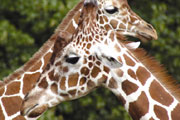
Most Endangered Animals in Africa - Where to See them & How to Help


African Safaris for Seniors? Safe & easy budget senior tours
Andrew Hofmeyr | January 16 2019

Size Up Africa Overland Safaris - Small vs Big
Landia Davies | July 30 2013
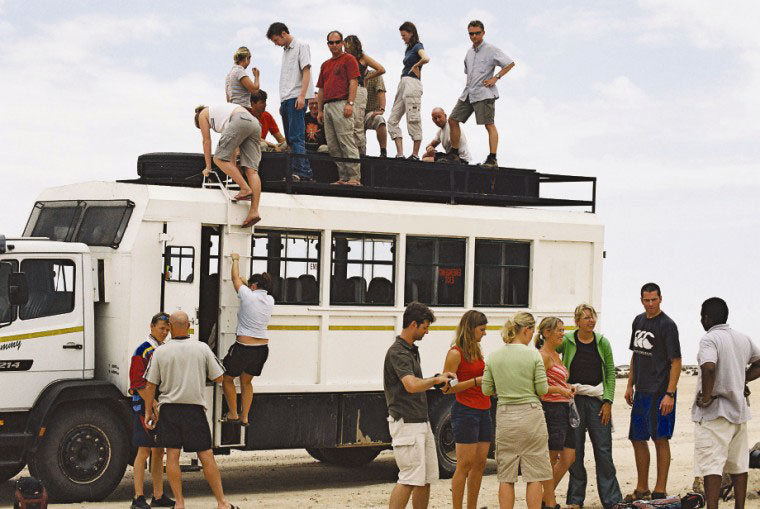
African safaris with kids made easy
Katherine Murphy | August 14 2018

Private Group Tours & Tailor-made Safaris on a Budget
Andrew Hofmeyr | July 05 2017

Private Group?
A private, tailor-made safari is within your reach. Experience all of your bucket-list safari related items on a budget now.

What is safari?
Where did the word "safari" come from and what does it mean? How are safaris of the past different from the modern adventuring in Africa? Where to go for the best experience? All about this type of nature vacation - by safari fans and experts.
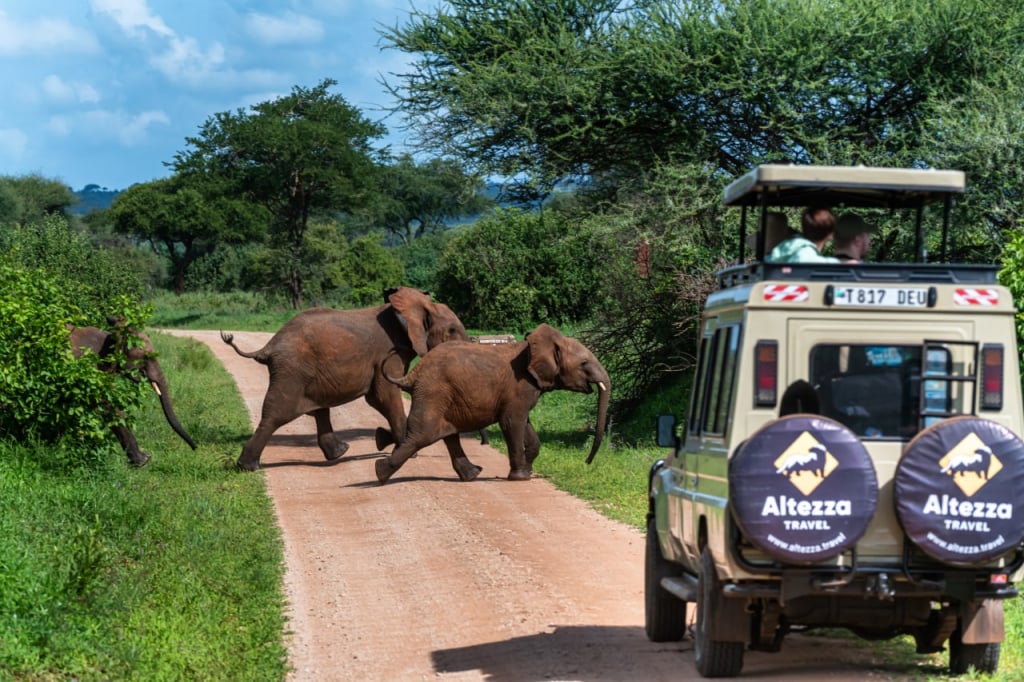
When we hear the word "safari," we imagine a group of tourists moving through an African savannah in search of large wild animals: lions, rhinos, buffalo, and elephants. In historical pictures, we often see men in pith helmets with guns in their hands, while modern pictures show people in SUVs holding long lens cameras. It is an animal hunt - hunting in the literal sense, or just observing and photo-hunting - in the vastness of the hottest continent. Fashion connoisseurs may also think of beige-colored clothing with a straight cut, the obligatory wide belt, and a wide brimmed hat, inherited from the British military who served in Britain's African colonies. All these are our first associations with the beautiful word "safari," which sounds like it could be an Arabic given name.
A modern-day safari is a sightseeing trip to an African national park, the main purpose of which is to observe wild animals. In the past, safaris were organized with the objective of hunting large animals. Africa's canonical Big Five: the elephant, lion, rhino, African buffalo, and leopard are associated with the hunting traditions of Africa. Among hunters, these five mammals were considered to be the most dangerous and difficult to pursue, and their body parts made the most coveted trophies.

Nowadays, hunting on safari is generally condemned by modern society. Altezza Travel advocates for ethical treatment of animals, participates in projects to rescue and rehabilitate animals, strongly condemns hunting, poaching, commercial exploitation and other unacceptable forms of interaction with animals and nature, which humiliate, first of all, the human dignity. We do not organize hunting safaris, do not work in hunting reserves, do not cooperate with companies that exploit animals, and we urge our guests not to finance such organizations and not to participate in activities involving violence and unethical treatment of animals. However, it is still permitted in a very limited number of reserves. This very expensive pastime is strictly regulated by law. So, the vast majority of safaris today are rides on off-road vehicles that go along the routes designated by national parks, where you can meet wild animals, gaze at them up close or through binoculars, take pictures and observe their behavior in the natural environment.
The word "safari" itself comes from Swahili - the main language of the people of East Africa. It means "journey, trip" and goes back to the Arabic word “safar” with the same meaning. In Swahili-speaking countries, the term refers to any journey. There is even a common phrase, safari njema! It is a wish for a good and pleasant journey.
How has safari become a popular pastime?
The Oxford Dictionary defines “safari” as “a trip to see or hunt wild animals, especially in east or southern Africa”. In the West, this word was popularized by the British traveler Richard Francis Burton, who explored East Africa in the 19th century with John Henning Speke and took great pleasure in learning the languages and customs of the peoples he met. Gradually the word “safari” spread into other languages and was used to refer to travel in the wilds of East Africa.
By the way, Richard Burton became famous not only as a linguist and ethnographer but also as a person who translated into English the ancient Indian Kamasutra as well as the Arabic and Persian tales of the Thousand and One Nights. Moreover, he was a rare non-Muslim pilgrim to Mecca and had to disguise himself as a sheikh or a dervish to secretly make those pilgrimages. Burton is also famous as the first European to discover the great African Lake Tanganyika, which stunned him with its beauty.
One of the most well-known historical African safari trips was the long expedition embarked upon by the 26th U.S. President Theodore Roosevelt. In 1909 he went to Africa The Smithsonian–Roosevelt African Expedition took Roosevelt from 1909 to 1910 through what is now the territories of Kenya, Uganda, the Democratic Republic of Congo, and Sudan. with his son and a large escort team for almost a year, just after his presidential term ended. Photos of Roosevelt on the hunt were printed in the newspapers, and a documentary about the trip was shown immediately upon his return. There is a book report of African Game Trails written by Roosevelt himself. We may be struck today by the list of animals killed on that safari, which is scrupulously given in the book. But the expedition was equipped by the Smithsonian Institution and allegedly had scientific motivations behind it.

The expedition brought back from Africa more than 23,000 specimens of plants and animals. It is recorded that 512 large animals have been shot personally by the president and his son, and a total of about 11,400 animals were killed or captured. It took the Institute eight years to catalog all the specimens. They became the basis of today's National Museum of Natural History in Washington. Therein lay the contradiction in Theodore Roosevelt's personality: his passion for hunting was joined with his desire to champion the interests of conservationists and scientists. It was he who founded the U.S. Forest Service. Roosevelt was also the first president to establish national parks and numerous protected areas in the United States.
"Roosevelt in Africa" documentary. Filmed in 1909. Library of Congress archives
Safari as a popular cultural phenomenon was heavily influenced by the American journalist and writer Ernest Hemingway. In the 1930s he traveled through Kenya and Tanganyika (as the mainland territory of present-day Tanzania used to be called). It is known that Hemingway was impressed by Africa’s stunning nature as well as by the magnificent Mount Kilimanjaro. Hunting was one of his passions - he hunted a lot in the Serengeti, as well as near Lake Manyara and today's Tarangire National Park. His love of nature and hunting influenced Patrick, the writer's son, who had been traveling with his parents since childhood. Patrick Hemingway eventually moved to Tanzania and lived there for 25 years. He also worked in Uganda and Kenya and even started his own safari business.
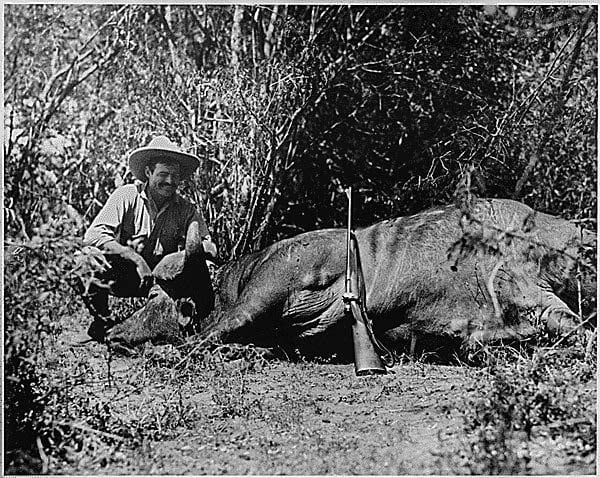
Ernest Hemingway's best-known "African" works are the short story "The Snows of Kilimanjaro '', and the "Green Hills of Africa" novella, which essentially is an autobiographical report of his family’s safari travels. His other drafts about Africa were compiled into the “True at First Light” book and published after the writer’s death by Patrick Hemingway.
Adventure novels on the topic of safari started to appear as early as the 19th century. We can remember the classic Jules Verne’s first novel, “Five Weeks in a Balloon”, which was about a journey in the air over Africa. We may also think of a popular novel by Henry Haggard, called “King Solomon's Mines”, about adventures in South Africa, or of the “World Voyage of a Young Parisian” by Louis Boussenard.
Another genre of literature that has preserved many early safari stories was adventure diary entries. Here one may think of William Kingston's “Adventures in Africa by an African Trader”. Allegedly those entries were written by a real but unidentified ivory trader and Kingston used those writings to compile a book. Another notable work of this genre was “Trader Horn: A Young Man's Astounding Adventures in 19th Century Equatorial Africa”, written by another ivory trader, Alfred Horne. Back then many parts of Africa remained unknown to Europeans, and such books fuelled the public interest in the exploration of the African continent with its incredibly rich geographical, cultural, and biological diversity.
The age of cinematography began in the early 20th century, and there were many popular adventure films set in Africa (most often in East or Central Africa) that also added interest to the topic of safari. The above-mentioned “Trader Horn” was adapted in 1931, although greatly augmented by fictional events. In the mid-20th century, the theme of jungle adventure was popular, and on cinema screens, you could see the African expanses being added alongside such locations as the jungles of Southeast Asia and the Amazon. Later, the 1985 film "Out of Africa'' starring Robert Redford and Meryl Streep had a major influence on the return to fashion of the safari style in clothing and interior design. It was based on the autobiographical book by Karen Blixen, who lived for many years in Kenya, and won seven Academy Awards and three Golden Globes, among other honors.
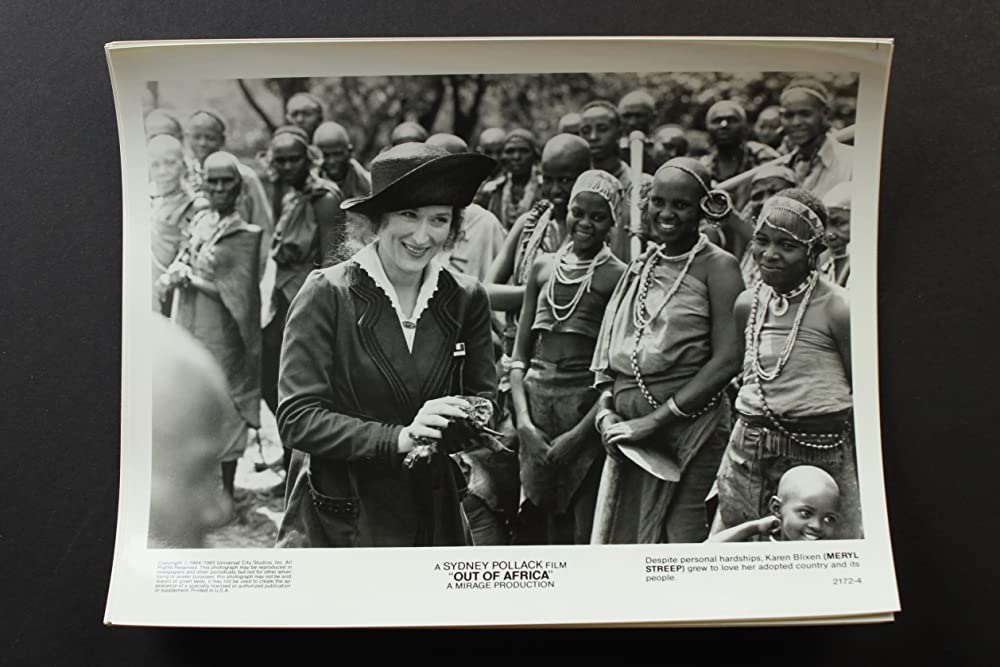
The growing interest in the modern type of safari travel was promoted even further by numerous documentaries, such as those from the National Geographic and Discovery channels, filmed in East African national parks, most notably in the Serengeti. Scenes of people driving through the savannah in an open car and observing various wild animals in their natural habitats while taking photos have encouraged many to plan their personal adventure - a trip to the great natural reserves of East Africa. Many travelers are also pleasantly surprised to find out that apart from driving in a car, there are numerous other ways of visiting the wild places of Africa.
What kinds of safaris are there?
A classic safari in today’s East Africa is a trip in an off-road vehicle with a driver-guide through the expanse of a national park where wild animals live in their natural habitats. The forests and savannas are roamed by herds of elephants, buffalo, zebras, and antelope of different species, as well as by giraffes which wander alone or in small groups. The trees are often occupied by monkeys and birds, while warthogs hide in the shade of bushes. Large herbivores are hunted by lion prides and solitary carnivores such as leopards and cheetahs. Jackals and hyenas choose smaller victims. Hippos and crocodiles hide in rivers from the heat. Travellers who go on safari have a unique opportunity to observe all those spectacular environments that are teeming with life.
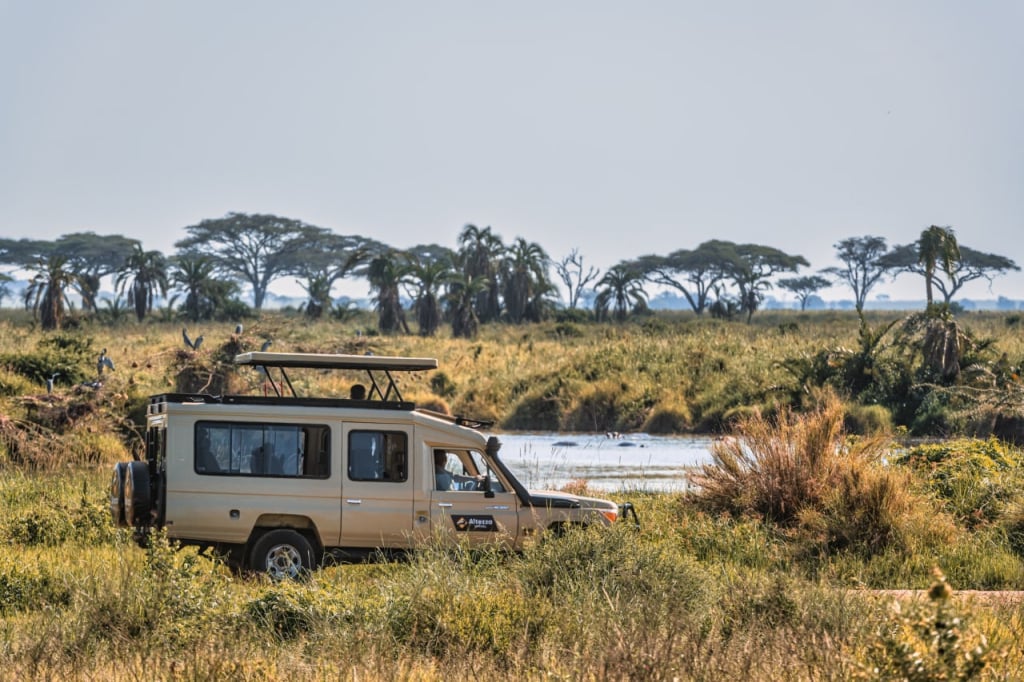
What are the advantages of driving around a national park in a car? This allows you to see a large number of animals of different species in just 2-3 hours. Also, when rangers find an interesting sighting such as a large pride of lions or a rhinoceros, they report it to the safari car driver by radio, so that you can quickly go there and see those animals. The off-road vehicle ride is the most popular safari format, but it is not the only one.
In some parks, where safety conditions allow, you can go on safari afoot. This is usually arranged in the areas where attacks by large animals are unlikely and there are no large herds grazing. For further safety, visitors are accompanied by an armed ranger. Safari walks allow you to get as close as possible to the natural environment of the park, observe the local plant world, and explore nature by encountering it directly.
One of the most beautiful and unusual ways to go on safari in Africa is to fly over the savannah in a hot air balloon. This will guarantee a thrilling experience for any visitors to a national park. Flying in the basket of a hot air balloon will allow you to marvel at the vastness of the landscapes below, and feel the true spirit of adventure captured in the pre-industrial era novels and travel diaries. Modern aerial safari is a premium type of recreation, which costs more than the classic car tours but guarantees amazing emotions and unusual angles from the bird's-eye view. A hot air balloon experience is often added as a "highlight" to a regular game-drive safari.
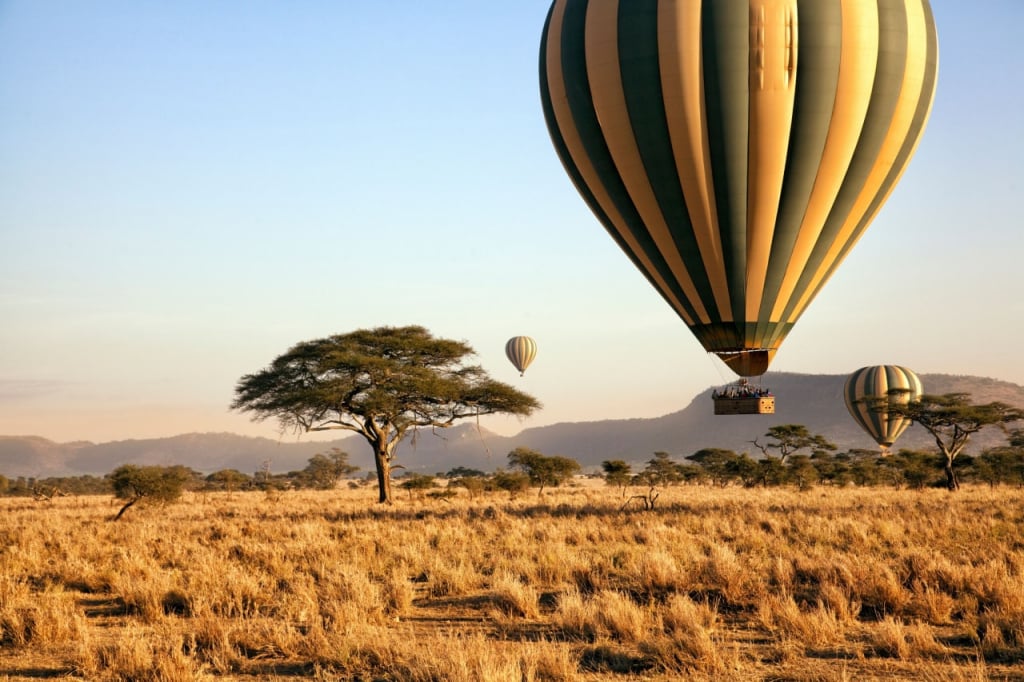
Another fantastic way to look at Africa’s stunning nature from an unfamiliar angle is by traveling on a boat over the surface of lakes, rivers, or even in the ocean. Riding a boat along one of the Tanzanian rivers, you will hear the guide telling you all sorts of interesting facts about crocodiles and hippos. And, of course, you’ll have a chance to observe those magnificent animals in close proximity! On a sea safari, you can go to various islands or ride a boat near the mainland. One of the highlights of a sea safari is getting close to dolphins and observing how those aquatic mammals play.
Where can you go on safari?
Perhaps the most famous destination for those wishing to go on a safari tour is the Serengeti National Park in East Africa. Many consider the iconic landscapes of the Serengeti to be the birthplace of the safari phenomenon. It is located in northern Tanzania. A natural extension of this national park can be found in neighboring Kenya, where it is called Maasai Mara National Reserve.
Another world-famous protected area can be found nearby: the Ngorongoro Conservation Area. It contains the world's largest ancient caldera which is truly a unique and breathtaking site. The famous zoologist Bernard Grzimek in his book “Serengeti Shall Not Die” called it a huge natural zoo. It is home to the “Big Five” game (elephant, lion, leopard, buffalo, rhino) and huge migrating herds of herbivore animals. The caldera’s steep walls make it seem like the animals are surrounded by a sort of natural enclosure.

Other notable parks and protected areas include Kenya's Amboseli and the Laikipia Plateau, Kruger National Park in South Africa, the Okavango Delta and Chobe National Park in Botswana, as well as Queen Elizabeth National Park in Uganda, among others. And we can also mention the famous national park in Zambia, Mosi-Oa-Tunya, and Zimbabwe's Victoria Falls National Park. While these two national parks aren’t large, their main advantage is that both are adjacent to the spectacular Victoria Falls. Another remarkable place that can compete with Victoria Falls in popularity is the renowned Mt. Kilimanjaro volcano, whose international fame helped to bring popularity to some less well-known Tanzanian national parks such as Arusha and Tarangire.
There are many more notable national parks in other countries of the continent. Safari has long spread beyond East Africa. Moreover, the name “safari” is frequently attached to tours in national parks of Asia, primarily in India, Nepal, Bhutan, and Sri Lanka. In India, for example, Ranthambore, Gir forest, and Kanha national parks are popular. The latter is considered to be the inspiration behind the Rudyard Kipling's “Jungle Book”, which is a story about an animal-raised boy named Mowgli. Generally, these days safari has become a global phenomenon. It is often used to name a journey into the wilderness anywhere in the world, even if it is in Australia.
Starting from the 1960s, so-called “safari parks” started to appear in different countries. Those are basically open-air zoos, where animals live in relatively large open areas. Visitors could enter such territories in their own cars or even on foot. Such experimental “zoos” first began in the U.S. and then in Japan, where you could ride past walking lions.

The first full-fledged safari park was Longleat Safari and Adventure Park in England. Today in that well-known place you can find ostriches, giraffes, antelopes, zebras, and other animals, not only those native to Africa. In the 21st century, there is a huge number of such safari parks around the world. The better places, such as Longleat, often invest in conservation, as well as rescue and rehabilitate animals, for example, those who spend their lives in the circus, like Anne the elephant mentioned above. But, of course, many parks are much worse and they can never be the same as the natural environment. The animals there are kept in captivity and frequently isolated, and some of those parks adopt the practices of contact zoos, which many consider unethical and harmful for the animals.
Real safari without violence towards animals can be found where it once originated - in Eastern Africa. Here animals live and thrive in their native environment without people trying to move them to other continents and intrude on their lives. Tanzania has made great progress in establishing national parks and reserves with clear rules and regulations for the visits into those protected areas, which helps to protect the country’s spectacular conservation areas. This, coupled with Tanzania’s outstanding biodiversity and natural beauty, makes it one of the best countries for safari tourism, if not the best in all of Africa.
If we search Instagram for hashtags and geotags with the word "safari" and then analyze the stats, we’ll see that there are three African countries in the top 10: Tanzania, South Africa, and Kenya. The first place is taken by the Victoria Falls National Park, where the main attraction is, of course, the spectacular waterfalls. But among true safari destinations, pictures from the Serengeti National Park are the most “Instagrammed” with over 160.000 photos tagged. All in all, Tanzania appears to be the clear leader when it comes to wildlife safari adventures.
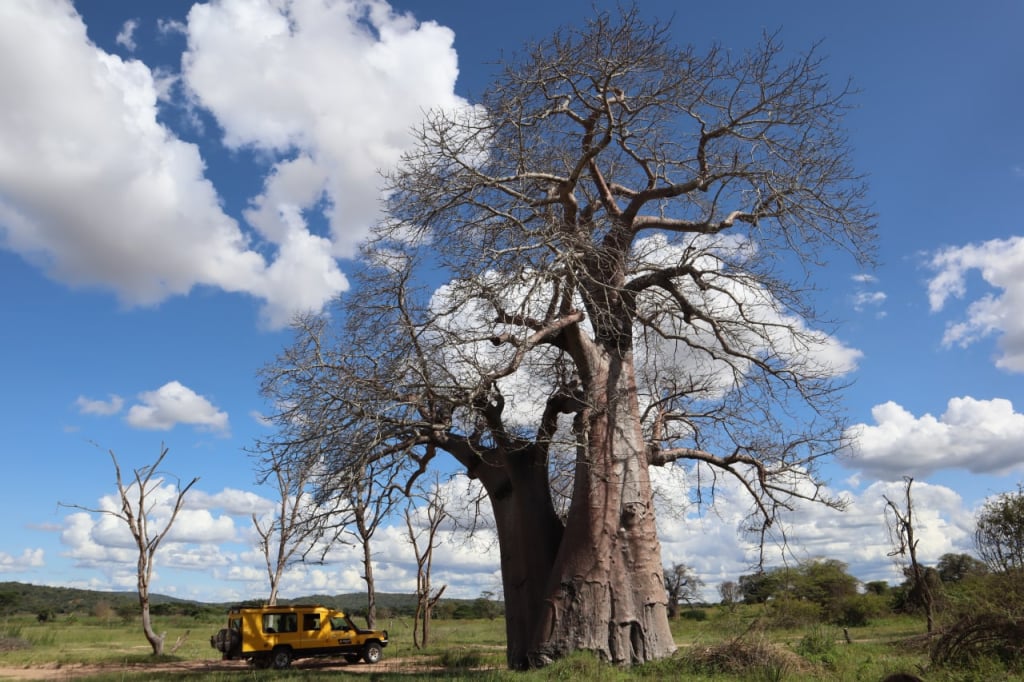
Active development of tourism in the country, high level of security, as well as availability of many other tourist activities can make your trip to Tanzania delightful, safe, and truly memorable. In addition to going on safari, you can learn about the folk traditions and culture of the local tribes in their villages, take tours to lakes, waterfalls, and other places of natural beauty, as well as explore or relax on the beaches of Zanzibar and other islands. Also, you could go to the diving sites off the coast in the Indian Ocean and observe underwater life with your own eyes. And, of course, there are expeditions to Mt. Kilimanjaro. By combining safaris with a variety of other activities, you can build a plan for the perfect African vacation while staying in the same country.
Welcome to the birthplace of safari - Tanzania, East Africa
The most popular protected areas in Tanzania are located in the north of the country, between Lake Victoria and Mount Kilimanjaro. We have already named them: Serengeti, Ngorongoro, Tarangire, Arusha, and Kilimanjaro National Park itself, whose main attraction is the eponymous peak, the highest in Africa. In addition to the Kilimanjaro trek, the north of Tanzania can offer guests two more interesting climbs - to the top of Kilimanjaro’s little brother, Meru volcano, and to Ol Doinyo Lengai, which is considered to be a sacred mountain among the local tribes. Among famous sites nearby there are also Lake Manyara National Park and three major lakes: Manyara, Eyasi, and Natron.
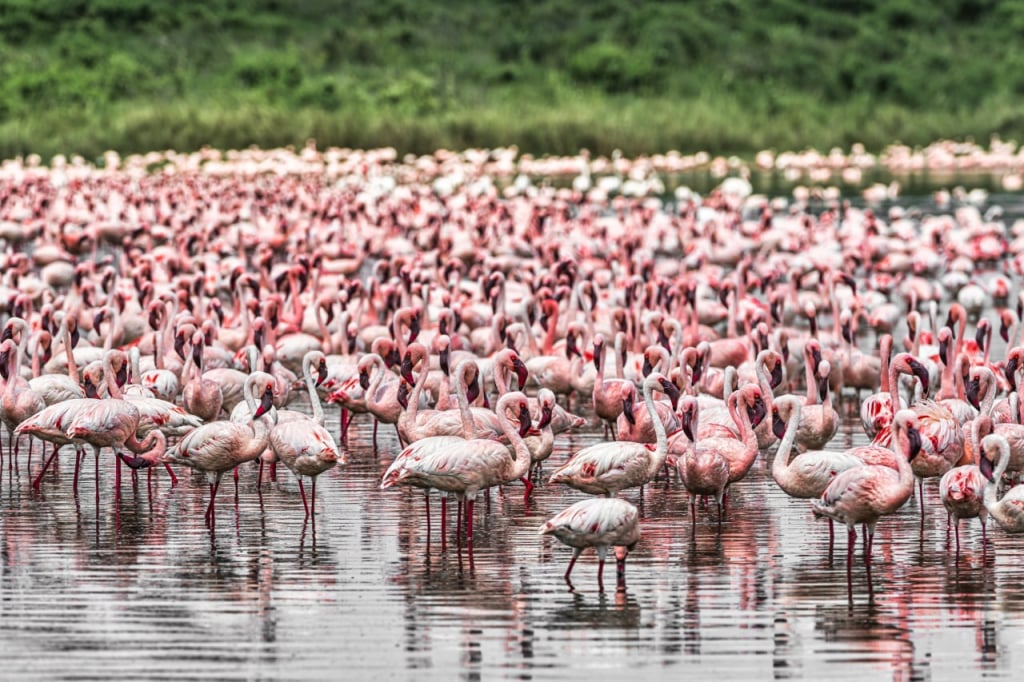
We have long specialized in the organization of nature tours in Tanzania and know all about local safaris. This is why we can confidently say that the incredibly rich travel opportunities of this African country are not limited to the most famous national parks we mentioned above. In the west of Tanzania, as well as in its central and southern parts, there are national parks and reserves that deserve attention. We can especially note Ruaha, Nyerere as part of the Selous, Katavi, as well as Gombe Stream, and Mahale Mountains, among other national parks and reserves.
How much time does going on safari take?
If you plan your trip to Tanzania well, you can ensure a great safari experience in several days, visiting the savannah expanse of the Serengeti with its Great Animal Migration, the famous Ngorongoro crater, as well as the wilderness of Tarangire, where herds of elephants roam among baobabs, the Great Ruaha River, in the waters of which many crocodiles and hippos hide, and the dense forest parks on the coast of Tanganyika, where researchers have spent decades observing chimpanzees.
A good safari trip would take several days. If you can dedicate a couple of weeks or more to your adventure - even better! Every major national park is absolutely worth spending a few days in, and sleeping in lodges A lodge is a hotel in Africa usually located in a wildlife area. Staying in such a place, you can feel closer to nature, and have much more convenient access to safari trips. Most often it is a complex of several houses for guests, which can either be solid buildings or comfortable structures with tent walls. As a rule, at the centre of this complex there is a restaurant which will provide excellent meals for you. The most comfortable lodges are located inside national parks, or nearby. Essentially, lodges are eco-hotels that always have high standards of service and of accommodation facilities. Some of them reach the level of 5 stars. right on the park’s grounds is a great experience. In that case, you’ll have the opportunity to go on safari in the early morning, and in the evening just before sunset. During these periods, the animals are the most active and playful. The majority of interesting scenes of animals interacting with each other usually take place in the morning and evening hours, when they aren’t forced to lazily seek shelter in the shade to avoid the scorching sun.
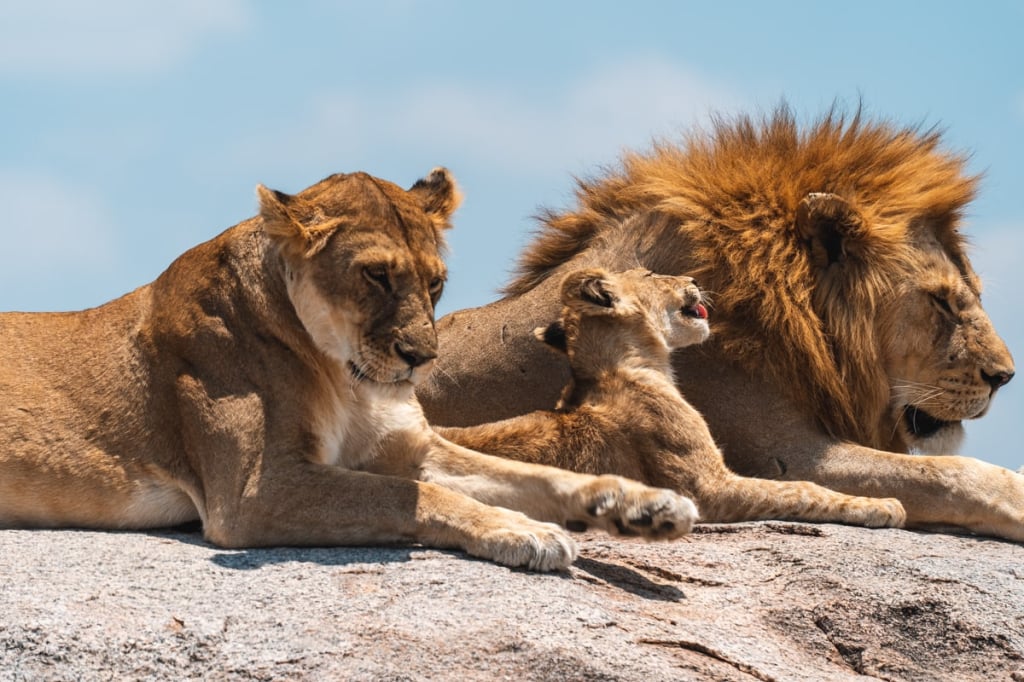
The incredible diversity of Tanzania’s flora and fauna allows for a variety of experiences. If you have the opportunity to stay on safari for longer than two weeks, don't miss that chance. Theodore Roosevelt spent almost a year in Africa, Ernest Hemingway came twice, and each time it was an extended trip.
All I wanted to do now was get back to Africa. We had not left it yet, but when I would wake in the night, I would lie, listening, homesick for it already.
Ernest Hemingway, “Green Hills of Africa”
What to expect from your safari trip in Tanzania?
There are three elements to a safari trip: safari vehicle rides, rest at one of the nearby hotels, and transfers between the hotel and the national park. Good planning allows you to minimize transfer time so that you will have more time to enjoy the main activities or rest.
Typically, it’s a good idea to stay within the same park for at least three days, ideally five days. This way you can experience the best things a park has to offer, visiting the interesting places that are often missed by hurried tourists.
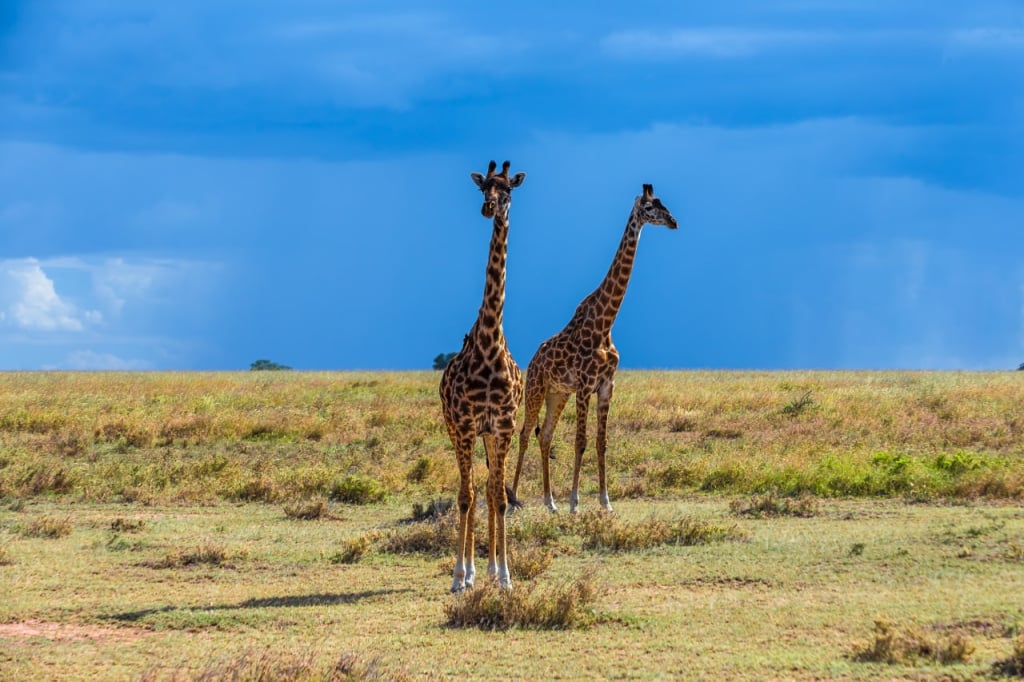
When choosing hotels, we strongly recommend that you pay attention not so much to the number of stars or interior details, but to the specific conditions you’re looking for in your accommodation. A very important factor is the hotel’s location. A lodge located within a national park often wins even against a luxury hotel in the nearest town. Time spent in transfer should be kept to a minimum, this will allow you to experience more of Tanzania’s spectacular nature. The opportunity to be deep in the park in the hours of the early morning is priceless! And the overall impression at the end of the safari is made up of these individual episodes.
An ideal safari day can be described as follows: the guests wake up early, shower, and take a safari vehicle to the park, taking their lunchboxes with them. This way it’s possible to see the morning predator hunt and lots of animals standing or laying down right on the road or nearby (before dozens of other safari vehicles have arrived). Shortly after that visitors can enjoy an outdoor breakfast at one of the park's picnic sites. Later, they ride some more around the park and return to the lodge for lunch. After lunch, the guests rest in the cool rooms while it is hot outside, and in the afternoon they go on safari again. Again they see many different animals, take beautiful pictures and return to the lodge as it is getting dark. In the evening they enjoy a delicious dinner, cozy outdoor gatherings, and a nice rest before going to bed.
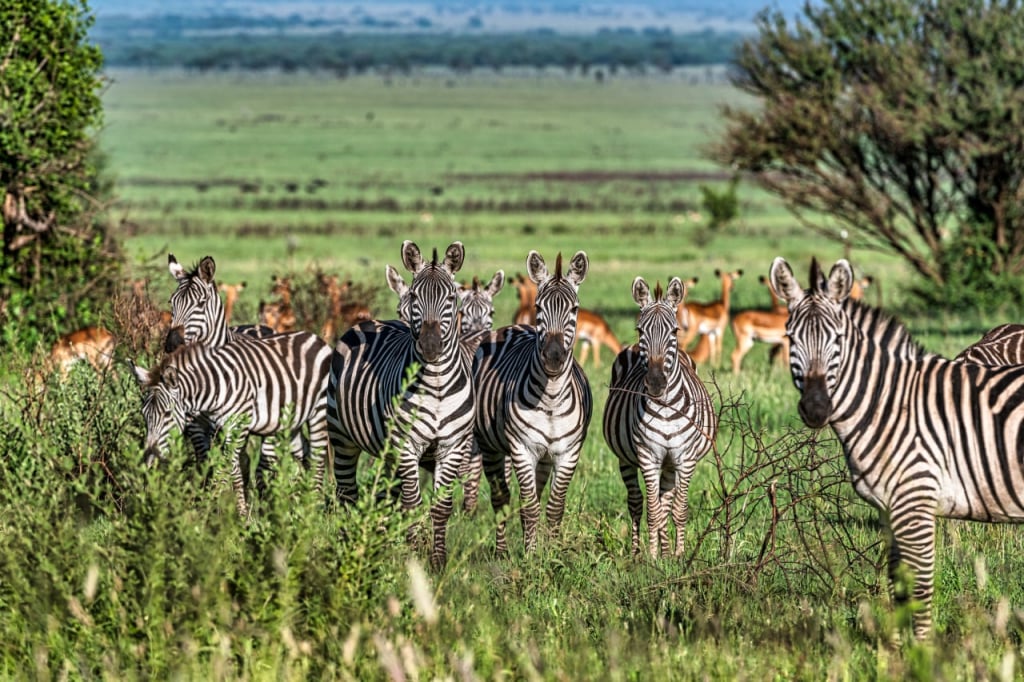
When is the best time to go on safari?
Tanzania is amazing because it is located near the equator and has several geographic regions. This means that you can travel here at any time of the year, as long as you don't set a specific goal, such as seeing antelopes forcing the rivers of Serengeti, which falls on June-August, during the Great Migration. However, Tanzania’s climate and weather conditions allow you to observe animal life almost all year round.
If you are worried about the rainy seasons, let us reassure you - the seasonality of rainy and dry periods in Tanzania these days is rather arbitrary. In any case, some rain very rarely prevents our guests from enjoying a safari. In addition, the so-called rainy season has many advantages, the key ones being the absence of crowds of tourists on popular trails in the parks, and lower hotel prices.

If you can't wait to start planning your safari trip to the heart of Africa, check out Altezza Travel's safari programs. While we offer numerous different tours, a customized program can be even better. Just contact our managers and ask them to put together a program that will be the most suitable for you. A couple of short articles with practical tips may also be helpful: on how to prepare for a safari in Tanzania, and what to bring with you on your trip.
Don't hesitate to ask questions, and feel free to ask us to expand your safari tour program - Tanzania has a lot to offer. We look forward to seeing you on safari!

Valentina, a creative artist with Altezza Travel, draws inspiration from Africa's natural wonders, dividing her time between Tanzania and South Africa. With over 8 years of living across various African regions, she offers invaluable insights and practical travel tips on our blog for those eager to explore this remarkable continent. Having immersed herself in numerous cities, towns, and villages, Valentina has a rich knowledge of African culture, community, and life.

Is there any age limit on safari? My son will be 6 this year
Hi Sandi! You question has inspired us to write a detailed article about it!
To give you a short answer:
1.There are no age limits set by the National Parks.
2. Some lodges and camps have age restrictions, some not accepting children under 5 years old.
3. Ultimately, it depends on your child. Even 3-year-olds can enjoy a safari, while a 14-year-old teenager might be bored and spend all their time on their smartphone. It all depends on the child's behavior. There are even a lot of adults who aren't interested in wildlife. However, we believe that taking kids on an African safari can really spark their interest in wildlife and exploration. Just keep in mind that safaris involve dust, rough roads, and hot sun.
We've had many families go on safari with their kids and they've enjoyed every single day in Tanzania. It's really like the Lion King movie - kids will see elephants, giraffes, zebras from a very short distance from the car - they will definitely fall in love.

- South Africa
Polar Regions
- Bwindi National Park
- Kruger National Park
- Lofoten Islands
- Okavango Delta
- Ranthambore NP
NATURE TOURS
- Archipelagos Tours
- Deserts & Shrubland
- Northern Lights
- Polar Scapes
Leisure Tours
- Beach Resorts
- Diving & snorkelling Tours
- Heritage Resorts
- Mountain Resorts
- Snow Activities
- Snow Resorts
- Water Activities
- Wellness Tours
- Wildlife Resorts
Wildlife Tours
- Bear Tracking
- Big Cat Safaris
- Birding Tours
- Elephant Safaris
- Leopard Safaris
- Lion Safaris
- Tiger Safaris
- Unique Wildlife
- Wildlife Cruises
- Wildlife Safaris
Cultural Tours
- Architecture
- Art & Crafts
- City Trails
- Culinary Tours
- Fairs & Festivals
- Fort & Palaces
- Monuments & Museums
- Palaces of Worship
- Tribals Interactions
- Village Visits
Type of Journey
- Deep ocean Adventures
- Exploration Journeys
- Luxury Tours
- Friends & family Tours
- Rares species Tours
- Romance Tours
- Photography Tours
- Trekking Expeditions
TOP EXPERIENCES
- Big Cat Journeys
- Fairs & Festivals
- Heritage Stays
- Polar Journeys
- View all Itineraries
- View all Fixed Departure
- +1-646-583-2666
- Guest Login
- Agent Login
- Type of journeys
- Refer a friend
- Be an agent
- Holiday finder
- Image Gallery
- Video Gallery
- Guest Reviews
- In the media
Top Experiences
Top destinations.
- Kruger national park
- Ranthambore
- Serengeti National Park
Type Of Journey
- Rare species Tours
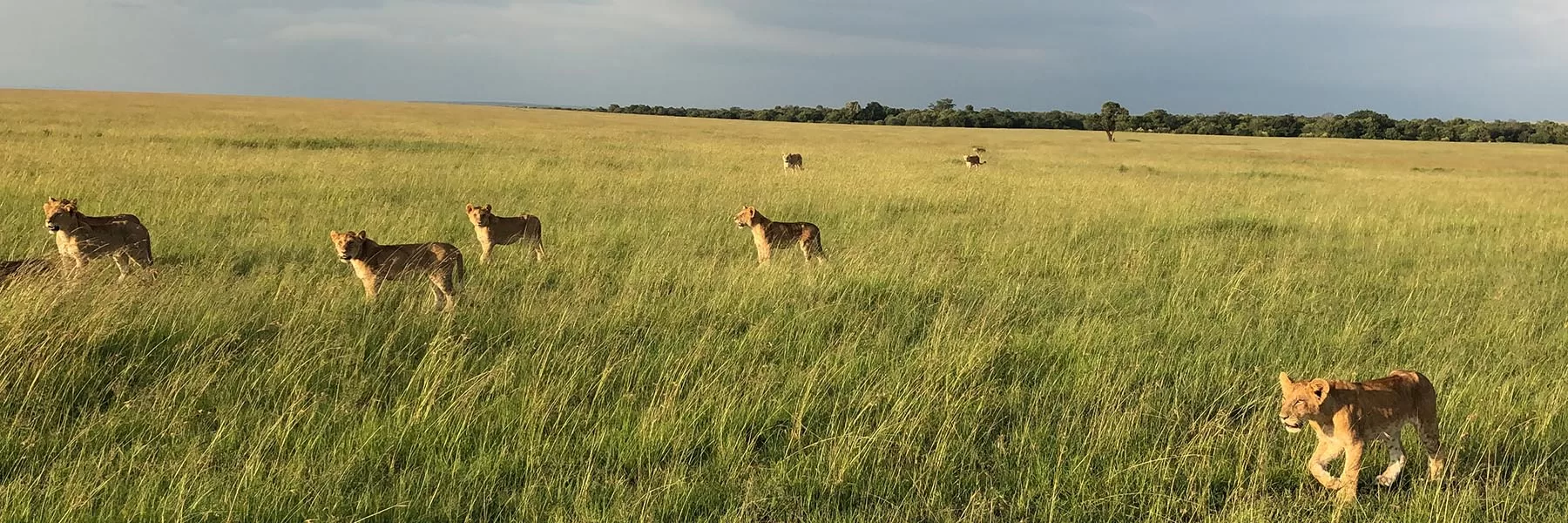
- Origins of African Safari
Out of all the places, Africa is chosen as the number one destination to enjoy genuine safaris due to its richness in flora and fauna. African safaris have a huge impact on the continent’s tourism industry. Millions of tourists from all around the globe visit Africa to witness the beautiful wildlife species in the wilderness. Whether it is the animated movie ‘The Lion King’, released in 1994, or the documentary safari movies such as ‘BBC Africa’ released in 2013, people are aware of the African continent’s overflowing beauty.

Giraffes in Tanzania
During earlier times, African safaris were captured in films and photographs. Only the privileged were allowed to travel to Africa and embark on safaris. However, the African safaris of the past were entirely different from what we see today. Having an understanding of the origins of African safaris is helpful in enhancing your next trip to the continent. Here is a brief history of safaris in Africa :
The meaning of ‘Safari’
Safari is a Swahili word that means ‘journey’. It originally emerged from the Arabic noun ‘safar’, which means travel, journey, or trip. The verb ‘to travel’, when translated in Swahili, is ‘Kusafiri’. In its original context, safari referred to the long travel distances people would undertake for trade or any type of migration. Presently, safari is often connected with luxury lodges, tents, game drives, backpacking, and more.
The origin of African safaris
Today, people undertake African Safaris as overland journeys to observe diverse animals residing in their natural habitats in different parts of Africa. However, this was not the case hundreds of years ago.
The earliest record, or primary interest, focused on the trade or trading routes of safaris. The African and Arabic cultures were closely intertwined, indicating that people or traders travelled long distances across different cities to spread their cultures. It was during the 18th century that trading flourished and became a successful business. Unfortunately, along with commodities, people were also traded and sold. During the colonial period, European safari caravans entered the scene, involving large-scale operations, such as substantial crews, supplies, and weapons.
Fortunately, this safari, synonymous with the slave trade, ended before the 20th century and changed its focus from business to exploration. Missionaries, adventurers, and explorers wandered throughout Africa and marvelled at the richness of the continent. Early naturalists redefined the purpose of safari and helped in discovering, identifying, and studying various species of animals, birds, and plant life.
Hunting safaris
With the new change in safaris, however, came hunting expeditions born in East Africa. The word ‘safari’ carried a negative connotation: a journey enjoyed for hunting or the hunting of animals. Instead of the elaborate safaris seen in the present, Europeans embarked on wildlife safaris not just to witness animals up close but also to hunt them. So, hunters came along with naturalists, and ‘hunting’ became a common association with safari. These hunters collected animals like trophies and boasted about conquering them. In many cases, there were year-long expeditions where wealthy Western travellers explored Africa with a rifle strapped to their backs.

Ernest Hemmingway during one of his hunts in Africa
During the years 1837-1901 (the Victorian era), people greatly witnessed the event of hunting safaris or trophy hunting. Explorers, traders, and aristocratic sportsmen generally told back stories about the epic adventures of hunting animals in Africa, which fascinated the common people. Hunters such as William Cornwallis Harris not only targeted the big game, which is Lion, Leopard, Elephant, Black Rhinoceros, and African Buffalo but also documented their killings to showcase them to the public.
Similarly, writer Ernest Hemmingway hunted different animals and described his experiences in the novel ‘Green Hills of Africa’. The members of the privileged classes in America and Europe greatly enjoyed these instances that romanticized hunting on the African continent.
A shift to modern safari
While Harris was famed for his infamous hunting, he was also responsible for introducing the movement of conservation. Which helped save pillaged areas of Africa and the local wildlife. Protecting the wildlife also meant changing the customs of the local cultures in East Africa. Few indigenous groups hunted the lion as a tradition to perform rituals. As animal species became endangered, the local government started cooperating with local tribes to put an end to such hunting practices.

African safaris in the present times
Going on safari today has a different connotation. Modern-day safari in the present means actively participating in sustaining African economies, supporting wildlife conservation, and supporting the local communities. In the African savannah, safaris continue to occur with the aim of wildlife viewing, but instead of using weapons, the participants capture animals through cameras.

A modern day African safari
Safari companies actively contribute to conservation projects or generate tourist revenue, which they use to manage game reserves and wildlife schemes in Africa. The emergence of eco-tourism has led to the development of environmentally friendly safari travel. In addition to game drives, visitors can enjoy experiencing local African cultures, exploring natural wonders, sightseeing, and participating in various outdoor activities.

A ranger observes elephants at Djuma Game Reserve, South Africa
The African safaris of today are all about conservation and strengthening the local communities. There are several positive trends that are transforming traditional safaris for the better. Some of them involve empowering local women, stronger community action, anti-poaching innovations, the emergence of lesser-known safari destinations in Africa, and sustainable sightings.
The 21st-century African safari offers unforgettable memories in the African bush, once-in-a-lifetime animal encounters, and authentic cultural interactions. As Jonathan Safran Foer aptly remarks, ‘If the thrill of hunting were in the hunt, or even in the marksmanship, a camera would do just as well.’
If you loved reading this story, then subscribe to our blog here (it will ask to verify your email) to get inspiring travel stories and trivia delivered to your email. Stories about wildlife trivia, cultural experiences, curated luxury hotel lists, underrated places to travel, polar journeys and much more.

The content team at Wild Voyager. We are passionate to bring you travel stories and unique experiences from around the world. Spread the love and feel free to share these stories.
Similar Posts
All about leopards, best time to witness the great migration in kenya, luxury trains of south africa, top things to do in laplands, mountain gorilla trekking: all you need to know, enquire now.
Our travel experience designers will reach out for consultation. By submitting, you confirm that you agree to our privacy policy .
Follow us on social media

Subscribe to newsletter and stay updated
Read about our travel expeditions, new destinations, new pictures, latest trip schedules

© Copyright 2024 Wild Voyager Pvt Ltd.
Terms | Privacy | Contact
- Cambridge Dictionary +Plus
Meaning of safari in English
Your browser doesn't support HTML5 audio
- air corridor
- amenity kit
- caravanning
- high season
- phrase book
- post-holiday
- put something up
- ranger station
- tourist trap
- trailer park
You can also find related words, phrases, and synonyms in the topics:
safari | American Dictionary
Examples of safari, translations of safari.
Get a quick, free translation!

Word of the Day
veterinary surgeon
formal for vet

Dead ringers and peas in pods (Talking about similarities, Part 2)

Learn more with +Plus
- Recent and Recommended {{#preferredDictionaries}} {{name}} {{/preferredDictionaries}}
- Definitions Clear explanations of natural written and spoken English English Learner’s Dictionary Essential British English Essential American English
- Grammar and thesaurus Usage explanations of natural written and spoken English Grammar Thesaurus
- Pronunciation British and American pronunciations with audio English Pronunciation
- English–Chinese (Simplified) Chinese (Simplified)–English
- English–Chinese (Traditional) Chinese (Traditional)–English
- English–Dutch Dutch–English
- English–French French–English
- English–German German–English
- English–Indonesian Indonesian–English
- English–Italian Italian–English
- English–Japanese Japanese–English
- English–Norwegian Norwegian–English
- English–Polish Polish–English
- English–Portuguese Portuguese–English
- English–Spanish Spanish–English
- English–Swedish Swedish–English
- Dictionary +Plus Word Lists
- English Noun
- American Noun
- Translations
- All translations
Add safari to one of your lists below, or create a new one.
{{message}}
Something went wrong.
There was a problem sending your report.

- Kelly McCoy
- Nov 5, 2020
A History of the Modern Day African Safari & its Role in Sustainable Development
Updated: Nov 7, 2022
An African safari can be one of the most unforgettable experiences of a lifetime, and plays an important role in Africa’s economic development, conservation, and sustainability. But do you wonder how the modern day safari came to be?

Where does the word Safari come from?
In the Swahili language, the word “safari" means “journey”. Originally from the Arabic verb “safar" which roughly translated means “to make a journey”. Swahili is the primary language spoken throughout much of East Africa and the Congo.

Trade Routes – Beginning of the first Safaris
The earliest safaris recorded were primarily focused around the trade routes. With the Arabic and African cultures so closely connected in early human history, there would often be large caravans of traders traveling across vast landscapes to bring their wares from one city to the next.
During the 18th century, trading was a profitable and successful business as many prized items, and unfortunately even people, were sold and used for barter. During the colonial era, European safari caravans were large-scale operations that involved a huge crew along with supplies and weapons.

Safaris evolve into Adventure and Exploration
Fortunately, the safari that was associated with slave trade ended before the turn of the 20th century, changing the purpose of safaris from a business focus to one of adventure and exploration. Adventures in Africa at this point were marked by great discoveries of new species of plants, animals, and birds, each one as bright and exotic as the last. And the expeditions discovered awe inspiring landscapes that were both treacherous and beautiful.

Hunting Safaris
Unfortunately, along with these naturalists and men of science came the hunters. Too often, the safari became associated with the “hunt,” that is, conquering the big unattainable wild beasts and returning from the hunt with trophies. Of great renown were hunters like William Cornwallis Harris, who not only hunted big game, but documented the hunts so that everyone would be aware of his courageous adventures into the African wilderness. This gave rise to the familiar imagery we associate with the word ‘safari’ today. East African hunting safaris became a fashionable pursuit among members of the privileged classes in Europe and America.

The Birth of the Modern Safari & Sustainable Tourism
Ironically, it’s because of men like Harris that the conservation movement was born! This movement would ultimately help save these pillaged areas of Africa and the native wildlife, allowing them to continue to exist unspoiled for future generations. Today, the modern safari is far from what it was. Tourists now participate in wildlife viewing of the African savanna, forests, and rivers, shooting them with cameras, and mounting photos on their walls. Africa’s tourism industry provides many jobs for local people and offers them the opportunity to support their families and communities through the strength of ecotourism.
Africa's national parks, reserves and local communities need a steady stream of visitors to do their important work, so in a very real sense, you are making a difference simply by taking a safari.

Learn, Serve & Immerse on Community-based Safari
Global Family Travels invites you to safar with us on a unique vacation to discover the extraordinary wildlife and connect with the rich cultures of the people throughout eastern and southern Africa! On our African Safaris , we offer options to Learn, Serve, Immerse in the countries of South Africa , Tanzania , and Zimbabwe , and custom safaris to other destinations in Africa. Each destination provides unique and authentic African cultural experiences to connect you with the people and communities we work with!

Want to learn more about the history of safaris? J oin us on Saturday, November 14th for a free travel event to learn more about the history of safaris, which will also show how you can make a difference for local communities and wildlife in Africa. RSVP here to register!
#historyofsafari #safari #Africasafari #familysafari #Africa #travel
Recent Posts
Transformational Trips to Support the Global Goals
Bhutan: How Sustainability Builds Happiness
Bantu Languages: Connecting Culture and Travel in Africa
Comentarios

Go Wild! The Ultimate Guide To Safari Animals And What You Can Expect While On The Prowl
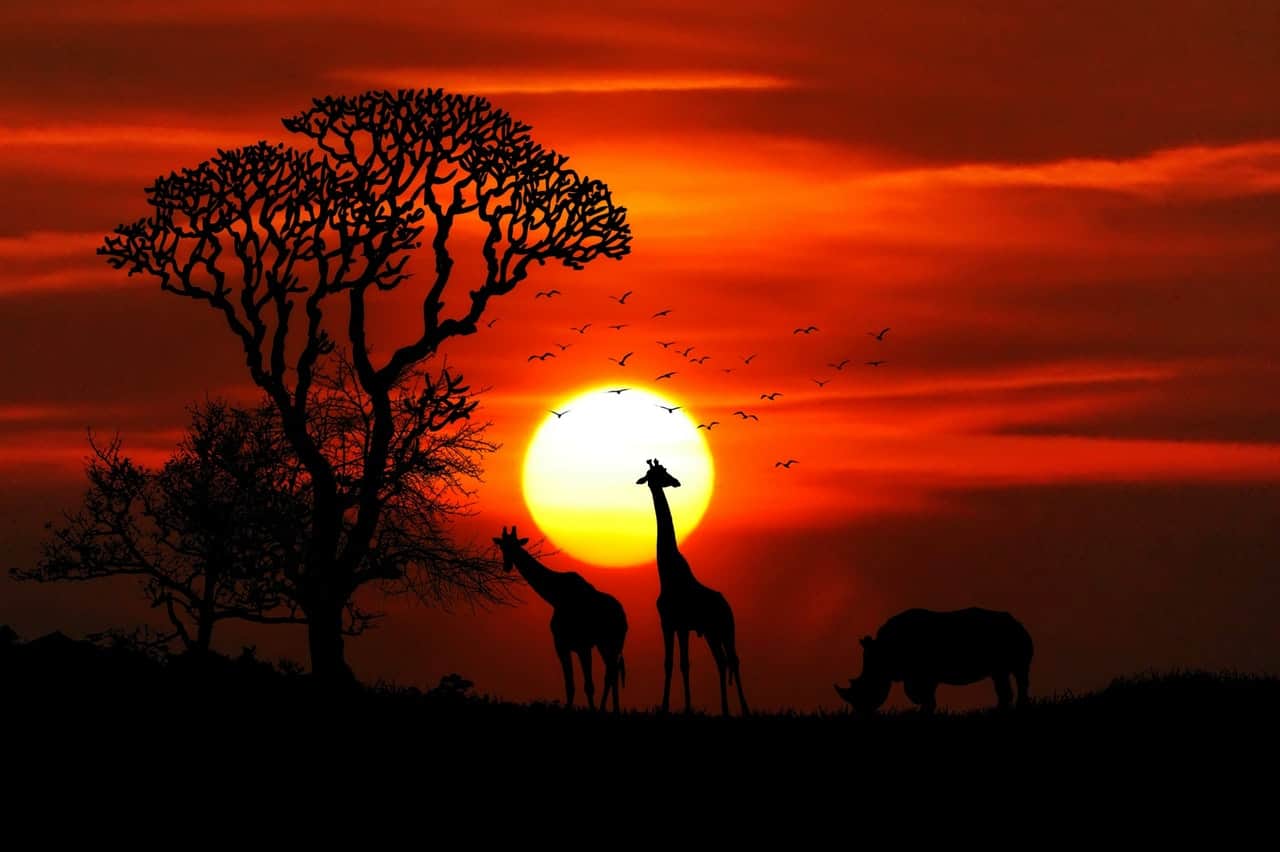
Table of Contents
*This post may contain affiliate links. As an Amazon Associate we earn from qualifying purchases.
Learning, Surviving And Thriving On Your First African Safari
First of all, way to go! Look at you, making African safari plans as your next holiday getaway. How adventurous and worldly of you!
However, seeing safari animals for the first time, live, in person and right there in front of you with no zoo glass in between is a life-changing event that you need to be prepared for in more ways than one.
Don’t worry. We’ve got you covered!
Below you’ll find a beginner’s comprehensive guide to all things “safari.”
Grab your backpack and binoculars and let’s get movin’!
Nants Ingonyama Bagithi Baba!
Does that ring a bell?
If you’re not familiar with what a safari is, then just think Lion King — only safer, and with no animals talking.
A safari technically means a journey, usually by vehicle, in Africa. Believe it or not, even the word “safari” means journey in Swahili.
Let’s Get Into It
So, when did these journeys first start?
Well, as it turns out, many years ago the first safaris were focused on trading and traveling (aka journeying) through the land.
While it is true that they had guides to get them through the wilderness safely, the main purpose wasn’t to see safari animals like it is today.
It’s safe to say that safaris have always been a profitable business model that has a tendency to attract a wide array of people from many countries and distant lands.
Go Here; Trust Us
African safaris to add to your bucket list.

Fly-in Safaris
A guide to fly-in safaris in africa.
By definition, ‘ fly-in safaris ’ refer to the fact that your transfers to and from your final safari destination will be by plane rather than road. Fly-in safaris are a much more convenient and time-saving option, maximising your time on the ground and allowing you access to remote, off the beaten track parts of Africa Although typically more expensive than a drive-in trip, it can well worth spending the extra cash for such a sensational trip.
Typically, a fly-in safari package will include flights via a small Cessna or Caravan aircraft from the international airport where you first land – and the journey across beautiful landscapes on a tiny plane is a unique experience in itself. You’ll head out into the bush by air, sometimes landing on just a dirt airstrip in the middle of the wild, which adds another edge to the spirit of adventure. This is a really fantastic way to see the wilderness and you’ll get some awesome views from the air on the way.
Here, you’ll be met by a representative from your camp or lodge for a short to the accommodation to get settled in before getting stuck into game drives and the fun activities. At the end of the trip, you’ll transfer back to your departing airport by light aircraft, or choose to travel onwards to another camp on your itinerary, anywhere in Africa!
A fly-in safari is perfect for travellers who only have a few days to see the wild. Swap hours of tedious travel in a car for a short transfer flight and you’ll be saving all that time up to spend on game drives and at your camp where the real safari adventure lies. With a fly-in option, safari holidays don’t need to be epic 12 or 14-day vacations – you can see and do everything in a short break of three or four days.
If you do have plenty of time for a safari, a fly-in trip can also allow you to travel vast distances between different camps for more than one adventure on your holiday. Don’t limit yourself to one national park or even one country! Many fly-in safari packages allow you to cross borders and hundreds of miles for a really complete experience.
Another advantage of flying in is the destination – you can experience remote areas that would otherwise be inaccessible by jeep. Get away from the crowds and back to nature, right out in the bush. You can’t beat a sundowner looking out from your camp or lodge with nothing but the wilds of Africa in sight, stretching for miles over the horizon.
Top Fly-in Safari Destinations
Okavanga Delta
Experience the diversity and beauty of a Botswana safari with a trip to the Okavanga Delta and Linyanti. You’ll also get an amazing view from the skies over this unique area – the largest inland river delta in the world. If you have more time, you can also fly into South Africa for an extended trip.
Victoria Falls
Combine exploring national parks in Botswana with a transfer to Victoria Falls from Kasane for breath-taking views of the waterfall from your light aircraft. Spend the night here, with a trip on a boat the next day to get closer to the falls.
Central Africa
One of the advantages of a fly-in safari is that you can cover lots of ground in a short space of time. In just seven or 10 days, you could explore Zambia and Malawi on safari, combining a relaxing stay on Lake Malawi with game drives, boating and walking expeditions for a diverse experience.
The contrasts of landscape across Namibia make this one of the best choices for a fly-in trip. Take in the beauty of the scenery from the air, passing over Sossusvlei and the Namib Desert, as well as the coast and Swakopmund.
Tips for Fly-in Safaris
- Even short trips of two or three days can be arranged with fly-in transfers.
- Beware that the price will be a lot higher for this kind of safari – typically $200 to $500 more per person than a drive-in trip.
- Work out the balance of cost against time saved on the ground for the best value for money – an eight or 10-hour drive can be covered in less than two hours by plane.
- For maximum flexibility, look into a private tour for your family, or even as a couple.
- As with all package deals, check what’s included before you book – excursions, meals and drinks can incur high costs at the lodge itself.
- Remember that light aircraft are used for the transfer, which are very different from a jet – and not recommended for travellers with a fear of flying!
- There will be limited cargo and cabin space on small planes – check the possible restrictions on weight and dimensions to ensure you don’t overpack.
- If you need to save on a long trip, try a fly-drive hybrid safari where you travel by land vehicle between destinations but fly in and out from the major airport.
More Fly-In Safari Resources
- Fly-in safaris options throughout East and Southern Africa.
- Skeleton Coast, Namibia : Experience shipwrecks in the desert, it’s a little eerie but fascinating at the same time. Not a lot of wildlife viewing on this tour.
- Over the Waters of Africa is a unique flying safari hosted by bush pilot Tim Lapage .
- Botswana Fly-in safaris : A good way to get around quickly and some of the best camps are only accessible by air.
Safari inspiration
- Canoe Safaris
- Desert Safaris
- Family Safaris
- Fly In Safaris
- Gorilla Safaris
- Honeymoon Safaris
- Horseback Safaris
- Hot Air Balloon Safaris
- Jungle Safaris
- Luxury Safaris
- Night Safaris
- Photo Safaris
- Self Drive Safaris
- Walking Safaris
Safari guides by country
- Botswana safaris
- Kenya safaris
- Namibia safaris
Rwanda safaris
- South Africa safaris
- Tanzania safaris
- Uganda safaris
Zimbabwe safaris
African safari companies
Botswana safari companies
Kenya safari companies
Namibia safari companies
Rwanda safari companies
South Africa safari companies
Tanzania safari companies
Uganda safari companies
Top countries for safaris
Safari basics.
- Safari animals
- How to find the right safari company
- When to go on safari
- What to take on safari
- Safari clothing – what to wear
- Safari rules & etiquette
- Wildlife spotting tips
Most read articles
- All about the ‘big five’ animals
- Collective nouns for animals
- Safari movies to watch before you go
- The world’s fastest land animals
- Apex predators
- 10 Fascinating African tribes
- The biggest animals in the world
- 17 Epic hybrid animals
- The world’s ugliest animals
- Why are flamingos pink?
Africa’s best game reserves
- Chobe National Park, Botswana
- Etosha National Park, Namibia
- Kruger National Park, South Africa
- Masai Mara National Reserve, Kenya
- Moremi Game Reserve, Botswana
- Okavango Delta, Botswana
- Serengeti National Park, Tanzania
Session expired
Please log in again. The login page will open in a new tab. After logging in you can close it and return to this page.

Why is it called a game drive?
What is the difference between a game drive and a safari, receive photography and travel tips.
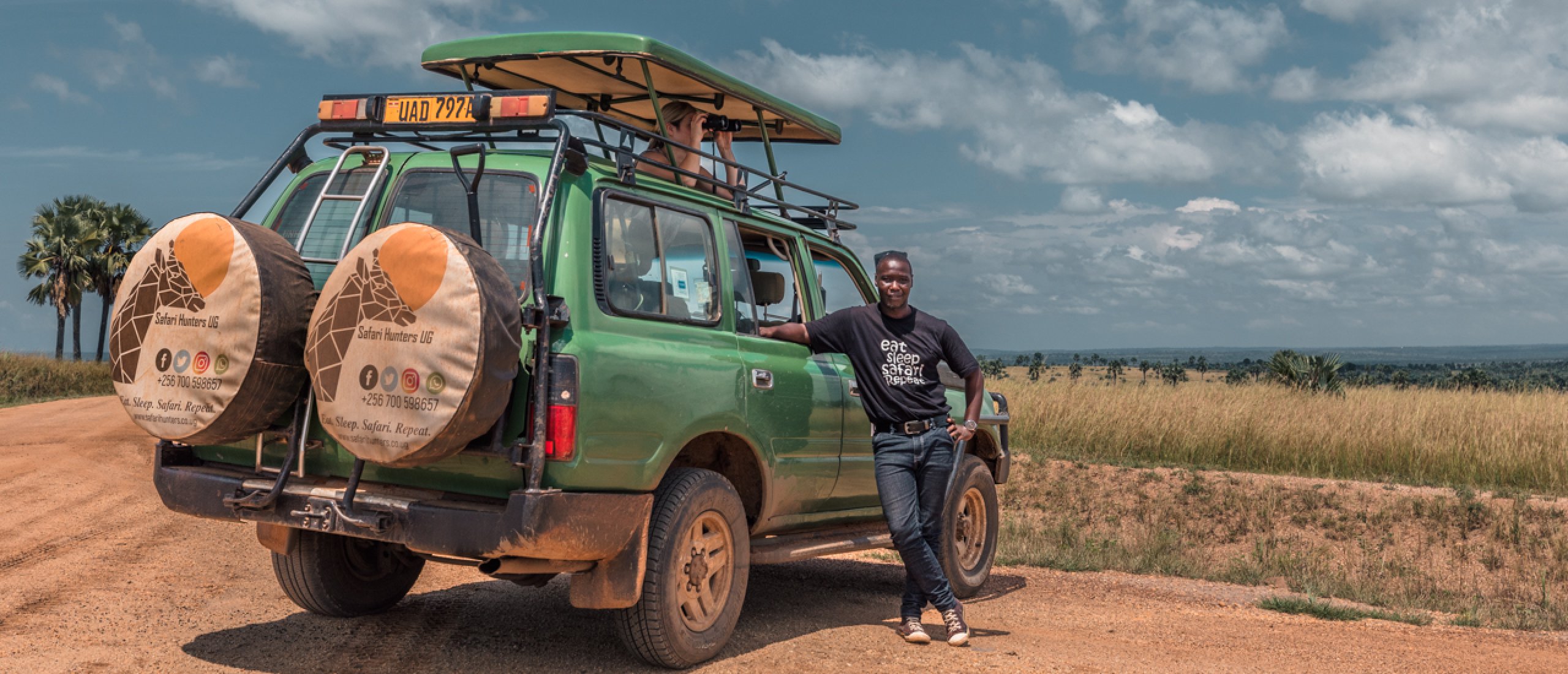
What is a game drive on safari? A definition
The definition of a game drive on safari is: ‘a guided excursion or self-drive by (preferably 4 wheel drive) open-sided safari vehicle in a National Park, reserve, or conservancy to spot and observe African wildlife and birdlife in their natural habitat.’ A game drive (sometimes written as ‘gamedrive’) is one of the most popular ways to see wildlife in Africa from the comfort of a 4X4 safari vehicle. Other activities that are part of wildlife tourism are walking safaris , boat safaris, horseback safaris, and balloon safaris . All of them have their own charm and offer the chance of spotting wildlife, but safari game drives are the most common, and the chances of having spectacular sightings are the highest!
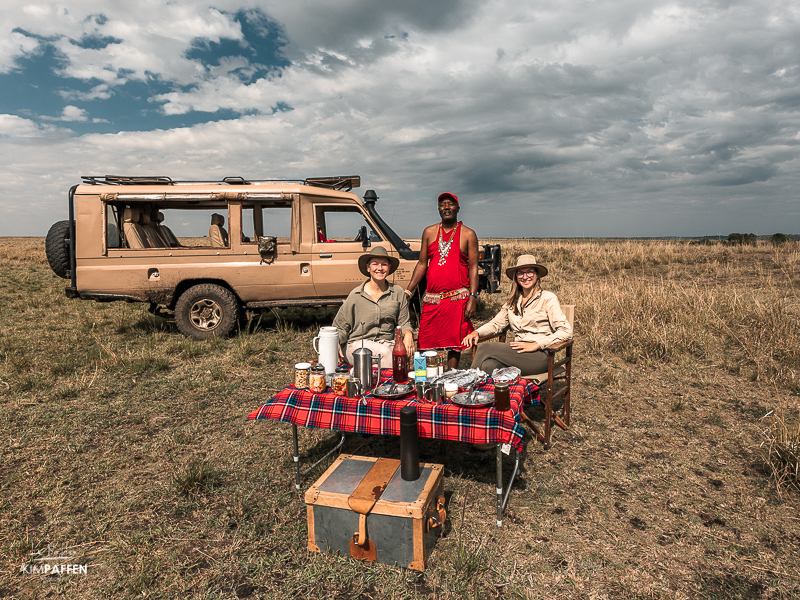
The word ' game ' in 'game drive' refers to wild animals or wildlife. This term originally comes from the hunt on the most difficult and dangerous animals in Africa on foot. This is also how the term ‘ Big Five ’ game animals were coined. Nowadays, the term 'game' refers to the game of finding and spotting animals in the wild and the term 'Big Five' is used to describe the top five animals to see on a safari game drive . The word drive obviously refers to the drive in a vehicle. You, a driver, or a private guide will be driving the 4WD vehicle searching for wildlife.
If you thought a safari is the same as a game drive, you're wrong. Basically, you can't go on safari in Africa without going on a game drive! Safari is a Swahili word meaning journey , but it’s also used to refer to the activity of seeing wildlife in Africa. The term game drive is clearly referring to the excursion of seeing African wildlife as explained above.
The difference between a safari and a game drive is that a safari means the whole trip or itinerary and a game drive is an activity or excursion part of that safari itinerary where wildlife viewing is the main focus of the trip. For example; you are going on a safari for seven days, which includes 8 game drives. If a trip involves days without animal viewing, it’s for example a 7-day trip to Kenya , including a 3-day safari in the Masai Mara . This 3-day safari can include several morning or afternoon game drives, but also a safari walk.
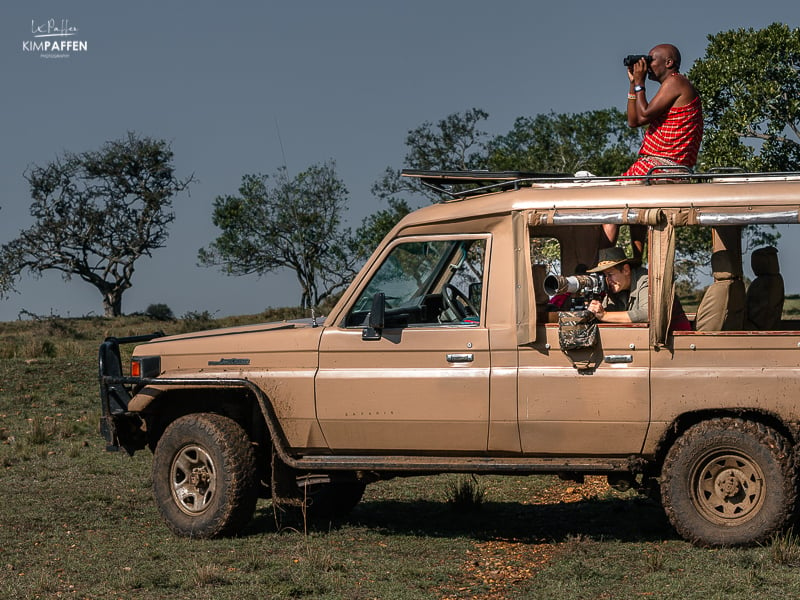
RELATED: What to expect on a game drive in Africa including important things you need to know to make the most out of your game drive!
What is a game drive as part of your Africa safari itinerary? Pin this article for later use!
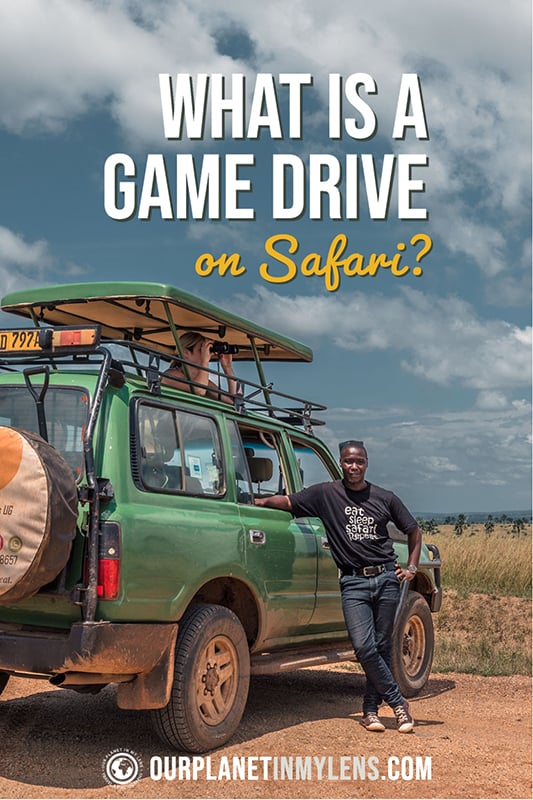
- 1x Each Month! A newsletter with free photography & travel tips to help you make the most out of your trip
- Be the first to know about giveaways, for instance, free ebooks and downloadable travel images
Yes, I want to receive the newsletter 1x p/month
- Motorcycles
- Car of the Month
- Destinations
- Men’s Fashion
- Watch Collector
- Art & Collectibles
- Vacation Homes
- Celebrity Homes
- New Construction
- Home Design
- Electronics
- Fine Dining
- Aston Martin
- L’Atelier
- Les Marquables de Martell
- Reynolds Lake Oconee
- 672 Wine Club
- Sports & Leisure
- Health & Wellness
- Best of the Best
- The Ultimate Gift Guide
- You Can Now Drive a Porsche Through 5 African Countries With This New Off-Roading Experience
Speed across the continent in a souped-up 911, Cayman, or Cayenne with a convoy of petrolheads.
Rachel cormack.
Digital Editor
Rachel Cormack's Most Recent Stories
- Forget a Crow’s Nest. This 207-Foot Explorer Yacht Concept Has Its Own Pop-Up Observatory.
- American Magic Just Unveiled Its Sleek New America’s Cup Race Boat
- Share This Article

Kalmar Beyond Adventure is giving the Dakar Rally a run for its money.
Related Stories
A bevy of luxury resorts is about to transform this quiet costa rica province.
- Dubai Just Got 3 New Luxe Hotels. Here’s a Look Inside.
What Venice’s New Tourist Tax Means for Your Next Trip

The driving itself will be as diverse as the landscape. Some days will require precise steering, while others will demand breakneck speed. Similarly, you’ll spend some time traveling in a convoy and other times solo. Each driver has to pass a short qualification test to ensure they’re up to the task.
Kalmar says guests will catch Zs in “superb accommodation,” including some of Africa’s finest lodges and villas. You’ll also have ample opportunities to experience the local cultures, cuisines, sites, and wildlife. Highlights include Victoria Falls, the local markets, and the game reserves.
“Trans-Africa 2025 will be the adventure trip of a lifetime,” Kalmar said in a statement. “It allows guests to explore new frontiers, get close to wildlife, and under the skin of the real Africa—all through the windscreen of an iconic Porsche sports car.”
The Trans-Africa adventure starts from €66,900 (roughly $71,600) plus taxes. For more information, visit the Kalmar Beyond Adventure website .
Click here to see all the photos of the Porsche Safari.

Rachel Cormack is a digital editor at Robb Report. She cut her teeth writing for HuffPost, Concrete Playground, and several other online publications in Australia, before moving to New York at the…
Read More On:
More destinations.

How Climate Change Could Disrupt the Future of Travel, According to a New Study

A New High-Speed Train Between Las Vegas and California Breaks Ground This Week

Culinary Masters 2024
MAY 17 - 19 Join us for extraordinary meals from the nation’s brightest culinary minds.
Give the Gift of Luxury
Latest Galleries in Destinations
Kalmar beyond adventure’s porsche safari in photos.

Oceaya in Photos
More from our brands, san francisco casts lens on art, fashion and activism, vince mcmahon lists final tko shares for sale, ‘mother play’ brings jessica lange back to broadway in a family tale that blends humor with ‘wicked darkness’, warm up a room with the best tungsten light bulbs, the best yoga mats for any practice, according to instructors.
US issues level 3 travel advisory to China amid safety concerns. Here's what to know

Are you thinking about traveling to China to visit or study abroad? The U.S. government suggests reconsidering your trip for now.
According to the U.S. Department of State , traveling to China is under a level 3 travel advisory , warning Americans to reconsider. The State Department has four warning levels. The fourth is “Do not travel.”
Is it safe to travel to China right now?
The U.S. is asking Americans to reconsider traveling to China due to various reasons, including concerns about health and safety, such as the prevalence of contagious diseases like COVID-19, as well as political tensions or security risks in certain regions.
As of April 12, there are some specific areas that the U.S. is asking people to reconsider travel to. Those areas include:
- Mainland China due to the arbitrary enforcement of local laws, including exit bans and the risk of wrongful detentions.
- Exercise increased caution when traveling to the Hong Kong SAR due to the arbitrary enforcement of local laws.
- Reconsider travel to the Macau SAR due to a limited ability to provide emergency consular services.
Additionally, the U.S. government may issue travel advisories based on factors like civil unrest, natural disasters, or other hazards that could affect travelers' well-being.
Americans detained in China
Mark Swidan — a man from Houston, Texas — has been detained in China for over 10 years on drug charges. According to The Texas Tribune , Swidan was detained in China in 2012 while on a trip looking for materials for his home and business in Houston. Chinese authorities arrested him after his driver and translator were found in possession of drugs. The driver blamed Swidan, who is accused of trafficking and manufacturing methamphetamine.
A review of Swidan’s case said there were no drugs on him or in his hotel. Last year, the Republic of China’s Jiangmen Intermediate Court denied Swidan’s appeal and upheld his death penalty with a two-year suspended death sentence.
Other Americans considered wrongfully detained include Chinese American businessman Kai Li from Long Island, N.Y., and California pastor David Lin.
What countries have a Level 3 travel warning?
- Trinidad & Tobago
- El Salvador
- South Sudan
- Democratic Republic of the Congo
- Papua New Guinea
- Saudi Arabia
What countries have a Level 4 travel warning?
- Afghanistan
- Central African Republic
- North Korea (Democratic People's Republic of Korea)
- Burkina Faso
Traveling abroad? Here are some safety tips
U.S. citizens are encouraged to enroll in the State Department’s free Smart Traveler Enrollment Program and to prepare contingency plans for emergencies.
Safety tips if you're traveling outside the U.S.:
- Don't travel alone.
- Be aware of your surroundings.
- Keep a low profile.
- Try not to be flashy.
- Avoid going to places at night, especially by yourself.
Post-Tribune | Gary non-profit buys historic…
Share this:.
- Click to share on Facebook (Opens in new window)
- Click to share on X (Opens in new window)
- Click to print (Opens in new window)
- Click to email a link to a friend (Opens in new window)

- Post-Tribune Sports
- Post-Tribune Opinion
- All Suburbs
Post-Tribune
Post-tribune | gary non-profit buys historic geter means home in means manor.

The legacy of the Geter Means mid-century modern home in a groundbreaking Black midtown neighborhood will continue after its sale to a local non-profit organization.
Indiana Landmarks said on April 24 it sold the ranch home to the Gary East Side Community Development Corp., a group that works to address workforce and housing needs.
Indiana Landmarks placed the home on its “10 Most Endangered List” in 2022 and purchased it in 2023.

Built in 1954 at 2044 Monroe St., the home suffered from a dilapidated roof and overgrown vegetation covered parts of the rear of the home. It was one of the few rundown, vacant homes in the Means Manor subdivision.
Indiana Landmarks worked with a neighborhood group called SayYesToMeans, made up of descendants of some Means Manor original homeowners, to improve the property.
Indiana Landmarks invested $100,000 to buy the Means house to clean it up, improve the grounds and add a new roof. The Gary East Side Development Corp. will continue the renovation work inside the home while determining a use that honors the property’s heritage.
“Being selected to finish the restoration work begun by Indiana Landmarks is crucial for the Gary East Side Community Development Corporation as it validates our efforts in restoring the Geter Means house,” said Marlon Mitchell, executive director of the non-profit.
“This recognition not only acknowledges our hard work but also fuels our commitment to serving as a catalyst in transforming historic properties and contributing positively to the Midtown community’s development.”
From a modest beginning, Andrew and Geter Means, and Andrew’s wife Katie, established Means Construction in the 1920s.
By the 1950s, Means Brothers Construction grew into one of the largest Black-owned real estate companies in the Midwest, constructing almost 2,000 homes and rental units in Gary alone.
In the 1950s as large swaths of Gary neighborhoods remained segregated, Andrew Means built sturdy brick bungalow homes in the shadow of Gary Roosevelt High School and supplied promissory notes to help Black buyers offset costs because they were denied mortgages by local banks.
The Means brothers also lived in the subdivision, each in mid-century modern homes. Andrew Means’ home is occupied and well-kept.
Andrew Means, who died in 1973, became a Gary civic and civil rights leader as well as the driving force behind the construction company. He gained his leadership and business acumen from mentors George Washington Carver and Booker T. Washington at the Tuskegee Institute where Means graduated in 1918.
He and wife Katie placed their Means Manor home on the Green Book, a travel guide for Blacks during the segregation era that identified businesses and homes that welcomed them, if hotels shunned them. Entertainer Josephine Baker was among their guests.
Recently, Yejide Ekunkonye, who lives in her grandparents’ Means Manor home, began the process of applying for Means Manor to be on the National Register of Historic Places.
“It was a special place. My grandfather made sure we knew that,” she said in a previous interview about her project.
The East Side Development Corp. was founded in 2017 by Marlon Mitchell and Scott Upshaw to tackle the workforce and housing needs in Gary, growing its outreach to address emerging social, economic, cultural, and educational needs of the diverse communities in the Northwest Indiana area. For more information, visit gescdc.org.
Carole Carlson is a freelance reporter for the Post-Tribune.
More in Post-Tribune

Post-Tribune | Gary woman gets 25 years for role in Calumet Township bank robbery where guard from Tinley Park killed

Post-Tribune | U.S. Steel air permit hearing draws a crowd

Post-Tribune | Merrillville tow truck driver convicted in murder

Post-Tribune | Backlash continues in Hammond as some students walk out of school
Trending nationally.
- A woman had a hysterectomy. She claims her co-workers harassed her about a ‘sex change’
- 20 least-affordable US cities to buy a home are all in California
- High school athletic director used AI to fake racist recording of principal, police say
- Disneyland adds another potential themed land to the mix: Encanto
- Barbra Streisand drops first new song in 6 years in response to rise in antisemitism
Airlines must cough up cancellation cash and can no longer hide fees under new federal rule
A federal rule announced Wednesday will require airlines to quickly give cash refunds — without lengthy arguments — to passengers whose flights have been canceled or seriously delayed, the Biden administration said.
“Passengers deserve to get their money back when an airline owes them — without headaches or haggling,” Transportation Secretary Pete Buttigieg said in a statement.
The rule from the Transportation Department says passengers who decline other reimbursement like travel credits are to get cash refunds.
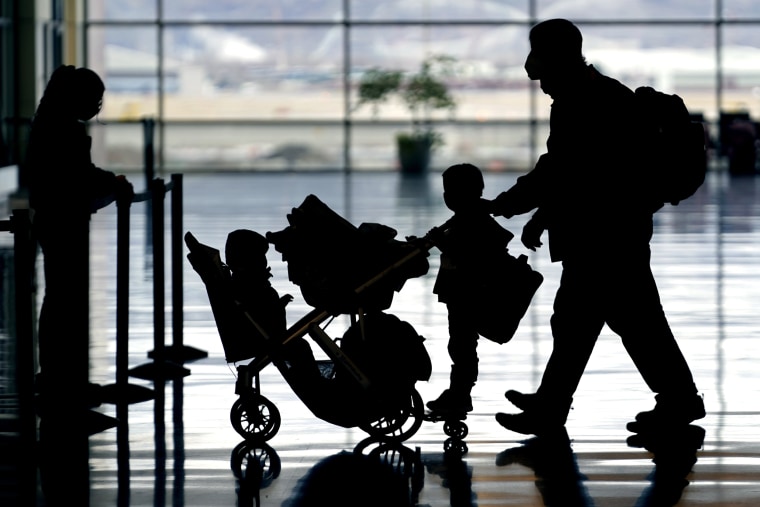
It applies when a flight is canceled or has a “significant change,” the administration said.A “significant change” includes when departure or arrival times are three or more hours different from the scheduled times for domestic flights or six hours for international flights, and when the airport is changed or connections are added, it said.
Passengers are also to get refunds when their baggage is 12 hours late in delivery for domestic flights.
The new rule comes after promises to hold airlines accountable after major disruptions that made travel hell for passengers, including the 2022 Southwest Airlines meltdown , which resulted in almost 17,000 significantly delayed or canceled flights and a missing baggage nightmare.
The Transportation Department said that the new rule means refunds are automatic and that "airlines must automatically issue refunds without passengers having to explicitly request them or jump through hoops."
Also announced Wednesday was a rule requiring airlines to more clearly disclose so-called junk fees upfront, such as surprise baggage or other fees, the department said.
It said that rule is expected to save fliers around $500 million a year.
The surprise fees are used so tickets look cheaper than they really are, and then fliers get the unwelcome surprise of fees on checked bags, carry-on bags or reservation changes — or even discounts that are advertised but apply to only part of the ticket price, officials said.
Airlines will also have to tell fliers clearly that their seats are guaranteed and that they don't have to pay extra to ensure they have seats for flights, according to the Transportation Department.
Airlines for America, an industry trade group, said that its member airlines “offer transparency and vast choice to consumers from first search to touchdown” and that they do offer cash refunds.
The 11 largest U.S. airlines returned $10.9 billion in cash refunds last year, an increase over $7.5 billion in 2019 but slightly down from $11.2 billion in 2022, the group said.
“U.S. airlines are providing more options and better services while ticket prices, including ancillary revenues, are at historic lows,” Airlines for America said.
Left out of the federal changes announced Wednesday are those involving "family seating fees," but the Transportation Department said in a statement that "DOT is planning to propose a separate rule that bans airlines from charging these junk fees."
Travelers have complained to the Transportation Department that children weren’t seated next to accompanying adults, including in some cases young children, department officials said last year.
Fees on bags specifically have made up an increasing amount of airline revenues, the Transportation Department said Wednesday in announcing the new rules.
A Transportation Department analysis found that airline revenue from baggage fees increased 30% from 2018 to 2022, while operating revenue — which is from the flights themselves — increased by only half that amount, the department said.
Jay Blackman is an NBC News producer covering such areas as transportation, space, medical and consumer issues.
Phil Helsel is a reporter for NBC News.

COMMENTS
A safari ( / səˈfɑːri /; from Swahili safari 'journey' originally from Arabic Safar 'to journey') is an overland journey to observe wild animals, especially in Southeast Africa. [1] [2] [3] The so-called "Big Five" game animals of Africa - lion, leopard, rhinoceros, elephant, and Cape buffalo - particularly form an important part of the ...
This word translates to "journey, trip"and has its roots in the Arabic word "safar.". In nations where Swahili is spoken, the phrase can apply to any kind of trip. The expression "safari njema!" is even more widely used! It's a desire for safe and enjoyable travel. THE HISTORY OF AFRICAN SAFARIS.
Safari Hat: A good hat is both stylish and functional. Safari Bag: A durable bag is ideal for traveling around Africa. Safari Pants: We recommend neutral-colored pants as they're great at hiding dirt and can match most shirt colors. Safari Shirt: Shirts like these are lightweight and keep the bugs away!
The word "safari" is derived from the Swahili word "safar," which means journey or travel. Originally used by hunters, a safari now refers to a guided trip or expedition to observe and appreciate wildlife in their natural habitats. Safaris can take many forms, from walking safaris to hot air balloon safaris, and can be tailored to suit ...
Green means go. While every luxury safari offers unforgettable wildlife encounters, there are plenty of options to consider. High-end African trips and settings vary hugely in their atmosphere and ...
The meaning of SAFARI is the caravan and equipment of a hunting expedition especially in eastern Africa; also : such a hunting expedition. How to use safari in a sentence. ... while those searching for a once-in-a-lifetime adventure may want to book an African safari. — Claudia Fisher, Travel + Leisure, ...
A SAFARI is an exciting and adventurous way of seeing the 'real Africa' because it enables you to view a variety of wildlife in their natural habitat. As a result, going on a safari gives you an authentic experience of Africa. Safaris can involve walking through the wilderness, driving in 4×4 vehicles or by flying in light air craft.
Safaris are perhaps the greatest tourism draw in Africa and the highlight for many visitors. The term safari in popular use refers to overland travel to view the stunning African wildlife, particularly on savanna.There are also "primate safaris" and safaris in forests/jungle. Most countries have at least one national park offering visitors the opportunity to go "on safari", except in North ...
In Swahili, safari means "long journey ... Perfect for a first-time safari. Travel Guides. Lonely Planet - There's both an East Africa and Southern Africa multi-country guide by the LP. If you like the Lonely Planet style then these are good travel companions. I wouldn't recommend their Africa guidebook as it squeezes over 50 countries ...
Safari vacations travel guide. 'Safari' means 'journey', and the word itself has travelled - first from the Arabic safar and safariya, through to the Swahili safari. This East African word has come to define the ultimate African vacation as we know it today, and conjures up images of khaki-clad travelers in the savannah, wielding binoculars ...
Safari travel is an adventurous form of tourism that entails exploring the countryside and seeing wildlife in its natural setting. In Swahili, the word "safari" means "journey" or "expedition.". Safari vacations have their roots in the nineteenth century when European explorers and hunters entered Africa in pursuit of rare creatures.
Yellow Fever vaccination card. COVID-19 vaccination card (CDC cards were accepted in both countries) First things first: Make sure your passport has six months of validity past your arrival date in Africa. Kenya and Tanzania both require travelers to have six months of passport validity to enter the country.
What does the word safari mean? (the origins of safari) The word 'safari' originates from the Arabic word 'safara' which means 'a journey'. The Arabic word was later adopted by the Swahili of East Africa and adapted to become the Swahili word 'safariya' which means 'journey' or 'kusafiri' which means 'to travel'. The English word 'safari ...
The word "safari" itself comes from Swahili - the main language of the people of East Africa. It means "journey, trip" and goes back to the Arabic word "safar" with the same meaning. In Swahili-speaking countries, the term refers to any journey. There is even a common phrase, safari njema! It is a wish for a good and pleasant journey.
The meaning of 'Safari'. Safari is a Swahili word that means 'journey'. It originally emerged from the Arabic noun 'safar', which means travel, journey, or trip. The verb 'to travel', when translated in Swahili, is 'Kusafiri'. In its original context, safari referred to the long travel distances people would undertake for ...
Originating from the word 'safar', an Arabic verb meaning 'to make a journey', safari describes an overland journey to observe wild animals. Safari Vehicle: Large open-sided 4X4 vehicles that are modified according to specific regulations that ensure the safety and comfort of visitors on safari. They allow you to traverse the African ...
SAFARI definition: 1. an organized journey to look at, or sometimes hunt, wild animals, especially in Africa: 2. an…. Learn more.
safari: 1 n an overland journey by hunters (especially in Africa) Synonyms: campaign , hunting expedition Type of: expedition a journey organized for a particular purpose
In the Swahili language, the word "safari" means "journey". Originally from the Arabic verb "safar" which roughly translated means "to make a journey". ... November 14th for a free travel event to learn more about the history of safaris, which will also show how you can make a difference for local communities and wildlife in Africa.
Safari njema [ sah-FAHR-ee en-JEM-ah] Safari means "to travel," and njema means "good." Safari njema roughly means "Have a nice trip!" Simba [ SIM-bah] "Lion." Twende [ TWEHn-deh] "Let's go." Your guide may say this whenever you're heading out for your next wildlife drive, meal or lodge. Common Locations in Tanzania
As we learned, safari means journey, and when people travel to Africa, they intend to spend seven to nine hours a day with a guide, in a vehicle, exploring the parks. Trust us, though … you won't get bored! Until you are mere feet away from a gorgeous, wild, safari animal, you won't know what we're talking about. via GIPHY
By definition, 'fly-in safaris' refer to the fact that your transfers to and from your final safari destination will be by plane rather than road.Fly-in safaris are a much more convenient and time-saving option, maximising your time on the ground and allowing you access to remote, off the beaten track parts of Africa Although typically more expensive than a drive-in trip, it can well worth ...
A definition. The definition of a game drive on safari is: 'a guided excursion or self-drive by (preferably 4 wheel drive) open-sided safari vehicle in a National Park, reserve, or conservancy to spot and observe African wildlife and birdlife in their natural habitat.'. A game drive (sometimes written as 'gamedrive') is one of the most ...
This New Porsche Safari Lets You Explore 5 African Countries in 19 Days Speed across the continent in a souped-up 911, Cayman, or Cayenne with a convoy of petrolheads. Published on April 25, 2024
According to the U.S. Department of State, traveling to China is under a level 3 travel advisory, warning Americans to reconsider. The State Department has four warning levels. The State ...
Andrew Means, who died in 1973, became a Gary civic and civil rights leader as well as the driving force behind the construction company. ... a travel guide for Blacks during the segregation era ...
The 11 largest U.S. airlines returned $10.9 billion in cash refunds last year, an increase over $7.5 billion in 2019 but slightly down from $11.2 billion in 2022, the group said.